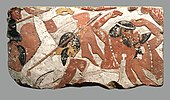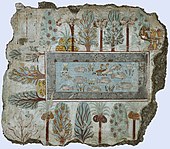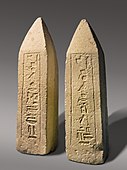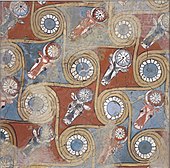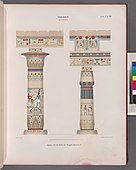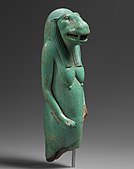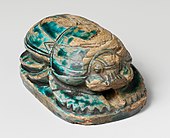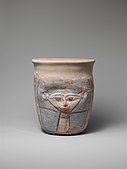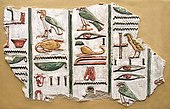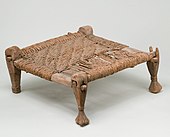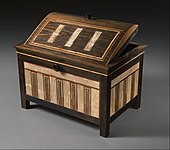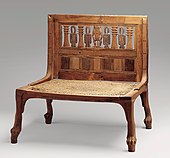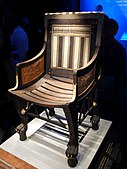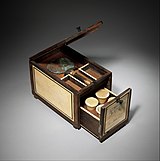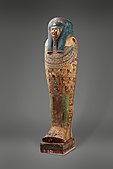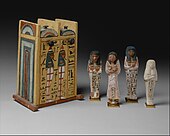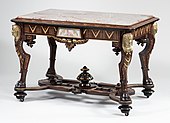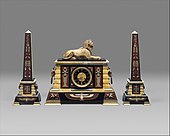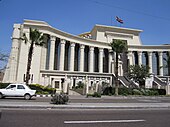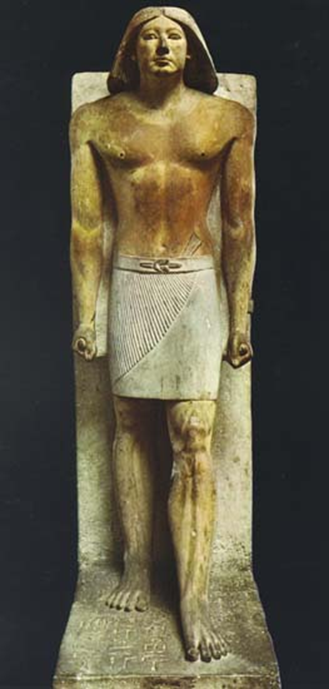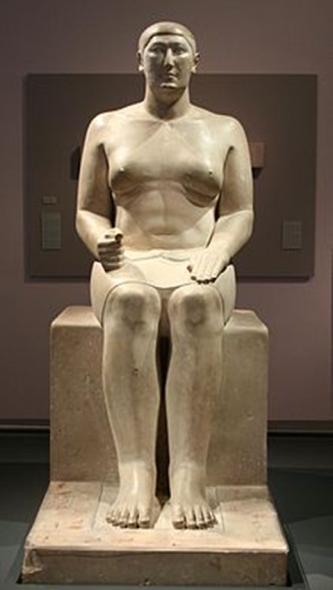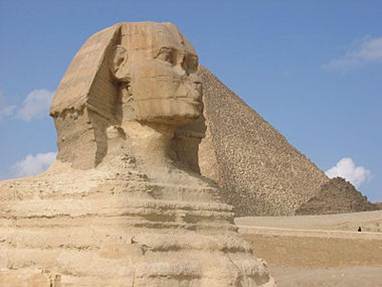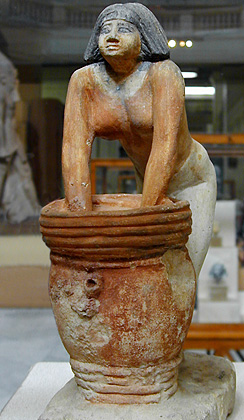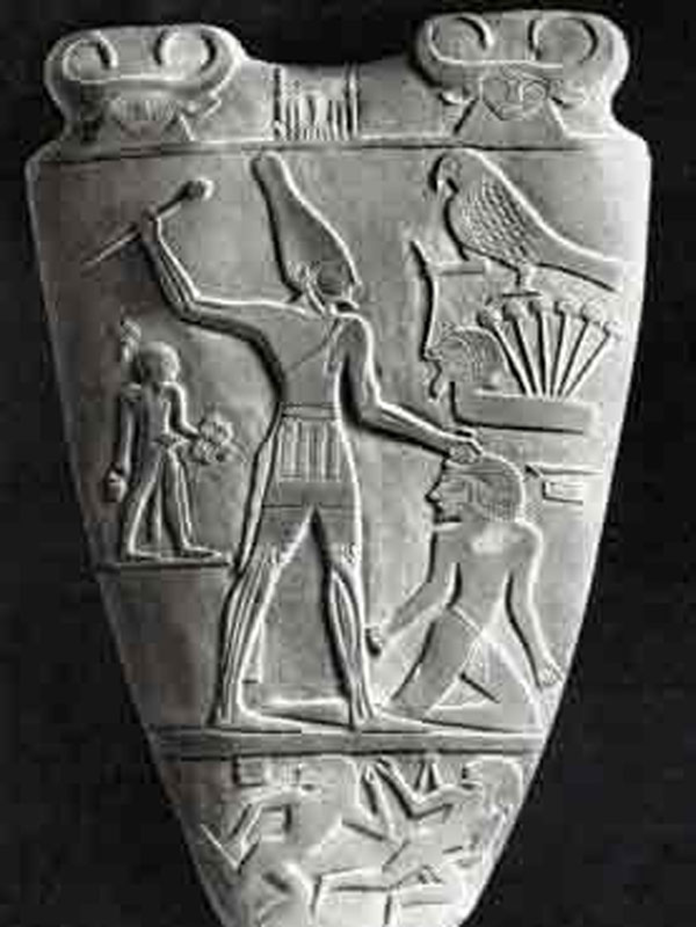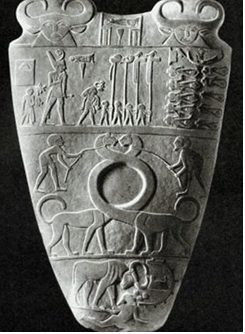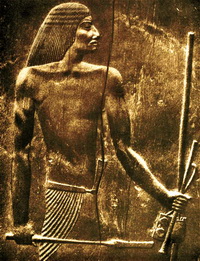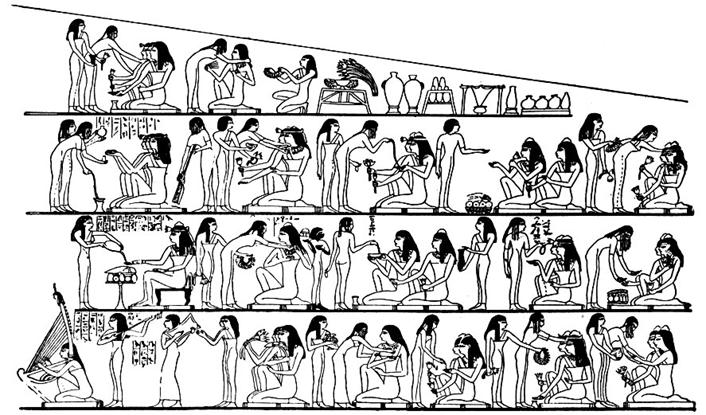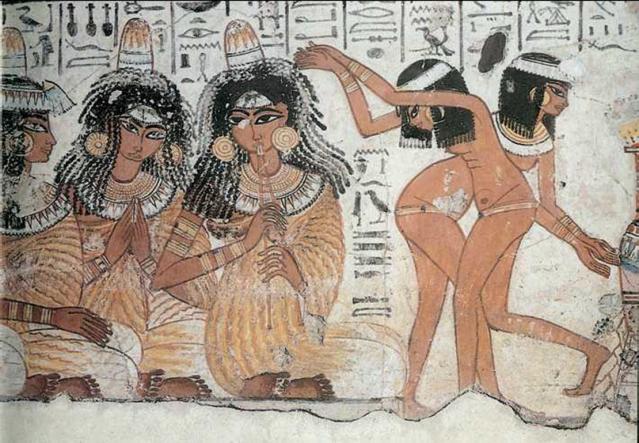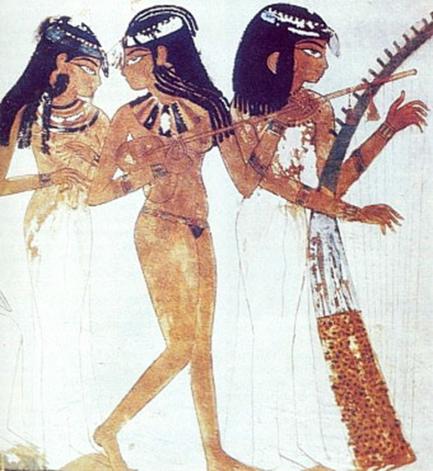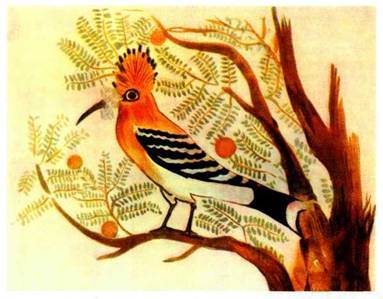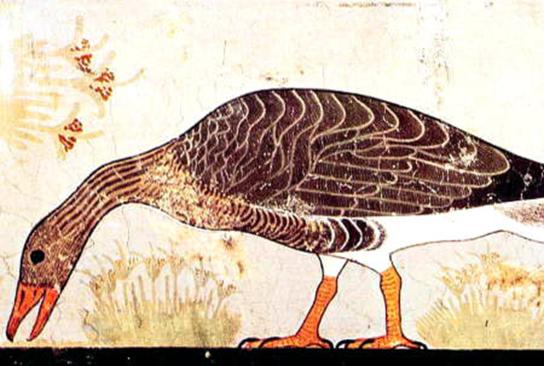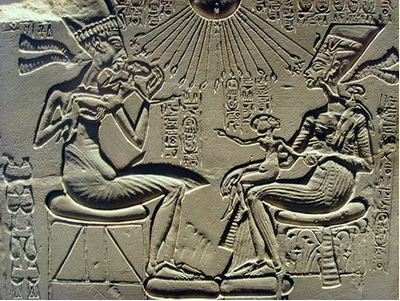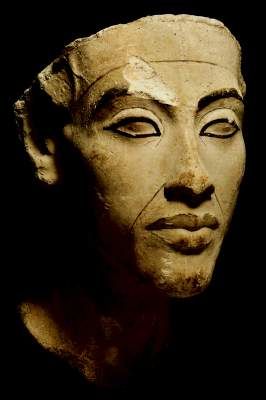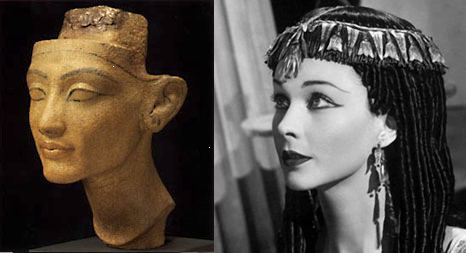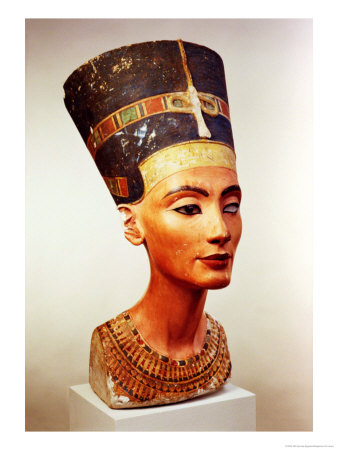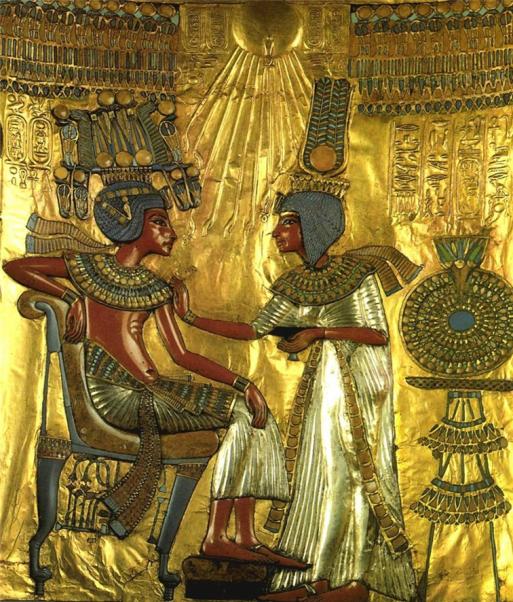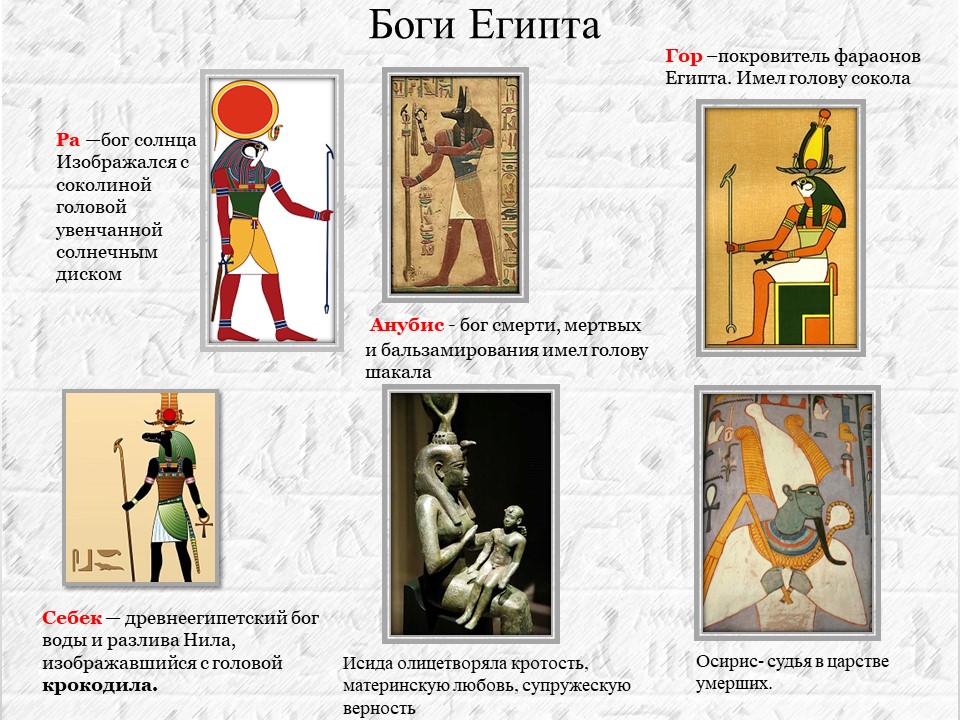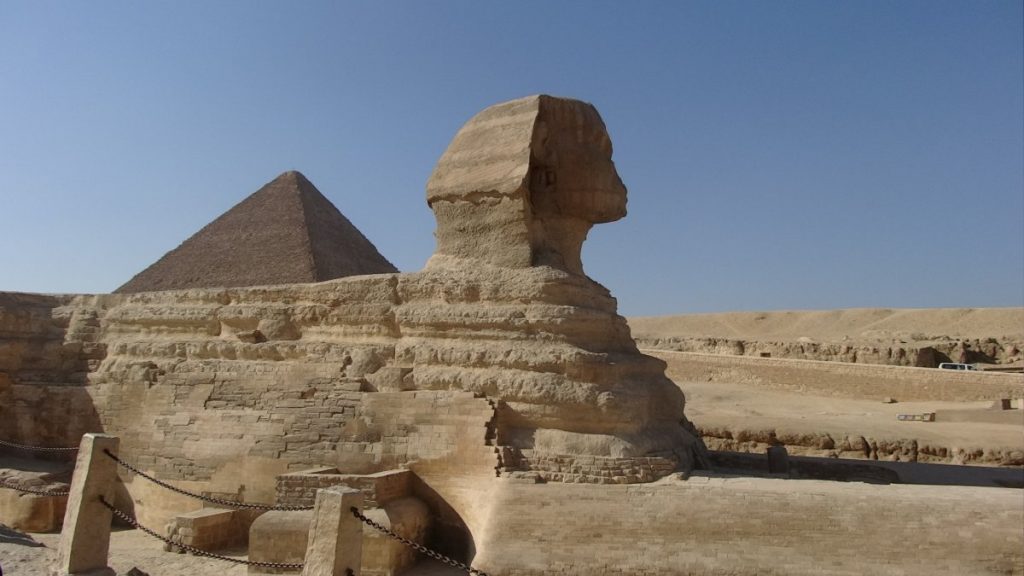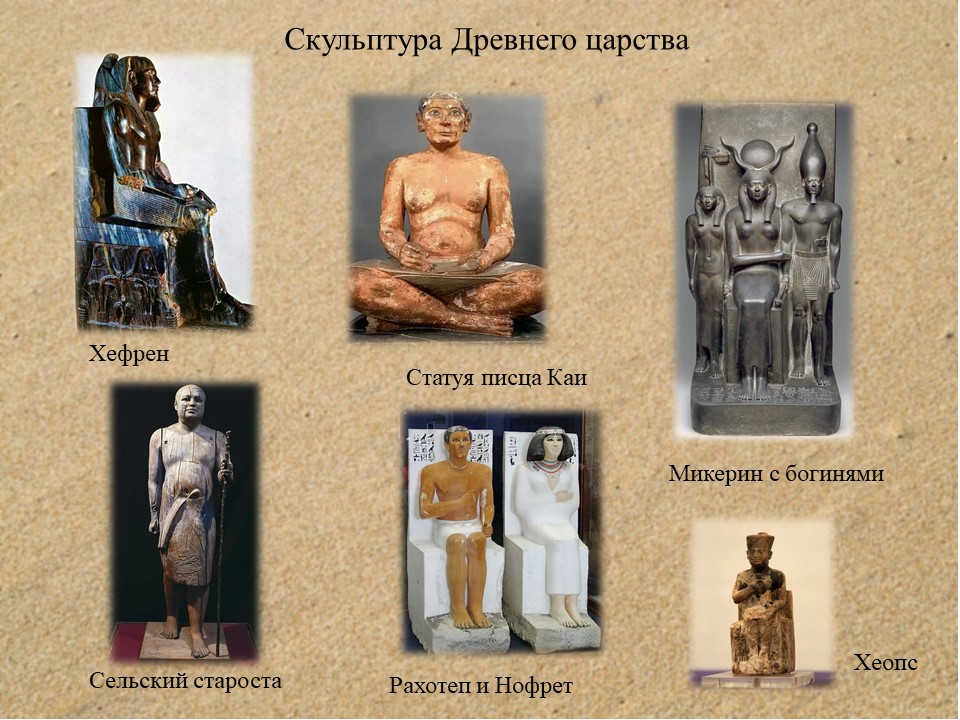Древний Египет — цивилизация, существовавшая с IV тыс. до н.э. до IV в. до н.э. Государство располагалось в Северо-Восточной Африке, в долине нижнего течения реки Нил. Древний Египет стал колыбелью высокоразвитой культуры, в дальнейшем оказавшей большое влияние на мировое искусство.
Особенности искусства.
Особенности искусства Египта тесно связаны с религией и мифологией того времени. Египтяне поклонялись различным божествам и верили в загробную жизнь. Считалось, что жизнь продолжается после смерти, если сохранить тело человека и его изображения. Поэтому скульптуры и живопись, изображающие людей, считались чем-то магическим. Даже само слово «художник» означало «творящий жизнь». В таких произведениях уделялось большое внимание портретному сходству и особенно изображению глаз и губ. Так же было важно обеспечить загробную жизнь всем необходимым. Для этого строили гробницы и украшали их богатой росписью, как символом изобилия и благополучия.
На протяжении всей своей истории, искусство Древнего Египта сохранило общую стилистику, следуя определённым правилам — канонам. Таким, как сочетание разных ракурсов (анфас и профиль) в одном изображении, схематическое изображение предметов, стандартные позы статуй фараонов. Эти традиции сформировались во время Древнего царства, которое, в представлении египтян, было эпохой порядка, установленного богами. В итоге, все предметы искусства того периода стали священным образцом для подражания.
Монументальность (массивность и величественность) — яркая особенность древнеегипетской скульптуры и архитектуры. Она была символом величия государства и фараона.
Периоды искусства Древнего Египта.
Принято выделять 3 периода развития древнеегипетского искусства.
- Искусство Древнего царства (XXXII — XXIV вв. до н. э.). В этот период на основе религиозных верований и ритуалов сформировались основные каноны создания предметов искусства. Именно в это время построены Великие Пирамиды и Большой Сфинкс.
- Искусство Среднего царства (XXI — XVIII вв. до н. э.). В эту эпоху власть фараона уже не считается божественной, появляется идея равенства после смерти. В результате изображения фараонов становятся более реалистичными, а гробницы упрощаются. Появляется новая форма захоронения — гробница, высеченная прямо в скале. Слабая центральная власть приводит к разобщению областей. В каждой из них самостоятельно развиваются разные художественные школы, появляется больше индивидуальности и разнообразия в искусстве.
- Искусство Нового царства (XVII —XI вв. до н. э.). Это время расцвета вновь единого и сильного Египетского царства. Все произведения искусства этого периода свидетельствуют о благополучии, процветании и величии. Архитектура снова становится монументальной, но вместо гробниц возводят величественные храмы. Скульптуры, живопись и рельефы отличаются изысканностью, художники стараются передать движение и эмоции в своих работах. Активно развивается декоративно-прикладное искусство — домашняя утварь и украшения того времени выполнены с большим изяществом. В этом периоде нужно уделить особое внимание правлению фараона Эхнатона. Именно в эти годы каноны искусства уступили реалистичности. Появились изображения фараона в бытовых сценах — за едой, во время общения с семьёй. Впервые стали изображать жену фараона отдельно от мужа. Стала развиваться литература — кроме гимнов во славу богам, обнаружено достаточно много любовной лирики того периода.
Виды искусства Древнего Египта.
Архитектура.
Самые значимые строения Древнего Египта это усыпальницы, дворцы и храмы. Главным материалом архитекторов Египта был камень и кирпич-сырец. Архитектурные формы были массивными, строго геометричными и однообразными. Чаще всего использовались формы пирамид, колонн и пилонов (усечённые пирамиды).
Скульптура.
Древнеегипетские изваяния изображали богов и фараонов. Изваяния имели магическое значение, олицетворяли сущность человека. Все скульптуры создавались по сложившимся правилам — симметричными, в традиционных позах, с обязательным портретным сходством.
Живопись.
Живопись Древнего Египта отличается плоскостным изображением фигур, чёткими контурами и яркими красками без полутонов. Использовались краски на основе различных вязких веществ и смол. Сверху роспись покрывали лаком или смолой для сохранности. Главной темой живописи были сцены из повседневной жизни египтян.
Литература.
Основными жанрами были заупокойные тексты, сказки, любовная лирика и поучительная литература. Заупокойные тексты должны были обеспечить благополучную жизнь в загробном мире. Сначала их наносили на стены пирамид, потом на саркофаги. В эпоху Нового царства ритуальные тексты, получившие название «Книга мёртвых», стали записывать на папирус.
Театр.
Театра в современном понимании, в Древнем Египте не было. Но во время праздников разыгрывались сценки на религиозные темы с музыкой и танцами.
Музыка.
Распространёнными инструментами были арфа, флейта и тамбурин. Изначально музыка была только аккомпанементом для певцов, но в период Нового царства стала развиваться, как самостоятельный вид искусства.
За время существования Древнего Египта сформировалась богатая, уникальная культура. Сохраняя традиционные основы, искусство развивалось в зависимости от политических и культурных условий. А после потери величия Египта, его традиционное искусство сплелось с греко-римским, чтобы оказать влияние на развитие следующей эпохи.
«Та-Мери – «Возлюбленная страна». Так называли свою землю древние египтяне. И у них были все основания любить свою страну и восхищаться ею. Уникальная природа позволила уже в глубочайшей древности возникнуть на берегах Нила очень ранней цивилизации. Эта цивилизация, развиваясь на протяжении многих веков, создала высочайшую культуру, подарившую человечеству замечательные произведения архитектуры, литературы, искусства».
Исторические, экономические и социальные условия формирования культуры Древнего Египта
Древний Египет! Узкая долина Нила среди безводных пустынь и голых скал. Более 90 % территории Египта занимает пустыня, так называемая «Красная земля». Жизнь там была возможна только в оазисах и в долинах высохших рек. Но благодаря разливам Нила земля эта была одной из плодороднейших в мире. Именно поэтому экономика Древнего Египта основывалась на сельском хозяйстве в плодородной долине Нила. Надо было только уметь задерживать воды и совершенствовать земледелие. Это требовало общих усилий, общей организованности, которые возможны только при сильном централизованном государстве.
В конце 4 тыс. до н.э., в то время когда Европа жила в каменном веке, в Северной Африке, в долине Нила уже созревала высокоразвитая цивилизация.
Древний Египет развивался в нижнем и среднем течении Нила.
Уже во 2 половине 2 тыс. до н.э., в период своего расцвета – в эпоху Нового царства, власть фараонов простиралась до четвертых нильских порогов на юге и распространялась на значительные территории в Восточном Средиземноморье, а также на побережье Красного моря.
Весь Египет с раннединастического периода делился на две больших области: Верхний и Нижний Египет. А эти, в свою очередь, имели по несколько десятков областей, которые греки назвали номами.
Древняя египетская империя в период Нового царства (1450 г. до н.э.)
Верования египтян и их отражение в искусстве.
Древние египтяне, как и многие люди в давние эпохи, и в наше время, верили в то, что у человека есть душа, которая покидает его тело после смерти. Они считали, что душа после смерти летает между двумя мирами – земным и потусторонним. Чтобы душа могла свободно выходить из могилы и затем туда возвращаться, в стене надземной части гробницы устраивался символический выход в виде слегка заглубленной ниши.
Среди египетских амулетов был широко распространен образ жука-скарабея. Древние египтяне верили, что скарабей обладает животворящей силой. Он был символом вечной жизни. Скарабей, катящий шарик – символ движения солнечного диска по небосклону.
В первую очередь в искусстве Древнего Египта отразилась забота древних египтян о вечной жизни и потустороннем мире. Это – гробницы, саркофаги, заупокойные и ритуальные статуи.
Древние египтяне верили, что для благополучного существования духовного человека в загробном мире необходима сохранность его «материальной оболочки». Отсюда капитальные каменные сооружения — гробницы и появление портретных статуй покойного и его приближенных (заместитель мумии).
Многое делалось для благостной вечной жизни в потустороннем мире.
Скульптурная модель египетского воинского отряда.
Модель загородного дома вельможи Мекет-ра из его гробницы около Фив. Фрагмент. Подсчет стада. Среднее царство, 11 династия.
Еще одна важная составляющая египетского искусства: культ фараона – богоравного властителя Египта. Это было необходимо для укрепления власти и единства государства. В искусстве культ фараона отразился в грандиозной монументальности архитектуры и создании многочисленных статуй, колоссов, сфинксов, рельефов и росписей.
Основные черты (особенности) искусства Древнего Египта
Египетская цивилизация явилась создательницей:
— великолепной монументальной каменной архитектуры
— скульптурного портрета, замечательного своей реалистической правдивостью
— прекрасных изделий художественного ремесла.
1. Монументальность каменной архитектуры.
2. Реализм и правдивость скульптурных портретов сочетается с обобщенностью и стилизацией.
3. Яркой особенностью искусства Древнего Египта явилась преданность традициям в искусстве и соблюдение неких канонов.
Причина этого заключалась в том, что памятники искусства Древнего Египта в своём подавляющем большинстве имели религиозно-культовое назначение. Поэтому создатели этих памятников были обязаны следовать установившимся канонам.
4. Канонизация простейших приемов изображения. Это произошло из-за того, что религиозные воззрения египтян приписали священный смысл художественному облику первых, древнейших памятников египетского искусства.
В искусстве Древнего Египта сохранялся ряд условностей, восходящих ещё к первобытному искусству и ставших каноническими:
— изображение предметов и животных, невидимых ни зрителю ни художнику, но которые определённо могут присутствовать в данной сцене (например, рыбы и крокодилы под водой).
— изображение предмета с помощью схематического перечисления его частей (листва деревьев в виде множества условно расположенных листьев или оперение птиц в виде отдельных перьев);
— сочетание в одной и той же сцене изображений предметов, сделанных в разных ракурсах. Например, птица изображалась в профиль, а хвост сверху;
Сочетание разных ракурсов использовалось и при изображении фигуры человека:
— голова в профиль,
— глаз в фас,
— плечи в фас,
— руки и ноги — в профиль.
5. Еще одной особенностью древнеегипетского стиля является подчеркнутая геометричность форм в архитектуре и скульптуре.
Таким образом египтяне достигали обобщенности или
стилизации, которая требовалась каноном. Существуют
предположения, что геометризация и
особая пропорциональность были
обусловлены работой древних египтян
преимущественно с камнем, а не глиной,
как это было, к примеру в Месопотамии.
В Древнем Египте ваятель назывался «санх», что значит «творящий жизнь». Воссоздавая образ умершего, он как бы воссоздавал двойника на случай, если мумия истлеет…
Египетское искусство воссоздавалось во славу царей и идей божественности царя (фараона). Важно, что оно мыслилось не как источник эстетического наслаждения, а прежде всего как утверждение в поражающих воображение формах и образах самих этих идей и той власти, которой был наделен фараон – «бог благой», согласно его официальному титулу.
Периодизация
(по Матье М.Э. Искусство Древнего Египта.)
1. Додинастический период. Кон. 5 — 4 тыс. до н.э. Объединение Верхнего и Нижнего Египта. Ок. 3000 г. до н.э.
2. Раннее царство. Нач. 3 тыс.до н.э. (с 3000 по 2800 гг.до н.э.)
3. Древнее царство. 3-е тыс. до н.э.
4. Среднее царство. 21 в. – 18 в. до н.э.
5. Новое царство. Ок. 1600 г. – 11 в. до н.э.
6. Позднее время. 11 в. – 9 в. до н.э.
7. Эллинистический Египет. 332 г. до н.э.(завоевание Александром Македонским) – 30 г. до н.э.
Додинастический период
Кон. 5 — 4 тыс. до н.э.
Уже во времена додинастического периода древние египтяне, жившие родовыми общинами, особенно тщательно оформляли могилу вождя, так как считалось, что «вечное» существование его обеспечивало благоденствие всей общине.
В изобразительном искусстве этой поры постепенно начинает складываться система определенных способов передачи окружающей действительности – древнеегипетский стиль. Это хорошо прослеживается по важной для истории искусства группе памятников – плиткам с рельефными изображениями. Небольшие плоские каменные пластины служили для растирания и перемешивания красок, применявшихся во время культовых обрядов.
Первый памятник, очень ясно показывающий сложение древнеегипетского стиля, и имеющий общегосударственное значение – плита Нармера.
Плита (палетка) фараона Нармера.
Ок. 3000 г. до н. э. Шифер. Высота — 64 см.
Она относится к важному времени формирования египетской цивилизации и возникновению первого древнеегипетского государства.
Плита сделана в ознаменование объединения Верхнего (южного) и Нижнего (северного) Египта в единое государство.
После победы царь Менес основал новую столицу в Мемфисе, на границе двух стран, что позволяло ему успешнее править объединенным государством.
Плита дошла до нас от его преемника Нармера.
Содержание:
На одной стороне царь в короне южного Египта убивает северянина, внизу — убегающие северяне.
На другой стороне наверху — торжество по случаю победы: царь в короне побеждённого Севера идёт с приближёнными смотреть на обезглавленные трупы врагов, а внизу — царь в образе быка, разрушающего вражескую крепость и топчущего врага; средняя часть этой стороны занята символической культовой сценой неясного содержания.
В этом памятнике уже можно проследить основные черты складывающегося древнеегипетского стиля:
— Построчное изображение
— Сложение законченной композиции с композиционным центром (принцип доминанты и соподчинения)
— Выразительность силуэтов.
— Последовательность и симметрия в изображении фигур.
— Отдельные фигуры делаются большими, чем остальные, чтобы подчеркнуть их важную роль.
Раннее царство
С 3000 по 2800 гг. до н.э.Архитектура
Ведущее положение в египетском искусстве уже с самых ранних времен заняла архитектура.
Жилая архитектура из дерева и кирпича-сырца (из необожженной глины) не сохранилась.
В области архитектуры гробниц к концу Раннего царства сформировался облик погребений египетских царей и знати.
Здание из кирпича и камня включало в себя подземные погребальные камеры и прямоугольное сооружение над поверхностью земли. Стены его были наклонены внутрь, а сверху завершалось плоской крышей.
В надземной части устраивали культовые помещения для статуй богов и владельца гробницы с жертвенником перед так называемой ложной дверью, то есть перед изображением двери, как бы ведущей в «вечное жилище» умершего.
Название этих построек – мастаба (от арабского скамья).
Древнее царство
28 – 23 вв. до н.э.
Время окончательного сложения всех основных форм египетского искусства.
Архитектура
Именно в период Древнего царства складывается самый известный египетский тип гробницы – пирамида.
Перед древнеегипетскими зодчими стояла задача произвести впечатление подавляющей мощи и силы власти фараона. С этой целью для увеличения надземной части гробницы была изобретена форма пирамиды.
Ступенчатая пирамида Джосера в Саккара. Древнее царство, середина 27 в. до н.э. Зодчий Имхотеп. Скорее всего, замысел архитектора был поставить несколько мастаб уменьшающегося размера друг на друга.
Переходный вид – ломаная пирамида Снофру в Дашуре. Начало 26 в. до н.э. Древнее царство.
Пирамида Снофру в Медуме. 27 в. до н.э.
Египетские некрополи всегда располагались на западном берегу Нила.
Фараоны IV династии избрали для своих погребений место недалеко от Саккары — в современной Гизе.
Ансамбль пирамид в Гизе.
Три великие классические пирамиды фараонов Хеопса (Хуфу), Хефрена (Хафра) и Микерина (Менкаура). Сложены из гигантских блоков известняка, средним весом 2,5 тонны, которые держаться силой собственной тяжести.
Ансамбль включает в себя малые пирамиды цариц и заупокойные храмы, примыкавшие к пирамиде с восточной стороны.
Рядом с нижним заупокойным храмом нередко помещали сфинкса.
Сфинкс — лежащий лев с человеческим лицом. Он воплощал сверхчеловеческую сущность фараона.
У нижнего заупокойного храма Хефрена помещён Большой Сфинкс. Считается, что он имеет портретное изображение фараона. Высечен из монолитной известковой скалы.
У статуи отсутствует нос, повреждение шириной в один метр.
Версии: эту деталь статуи отшибло пушечным ядром во время битвы Наполеона с турками (1798); на ложность этого мнения указывают рисунки датского путешественника, видевшего безносого сфинкса уже в 1737 г. — в других версиях легенды место Наполеона занимают англичане или мамелюки.
Великая пирамида Хеопса. Фотография XIX века. Зодчий Хемиун. Вторая четверть 26 в. до н.э. Одно из «семи чудес света». Построена на массивном природном скальном возвышении, которое оказалось в самой середине основания пирамиды, его высота около 9 метров. Была сделана облицовка пирамиды, отчего она сияла на солнце.
К концу периода Древнего царства появляется новый тип здания — солнечный храм. Его строили на возвышении и обносили стеной. В центре просторного двора с молельнями ставили колоссальный каменный обелиск с позолоченной медной верхушкой и огромным жертвенником у подножья.
Обелиски — «Каменные иглы». Обелиск с египетскими письменами.
Скульптура
Скульптура как и все египетское искусство имела ритуальное значение.
В пирамидах, в специальном помещении обязательно помещали статую умершего на случай, если что-то случится с мумией.
В эпоху Древнего царства сложились основные черты скульптуры:
— симметрия и фронтальность в построении фигур
— четкость и спокойствие поз.
— геометризм и обобщенность формы.
— обязательное сохранение портретных черт.
Изображение фигуры целиком:
1. стоящей с выдвинутой вперёд левой ногой — поза движения в вечности.
2. Сидящей на кубообразном троне.
3. В позе «писца» со скрещенными ногами на земле.
Триада Микерина (Каир).
Фараон Микерин в сопровождении богинь. Скульптурная группа из заупокойного храма Микерина в Гизе. Древнее царство.
Поза движения в вечности. Тема единения богоравного фараона с богинями-покровительницами. Безукоризненно прекрасные формы.
Хефрен. Древнее царство. Симметрия и фронтальность в построении фигуры.
Статуи царевича Рахотепа и Нофрет. 27 век до н. э. Древнее царство. Каирский музей.
Торжественно восседают перед нами знатные супруги. По канону мужская фигура окрашена в кирпично-красный цвет, женская — в желтый. Волосы на прямо поставленных головах всегда были черными, а одежды белыми. Нет полутонов, декоративность.
Писец Каи. Из его гробницы в Саккара. Известняк с раскраской, инкрустация глаз. 25 – 1 пол. 24 в. до н.э. Н — всего 53 см. Тело тонировано в традиционный для мужских фигур «цвет загара». Изображен без парика. Пристальный, внимательный взгляд, готов записывать.
Статуя найдена во время раскопок в кон. 19 в. Когда рабочие пробились в гробницу, глаза изваяния сверкнули так ярко, что бедняги в ужасе разбежались. А потом, приняв ее за воплощение дьявола, захотели разбить. Начальнику раскопок пришлось защищать древнее изваяние с пистолетом в руках. Так статуя Каи едва не погибла благодаря силе художественного эффекта инкрустированных глаз.
Белки делались из непрозрачного кварца; роговица – из хрусталя, покрытого коричневой смолой, которая просвечивая сквозь хрусталь, создавала иллюзию карих глаз. Зрачком служила капелька черной смолы, заполнявшая небольшое углубление на задней стороне «роговицы».
Среднее царство
21 – 18 вв. до н.э.
С 23 по 21 вв. в результате воин, упадка идеи о божественной власти фараона произошел распад страны. Это повлияло на развитие индивидуализма в искусстве.
Индивидуализм проявился в том, что каждый стал заботиться о собственном бессмертии — не только фараон и вельможная знать, но и простые люди. Культ умерших очень упростился. Гробницы типа мастаба стали излишней роскошью. Для обеспечения вечной жизни стало достаточно одной стелы — каменной плиты, на которой были написаны магические тексты.
Фараоны продолжали строить гробницы в виде пирамид, но размеры их значительно уменьшились. Материалом для строительства служили уже не каменные блоки, а кирпич-сырец, поэтому в настоящее время эти пирамиды представляют собой груды развалин.
С новым этапом централизации власти в период Среднего царства вновь активизировалось строительство.
Наряду с пирамидами появился новый тип погребальных сооружений — полускальный храм. Он сочетал в себе традиционную форму пирамиды и скальную гробницу.
Заупокойный храм фараона Ментухотепа II в Дейр-эль-Бахри (Долине царей). Среднее царство.
Скульптура
Статуя фараона Аменемхета III. Черный гранит. Эрмитаж.
На голове – убор фараонов: полосатый платок с выпуклым изображением священной змеи надо лбом. Царственно восседает на троне. Более индивидуален, чем предшествующие скульптуры (например, статуя ф.Хефрена, Древнее царство).
Бюст Аменемхета III. Пристальный взгляд, энергичное выражение лица с широкими скулами выдают крутой нрав этого царя.
Новое царство
Ок. 1600 г. – 11 в. до н.э.
После раскола Среднего царства объединенный Египет восстал с новой силой в Новом царстве. Это период наивысшего расцвета, торжество египетской мощи.
Царь мощного тогда государства Митанни свидетельствовал о том, что в державе фараона «золото все равно, что пыль».
Строительство по-прежнему имеет целью утверждение божественного характера царской власти. Но вместо пирамид теперь возводятся храмы.
Усыпальницы фараонов сооружаются в так называемой «Долине царей» — Дейр-эль-Бахри напротив Фив.
Примером полускального заупокойного храма может служить храм царицы Хатшепсут в Дейр-эль-Бахри.
Храм царицы Хатшепсут. Ок. 1500 г. до н.э. Зодчий Сенмут.
Все части храма расположены по горизонтальной оси. Три террасы возвышаются одна над другой. Чередующиеся горизонтали олицетворяют бесконечность или вечность. На террасах помещались водоемы, густо обсаженные деревьями. Залы храма высечены в скале.
Зодчий Сенмут (Сененмут, фаворит царицы) с дочерью Хатшепсут маленькой Нефрура.
Дейр-эль-Бахри. Храм Хатшепсут.
Залы храма были украшены великолепной живописью и скульптурами с изображением экспедиций в дальние страны.
Хатшепсут. Новое царство.
Как и сами храмы все перед ними дышало торжественностью и величием: аллеи сфинксов, гигантские изваяния фараонов – колоссы.
Гигантомания отличает многие памятники эпохи Нового царства.
Скальный храм Рамзеса II в Абу-Симбеле. Рамзес II – один из самых могущественных фараонов Нового царства.
Храм Рамзеса.
Статуи фараона у входа в храм поражают своими размерами – 20 м в высоту. Храм посвящен фараону и трём богам: Амону, Ра, и Птаху.
Голова колосса Рамсеса II в Абу-Симбеле
Самыми грандиозными постройками Нового царства считаются Карнакский и Луксорский храмы.
Храм в Карнаке
Архитектор Инени. Посвящен верховному богу – Амону. Строился несколько столетий — от Среднего царства до эпохи Птолемеев. Каждый фараон старался увековечить здесь свое имя.
Храм представлял собой вытянутый в плане прямоугольник, окружённый высокой массивной стеной.
Карнак. План. 1. Аллея сфинксов. 12 в. до н. э. 2. Большой двор с храмами фараонов Сети II и Рамсеса III. 3. Гипостильный зал. 15—13 вв. до н. э. 4. Двор. 5. Главная часть храма бога Амона-Ра (16—12 вв. до н. э.) с руинами храма Среднего царства и храмом фараона Тутмеса III. 6. Храм бога Хонсу. 12 в. до н. э. Римскими цифрами обозначены пилоны.
Храм состоял из комплекса сооружений, расположенных по продольной оси храма:
От Нила к храму вела дорога – аллея сфинксов.
Аллея сфинксов начинается от древней пристани на берегу Нила и ведет к первому пилону. Аллея была создана при Рамсесе II (XIX династия, Новое царство). Сфинксы с телом льва и головой барана. Баран — священное животное бога Амона.
В правление фараона Нектанебо I (30-я династия, Птолемеев, Поздний период) трехкилометровая дорога, соединявшая храмы Луксора и Карнака, была украшена каменными изваяниями сфинксов. Часть аллеи, начинавшаяся в Карнаке, состояла из сфинксов с телом льва и головой барана; от Луксорского храма шла аллея, в которой сфинксы имели человеческие головы.
Вход в храм называется пилоны. Обычно перед ними воздвигали гигантские статуи фараона и позолочённые обелиски.
После пилон следовали несколько внутренних дворов, сменявших друг друга:
обнесенный по периметру колоннадой двор – перистильный (перистиль).
В центре двора располагался жертвенный камень.
Далее шел зал целиком заполненный колоннами – гипостильный (гипостиль).
В Карнаке фараоном Рамзесом II был построен гигантский гипостильный двор (зал).
Его S — 5000 м².
Насчитывает ок. 134 колонн, расположенных в 16 рядов.
Н центральных – 23 м.
На капители каждой из них могло поместиться 100 человек.
Здесь в полумраке подданные с особой силой ощущали величие и непостижимость божественного начала фараона, который создал этот храм.
За внутренними дворами-залами, в глубине храма была молельня, состоящая из нескольких помещений. Центром ее был зал, где на жертвенном камне находилась священная ладья со статуей главного бога — Амона.
В состав храма входили многочисленные хозяйственные помещения.
Обязательно на территории храма устраивались священные пруды.
Карнак. Один из священных прудов.
Храм в Луксоре
Несколько меньше Карнака, но гармоничность и ясность скрашивают «чрезмерности». Посвящен также богу солнца Амону-Ра. Расположен на правом берегу Нила, в южной части Фив, в пределах современного города Луксор.
С Карнаком он был соединен мощёной аллеей сфинксов.
Древнейшая часть — основана при Аменхотепе III. Рамсес Великий пристроил северный перистиль и пилон.
Луксор. Аллея сфинксов и пилоны. У северного входа Луксорского храма — четыре колосса и два обелиска, из которых один перевезен в 1830-е гг. в Париж, на площадь Согласия.
Луксор. Колонный зал Аменхотепа III тёмное время суток
Луксор. Аллея сфинксов и пилоны ночью
Аменхотеп III был одним из величайших фараонов-строителей, которых когда-либо знал Египет. Возле развалин его заупокойного храма в прошлом веке была раскопана аллея из сфинксов, изваянных из розового асуанского гранита.
Два из них стоят ныне на Университетской набережной в Санкт-Петербурге напротив Академии художеств.
Луксор. Рамессеум – гипостильный зал, построенный Рамзесом Великим. Стройность колонн с капителями в виде раскрытых метелок и бутонов папируса производит неизгладимое впечатление.
Луксор. Старинная фотография колонного зала Аменхотепа III.
Искусство середины Нового царства Время правления Аменхотепа IV (Эхнатона)
– Амарнский периодпервая половина 14 в. до н.э.
Искусство второй половины Нового царства
2 пол. 14 – начало 11 вв. до н.э.
Выводы
Основные черты искусства Древнего Египта: каноничность, символичность, геометричность, массивность, сочетание стилизации и натуралистичности в одном изображении, устойчивость традиций и др.
Древнее царство – создание единой державы, искусство выражало прежде всего мощь государства и непостижимость обожествляемой власти.
Среднее царство – колебание устоев, переоценка ценностей.
Новое царство – период расцвета, торжество египетской мощи.
Ancient Egyptian art refers to art produced in ancient Egypt between the 6th millennium BC and the 4th century AD, spanning from Prehistoric Egypt until the Christianization of Roman Egypt. It includes paintings, sculptures, drawings on papyrus, faience, jewelry, ivories, architecture, and other art media. It is also very conservative: the art style changed very little over time. Much of the surviving art comes from tombs and monuments, giving more insight into the ancient Egyptian afterlife beliefs.
The ancient Egyptian language had no word for «art». Artworks served an essentially functional purpose that was bound with religion and ideology. To render a subject in art was to give it permanence. Therefore, ancient Egyptian art portrayed an idealized, unrealistic view of the world. There was no significant tradition of individual artistic expression since art served a wider and cosmic purpose of maintaining order (Ma’at).
Art of Pre-Dynastic Egypt (6000–3000 BC)
Artifacts of Egypt from the Prehistoric period, 4400–3100 BC: clockwise from top left: a Badarian ivory figurine, a Naqada jar, a Bat figurine, a cosmetic palette, a flint knife, and a diorite vase.
Pre-Dynastic Egypt, corresponding to the Neolithic period of the prehistory of Egypt, spanned from c. 6000 BC to the beginning of the Early Dynastic Period, around 3100 BC.
Continued expansion of the desert forced the early ancestors of the Egyptians to settle around the Nile and adopt a more sedentary lifestyle during the Neolithic. The period from 9000 to 6000 BC has left very little archaeological evidence, but around 6000 BC, Neolithic settlements began to appear all over Egypt.[1] Studies based on morphological,[2] genetic,[3] and archaeological data[4] have attributed these settlements to migrants from the Fertile Crescent returning during the Neolithic Revolution, bringing agriculture to the region.[5]
Merimde culture (5000–4200 BC)
From about 5000 to 4200 BC, the Merimde culture, known only from a large settlement site at the edge of the Western Nile Delta, flourished in Lower Egypt. The culture has strong connections to the Faiyum A culture as well as the Levant. People lived in small huts, produced simple undecorated pottery, and had stone tools. Cattle, sheep, goats, and pigs were raised, and wheat, sorghum and barley were planted. The Merimde people buried their dead within the settlement and produced clay figurines.[6] The first Egyptian life-size head made of clay comes from Merimde.[7]
Badarian culture (4400–4000 BC)
The Badarian culture, from about 4400 to 4000 BC,[8] is named for the Badari site near Der Tasa. It followed the Tasian culture (c. 4500 BC) but was so similar that many consider them one continuous period. The Badarian culture continued to produce blacktop-ware pottery (albeit much improved in quality) and was assigned sequence dating (SD) numbers 21–29.[9] The primary difference that prevents scholars from merging the two periods is that Badarian sites use copper in addition to stone and are thus chalcolithic settlements, while the Neolithic Tasian sites are still considered Stone Age.[9]
-
A Badarian burial. 4500–3850 BC
-
Mortuary figurine of a woman; 4400–4000 BC; crocodile bone; height: 8.7 cm; Louvre
-
String of beads; 4400–3800 BC; the beads are made of bone, serpentinite and shell; length: 15 cm; Metropolitan Museum of Art
-
Vase in the shape of a hippopotamus. Early Predynastic, Badarian. 5th millennium BC
Naqada culture (4000–3000 BC)
The Naqada culture is an archaeological culture of Chalcolithic Predynastic Egypt (c. 4400–3000 BC), named for the town of Naqada, Qena Governorate. It is divided into three sub-periods: Naqada I, II and III.
Naqada I
The Amratian (Naqada I) culture lasted from about 4000 to 3500 BC.[8] Black-topped ware continues to appear, but white cross-line ware – a type of pottery which has been decorated with crossing sets of close parallel white lines – is also found at this time. The Amratian period falls between 30 and 39 SD.[10]
-
Ovoid Naqada I (Amratian) black-topped terracotta vase, (c. 3800–3500 BC)
-
Ibex comb; 3800–3500 BC; hippopotamus ivory; 6.5 × 3.8 × 0.2 cm; Louvre
-
White cross-lined bowl with four legs; 3700–3500 BC; painted pottery; height: 15.6 cm, diameter: 19.7 cm; Metropolitan Museum of Art
Naqada II
The Gerzean culture (Naqada II), from about 3500 to 3200 BC,[8] is named after the site of Gerzeh. It was the next stage in Egyptian cultural development, and it was during this time that the foundation of Dynastic Egypt was laid. Gerzean culture is largely an unbroken development of Amratian culture, starting in the Nile delta and moving south through Upper Egypt, but failing to dislodge Amratian culture in Nubia.[13] Gerzean pottery has been assigned SD values of 40 through 62, and is distinctly different from Amratian white cross-lined wares or black-topped ware.[10] It was painted mostly in dark red with pictures of animals, people, and ships, as well as geometric symbols that appear to have been derived from animals.[13] Wavy handles, which were rare before this period (though occasionally found as early as SD 35), became more common and more elaborate until they were almost completely ornamental.[10]
During this period, distinctly foreign objects and art forms entered Egypt, indicating contact with several parts of Asia, particularly with Mesopotamia. Objects such as the Gebel el-Arak Knife handle, which has patently Mesopotamian relief carvings on it, have been found in Egypt,[14] and the silver which appears in this period can only have been obtained from Asia Minor.[13] In addition, Egyptian objects were created which clearly mimic Mesopotamian forms.[15] Cylinder seals appeared in Egypt, as well as recessed paneling architecture. The Egyptian reliefs on cosmetic palettes were made in the same style as the contemporary Mesopotamian Uruk culture, and ceremonial mace heads from the late Gerzean and early Semainean were crafted in the Mesopotamian «pear-shaped» style, instead of the Egyptian native style.[16]
The route of this trade is difficult to determine, but contact with Canaan does not predate the early dynastic, so it is usually assumed to have been by water.[17] During the time when the Dynastic Race Theory was popular, it was theorized that Uruk sailors circumnavigated Arabia, but a Mediterranean route, probably by middlemen through Byblos, is more likely, as evidenced by the presence of Byblian objects in Egypt.[17]
The fact that so many Gerzean sites are at the mouths of wadis which lead to the Red Sea may indicate some amount of trade via the Red Sea (though Byblian trade potentially could have crossed the Sinai and then taken to the Red Sea).[18] Also, it is considered unlikely that something as complicated as recessed panel architecture could have worked its way into Egypt by proxy, and at least a small contingent of migrants is often suspected.[17]
Despite this evidence of foreign influence, Egyptologists generally agree that the Gerzean Culture is predominantly indigenous to Egypt.
-
Decorated ware jar illustrating boats and trees; 3650–3500 BC; painted pottery; height: 16.2 cm, diameter: 12.9 cm; Metropolitan Museum of Art (New York City)
Protodynastic Period (Naqada III)
The Naqada III period, from about 3200 to 3000 BC,[8] is generally taken to be identical with the Protodynastic period, during which Egypt was unified.
Naqada III is notable for being the first era with hieroglyphs (though this is disputed), the first regular use of serekhs, the first irrigation, and the first appearance of royal cemeteries.[19] The art of the Naqada III period was quite sophisticated, exemplified by cosmetic palettes. These were used in predynastic Egypt to grind and apply ingredients for facial or body cosmetics. By the Protodynastic period, the decorative palettes appear to have lost this function and were instead commemorative, ornamental, and possibly ceremonial. They were made almost exclusively from siltstone, which originated from quarries in the Wadi Hammamat. Many of the palettes were found at Hierakonpolis, a center of power in predynastic Upper Egypt. After the unification of the country, the palettes ceased to be included in tomb assemblages.
-
The Davis comb; 3200–3100 BC; ivory; 5.5 × 3.9 × 0.5 cm; Metropolitan Museum of Art
-
The Battlefield palette; 3100 BC; mudstone; width: 28.7 cm, depth: 1 cm; from Abydos (Egypt); British Museum (London)
Art of Dynastic Egypt
Early Dynastic Period (3100–2685 BC)
The Early Dynastic Period of Egypt immediately follows the unification of Upper and Lower Egypt, c. 3100 BC. It is generally taken to include the First and Second Dynasties, lasting from the end of the Naqada III archaeological period until about 2686 BC, or the beginning of the Old Kingdom.[8]
Cosmetic palettes reached a new level of sophistication during this period, in which the Egyptian writing system also experienced further development. Initially, Egyptian writing was composed primarily of a few symbols denoting amounts of various substances. In the cosmetic palettes, symbols were used together with pictorial descriptions. By the end of the Third Dynasty, this had been expanded to include more than 200 symbols, both phonograms and ideograms.[20]
-
Bracelet; c. 2650 BC; gold; diameter: 6 cm; Metropolitan Museum of Art
Old Kingdom (2686–2181 BC)
The Old Kingdom of Egypt is the period spanning c. 2686–2181 BC. It is also known as the «Age of the Pyramids» or the «Age of the Pyramid Builders», as it encompasses the reigns of the great pyramid builders of the Fourth Dynasty. King Sneferu perfected the art of pyramid-building and the pyramids of Giza were constructed under the kings Khufu, Khafre and Menkaure.[22] Egypt attained its first sustained peak of civilization, the first of three so-called «Kingdom» periods (followed by the Middle Kingdom and New Kingdom) which mark the high points of civilization in the lower Nile Valley.
-
Wooden statue of the scribe Kaaper; c. 2450 BC; wood, copper and rock crystal; height: 1.1 m; from Saqqara; Egyptian Museum (Cairo)
-
Seated portrait statue of a man with his two sons; circa 2400 BC; painted limestone; from Saqqara; Egyptian Museum of Berlin
-
Seated portrait statue of Dersenedj, scribe and administrator; circa 2400 BC; rose granite; height: 68 cm; from Giza; Egyptian Museum of Berlin
-
Seated portrait group of Dersenedj and his wife Nofretka; circa 2400 BC; rose granite; Egyptian Museum of Berlin
Middle Kingdom (c. 2055–1650 BC)
A room from the tomb of Sarenput II, at Aswan (Egypt). The rough translation of the wall is, «Blessed in the service of Satet, mistress of the Elephantine and of Nekhbet, Nabure-Nakht». Nabur-Nakht was another name of Sarenput.
The Middle Kingdom of Egypt (a.k.a. «The Period of Reunification») follows a period of political division known as the First Intermediate Period. The Middle Kingdom lasted from around 2050 BC to around 1710 BC, stretching from the reunification of Egypt under the reign of Mentuhotep II of the Eleventh Dynasty to the end of the Twelfth Dynasty. The Eleventh Dynasty ruled from Thebes and the Twelfth Dynasty ruled from el-Lisht. During the Middle Kingdom period, Osiris became the most important deity in popular religion.[24] The Middle Kingdom was followed by the Second Intermediate Period of Egypt, another period of division that involved foreign invasions of the country by the Hyksos of West Asia.
After the reunification of Egypt in the Middle Kingdom, the kings of the Eleventh and Twelfth Dynasties were able to return their focus to art. In the Eleventh Dynasty, the kings had their monuments made in a style influenced by the Memphite models of the Fifth and early Sixth Dynasties. During this time, the pre-unification Theban relief style all but disappeared. These changes had an ideological purpose, as the Eleventh Dynasty kings were establishing a centralized state, and returning to the political ideals of the Old Kingdom.[25] In the early Twelfth Dynasty, the artwork had a uniformity of style due to the influence of the royal workshops. It was at this point that the quality of artistic production for the elite members of society reached a high point that was never surpassed, although it was equaled during other periods.[26] Egypt’s prosperity in the late Twelfth Dynasty was reflected in the quality of the materials used for royal and private monuments.
-
Coffin of Senbi; 1918–1859 BC; gessoed and painted cedar; overall: 70 x 55 cm; Cleveland Museum of Art
-
Jewelry chest of Sithathoryunet; 1887–1813 BC; ebony, ivory, gold, carnelian, blue faience and silver; height: 36.7 cm; Metropolitan Museum of Art
-
Mirror with a papyrus-shaped handle; 1810–1700 BC; unalloyed copper, gold and ebony; 22.3 × 11.3 × 2.5 cm; Metropolitan Museum of Art
-
Relief from the chapel of the overseer of the troops Sehetepibre; 1802–1640 BC; painted limestone; 30.5 × 42.5 cm; Metropolitan Museum of Art
-
A group of West Asiatic peoples (possibly Canaanites and precursors of the future Hyksos) depicted entering Egypt circa 1900 BC. From the tomb of a 12th dynasty official Khnumhotep II.[27][28][29][30]
Second Intermediate Period (c. 1650–1550 BC)
The so-called «Hyksos Sphinxes» are peculiar sphinxes of Amenemhat III which were reinscribed by several Hyksos rulers, including Apepi. Earlier Egyptologists thought these were the faces of actual Hyksos rulers.[31]
The Hyksos, a dynasty of rulers originating from the Levant, do not appear to have produced any court art,[32] instead appropriating monuments from earlier dynasties by writing their names on them. Many of these are inscribed with the name of King Khyan.[33] A large palace at Avaris has been uncovered, built in the Levantine rather than the Egyptian style, most likely by Khyan.[34] King Apepi is known to have patronized Egyptian scribal culture, commissioning the copying of the Rhind Mathematical Papyrus.[35] The stories preserved in the Westcar Papyrus may also date from his reign.[36]
The so-called «Hyksos sphinxes» or «Tanite sphinxes» are a group of royal sphinxes depicting the earlier Pharaoh Amenemhat III (Twelfth Dynasty) with some unusual traits compared to conventional statuary, for example prominent cheekbones and the thick mane of a lion, instead of the traditional nemes headcloth. The name «Hyksos sphinxes» was given due to the fact that these were later reinscribed by several of the Hyksos kings, and were initially thought to represent the Hyksos kings themselves. Nineteenth-century scholars attempted to use the statues’ features to assign a racial origin to the Hyksos.[37] These sphinxes were seized by the Hyksos from cities of the Middle Kingdom and then transported to their capital Avaris where they were reinscribed with the names of their new owners and adorned their palace.[31] Seven of those sphinxes are known, all from Tanis, and now mostly located in the Cairo Museum.[31][38] Other statues of Amenehat III were found in Tanis and are associated with the Hyksos in the same manner.
-
Electrum dagger handle of a soldier of Hyksos Pharaoh Apepi, illustrating the soldier hunting with a short bow and sword. Inscriptions: «The perfect god, the lord of the two lands, Nebkhepeshre Apepi» and «Follower of his lord Nehemen», found at a burial at Saqqara.[45] Now at the Luxor Museum.[46][47]
New Kingdom (c. 1550–1069 BC)
The New Kingdom, also referred to as the «Egyptian Empire», is the period between the 16th and 11th centuries BC, covering the 18th, 19th, and 20th dynasties of Egypt. The New Kingdom followed the Second Intermediate Period and was succeeded by the Third Intermediate Period. It was Egypt’s most prosperous time and marked the peak of its power.[48] This tremendous wealth can be attributed to the centralization of bureaucratic power and many successful military campaigns which opened trade routes. With the expansion of the Egyptian Empire, Kings gained access to important commodities such as cedar from Lebanon and luxury materials such as lapis lazuli and turquoise.
The artwork produced during the New Kingdom falls into three broad periods: Pre-Amarna, Amarna, and Ramesside. Although stylistic changes as a result of shifts in power and variation of religious ideals occurred, the statuary and relief work throughout the New Kingdom continued to embody the main principles of Egyptian art: frontality and axiality, hierarchy of scale, and composite composition.
Pre-Amarna
The Pre-Amarna period, the beginning of the eighteenth dynasty of the New Kingdom, was marked by the growing power of Egypt as an expansive empire. The artwork reflects a combination of Middle Kingdom techniques and subjects with the newly accessed materials and styles of foreign lands.[49] A large portion of the art and architecture of the Pre-Amarna period was produced by Queen Hatshepshut, who led a widespread building campaign to all gods during her reign from 1473 to 1458 B.C.E.. The queen made significant additions to the temple at Karnak, undertook the construction of an extensive mortuary temple at Deir el-Bahri, and produced a prolific amount of statuary and relief work in hard stone. The extent of these building projects was made possible by the centralization of power in Thebes and reopening of trade routes by previous New Kingdom ruler Ahmose I.[50]
The Queen’s elaborate mortuary temple at Deir el-Bahri provides many well-preserved examples of the artwork produced during the Pre-Amarna period. The massive three-level, colonnaded temple was built into the cliffs of Thebes and adorned with extensive painted relief. Subjects of these reliefs ranged from traditional funerary images and legitimization of Hatshepsut as the divine ruler of Egypt to battle and expedition scenes in foreign lands. The temple also housed numerous statues of the Queen and gods, particularly Amun-ra, some of which were colossal in scale. The artwork from Hatshepshut’s reign is trademarked by the re-integration of Northern culture and style as a result of the reunification of Egypt. Thutmoses III, the predecessor to the Queen, also commissioned vast amounts of large-scale artwork and by his death Egypt was the most powerful empire in the world.[50]
During the New Kingdom — the 18th Dynasty especially — it was common for Kings to commission large and elaborate temples dedicated to the major gods of Egypt. These structures, built from limestone or sandstone (materials more permanent than the mud brick used for earlier temples) and filled with rare materials and vibrant wall paintings, exemplify the wealth and access to resources that Egyptian Empire enjoyed during the New Kingdom. The temple at Karnak, dedicated to Amun-ra, is one of the largest and best surviving examples of this type of state-sponsored architecture.[49]
-
Gaming board inscribed for Amenhotep III with separate sliding drawer; 1390–1353 BC; glazed faience; 5.5 × 7.7 × 21 cm; Brooklyn Museum (New York City)
-
Baboon figurine; 1390–1352 BC; quartzite; 68.5 × 38.5 × 45 cm, 180 kg (estimated); British Museum
-
Amarna art (c. 1350 BC)
Amarna art is named for the extensive archeological site at Tel el-Amarna, where Pharaoh Akhenaten moved the capital in the late Eighteenth Dynasty. This period, and the years leading up to it, constitute the most drastic interruption in the style of Egyptian art in the Old, Middle, and New Kingdoms as a result of the rising prominence of the New Solar Theology and the eventual shift towards Atenism under Akhenaten.[53] Amarna art is characterized by a sense of movement and a «subjective and sensual perception» of reality as it appeared in the world. Scenes often include overlapping figures creating the sensation of a crowd, which was less common in earlier times.
The artwork produced under Akhenaten was a reflection of the dramatic changes in culture, style, and religion that occurred under Akhenaten’s rule. Sometimes called the New Solar Theology, the new religion was a monotheistic worship of the sun, the Aten. Akhenaten placed emphasis on himself as the «co-regent», along with the Aten, as well as the mouthpiece of the Aten himself. Since the sun disk was worshiped at the ultimate life-giving power in this new theology, anything the sun’s rays touched were blessed by this force. As a result, sacrifices and worship were likely conducted in open courtyards and the sunken relief technique which works best for outdoors carvings was also used for indoor works.
Portrayal of the human body shifted drastically under the reign of Akhenaten. For instance, many depictions of Akhenaten’s body give him distinctly feminine qualities, such as large hips, prominent breasts, and a larger stomach and thighs. Facial representations of Akhenaten, such as in the sandstone Statue of Akhenaten, display him with an elongated chin, full lips, and hollow cheeks. These stylistic features extended past representations of Akhenaten and were further employed in the depiction of all figures of the royal family, as observed in the Portrait of Meritaten and Fragment of a queen’s face. This is a divergence from the earlier Egyptian art which emphasized idealized youth and masculinity for male figures.
A notable innovation from the reign of Akhenaten was the religious elevation of the royal family, including Akhenaten’s wife, Nefertiti, and their three daughters.[54] While earlier periods of Egyptian art depicted the king as the primary link between humanity and the gods, the Amarna period extended this power to those of the royal family.[54] As visualized in the relief of a royal family and the different talatat blocks, each figure of the royal family is touched by the rays of the Aten. Nefertiti specifically is believed to have held a significant cultic role during this period.[55]
Not many buildings from this period have survived, partially as they were constructed with standard-sized blocks, known as talatat, which were very easy to remove and reuse. Temples in Amarna, following the trend, did not follow traditional Egyptian customs and were open, without ceilings, and had no closing doors. In the generations after Akhenaten’s death, artists reverted to the traditional Egyptian styles of earlier periods. There were still traces of this period’s style in later art, but in most respects, Egyptian art, like Egyptian religion, resumed its usual characteristics as though the period had never happened. Amarna itself was abandoned and considerable effort was undertaken to deface monuments from the reign, including disassembling buildings and reusing the blocks with their decoration facing inwards, as has recently been discovered in one later building.[56] The last King of the Eighteenth Dynasty, Horemheb, sought to eliminate the influence of Amarna art and culture and reinstate the tradition powerful of the cult of Amun.[57]
-
Portrait of Meritaten; 1351–1332 BC; painted limestone; height: 15.4 cm; Louvre
-
Statue of Akhenaten; c. 1350 BC; painted sandstone; 1.3 × 0.8 × 0.6 m; Louvre
-
Talatat block with relief showing Nefertiti at prayer; circa 1350 BC; painted sandstone; height: 23.4 cm; from Karnak; Egyptian Museum of Berlin
-
Talatat block with Akhenaton standing to the right, raising his hands in prayer to the rays of the sun god Aten; circa 1350 BC; painted sandstone; from Karnak; Egyptian Museum of Berlin
-
Fragment of a queen’s face; 1353–1336 BC; yellow jasper; height: 13 cm, width: 12.5 cm, depth: 12.5 cm; Metropolitan Museum of Art
-
Cosmetic dish in the shape of a trussed duck; 1353-1327 BC; hippopotamus ivory (tinted); duck (left), length: 9.5 cm, width: 4.6 cm; cover (right), length: 7.3 cm, width: 4 cm; Metropolitan Museum of Art
Ramesside Period
With a concerted effort from Horemheb, the last King of Dynasty Eighteen, to eradicate all Amarna art and influence, the style of the art and architecture of the Empire transitioned into the Ramesside Period for the remainder of the New Kingdom (Nineteen and Twentieth Dynasties).[50] In response to the religious and artistic revolution of the Amarna period, state-commissioned works demonstrate a clear return to tradition forms and renewed dedication to Amun-ra. However, some elements of Amarna bodily proportion persist; the small of the back does not move back to its lower, Middle Kingdom, height and human limbs remain somewhat elongated. With some modifications, 19th and 20th Dynasty Kings continued to build their funerary temples, which were dedicated to Amun-ra and located in Thebes, in their predecessors’ style. The Ramses Kings also continued to build colossal statues such as those commissioned by Hatshepsut.[49]
During the Ramesside period kings made further contributions to the Temple at Karnak. The Great Hypostyle Hall, commissioned by Sety I (19th Dynasty), consisted of 134 sandstone columns supporting a 20-meter-high ceiling, and covering an acre of land. Sety I decorated most surfaces with intricate bas-relief while his successor, Ramses II added sunken relief work to the walls and columns in the southern side of the Great Hall. The interior carvings show king-god interactions, such as traditional legitimization of power scenes, processions, and rituals. Expansive depictions of military campaigns cover the exterior walls of Hypostyle Hall. Battle scenes illustrating chaotic, disordered enemies strewn over the conquered land and the victorious king as the most prominent figure, trademark the Ramesside period.[49]
The last period of the New Kingdom demonstrates a return to traditional Egyptian form and style, but the culture is not purely a reversion to the past. The art of the Ramesside period demonstrates the integration of canonized Egypt forms with modern innovations and materials. Advancements such as adorning all surfaces of tombs with paintings and relief and the addition of new funerary texts to burial chambers demonstrate the non-static nature of this period.[49]
Third Intermediate Period (c.1069–664 BC)
The Third Intermediate Period was one of decline and political instability, coinciding with the Late Bronze Age collapse of civilizations in the Near East and Eastern Mediterranean (including the Greek Dark Ages). It was marked by division of the state for much of the period and conquest and rule by foreigners.[58] After an early period of fracturation, the country was firmly reunited by the Twenty-second Dynasty founded by Shoshenq I in 945 BC (or 943 BC), who descended from Meshwesh immigrants, originally from Ancient Libya. The next period of the Twenty-fourth Dynasty saw the increasing influence of the Nubian kingdom to the south took full advantage of this division and the ensuing political instability. Then around 732 BC, Piye, marched north and defeated the combined might of several native Egyptian rulers: Peftjaubast, Osorkon IV of Tanis, Iuput II of Leontopolis and Tefnakht of Sais. He established the Twenty-fifth Dynasty of «Black Pharaos» originating from Nubia.
The Third Intermediate Period generally sees a return to archaic Egyptian styles, with particular reference to the art of the Old and Middle Kingdom.[59] The art of the period essentially consists in traditional Egyptian styles, with the inclusion of some foreign characteristics, such as the particular iconography of the statues of the Nubian rulers of the Twenty-fifth Dynasty.[59] Although the Twenty-fifth Dynasty controlled Ancient Egypt for only 73 years, it holds an important place in Egyptian history due to the restoration of traditional Egyptian values, culture, art, and architecture, combined with some original creations such as the monumental column of Taharqa in Karnak.[60][61] During the 25th dynasty Egypt was ruled from Napata in Nubia, now in modern Sudan, and the Dynasty in turn permitted the expansion of Egyptian architectural styles to Lower Egypt and Nubia.[59]
-
Pyramid of Piye, a Nubian king who conquered Upper Egypt and brought it under his control, at El-Kurru (Sudan)
-
Monumental column elevated by the «Black Pharaoh» Taharqa in Karnak[62]
-
Taharqa offering wine jars to Falcon-god Hemen;[62] 690–664 BC; bronze, greywacke, gold and wood; length: 26 cm, height: 19.7 cm, width: 10.3 cm; Louvre
Late Period (c. 664–332 BC)
In 525 BC, the political state of Egypt was taken over by the Persians, almost a century and a half into Egypt’s Late Period. By 404 BC, the Persians were expelled from Egypt, starting a short period of independence. These 60 years of Egyptian rule were marked by an abundance of usurpers and short reigns. The Egyptians were then reoccupied by the Achaemenids until 332 BC with the arrival of Alexander the Great. Sources state that the Egyptians were cheering when Alexander entered the capital since he drove out the immensely disliked Persians. The Late Period is marked with the death of Alexander the Great and the start of the Ptolemaic dynasty.[65] Although this period marks political turbulence and immense change for Egypt, its art and culture continued to flourish.
This can be seen in Egyptian temples starting with the Thirtieth Dynasty, the fifth dynasty in the Late Period, and extending into the Ptolemaic era.[citation needed] These temples ranged from the Delta to the island of Philae.[65] While Egypt underwent outside influences through trade and conquest by foreign states, these temples remained in the traditional Egyptian style with very little Hellenistic influence.[citation needed]
Another relief originating from the Thirtieth Dynasty was the rounded modeling of the body and limbs,[65] which gave the subjects a more fleshy or heavy effect. For example, for female figures, their breasts would swell and overlap the upper arm in painting. In more realistic portrayals, men would be fat or wrinkled.
Another type of art that became increasingly common during this period was the Horus stelae.[65] These originate from the late New Kingdom and intermediate period but were increasingly common during the fourth century to the Ptolemaic era. These statues would often depict a young Horus holding snakes and standing on some kind of dangerous beast. The depiction of Horus comes from the Egyptian myth where a young Horus is saved from a scorpion bite, resulting in his gaining power over all dangerous animals. These statues were used «to ward off attacks from harmful creatures, and to cure snake bites and scorpion stings».[65]
-
Egyptian man in a Persian costume, c. 343–332 BC, accession number 71.139, Brooklyn Museum.[66]
-
Magical stela or cippus of Horus; 332–280 BC; chlorite schist; height: 20.5 cm; Metropolitan Museum of Art
Ptolemaic Period (305–30 BC)
Discoveries made since the end of the 19th century surrounding the (now submerged) ancient Egyptian city of Heracleion at Alexandria include a 4th century BC, unusually sensual, detailed and feministic (as opposed to deified) depiction of Isis, marking a combination of Egyptian and Hellenistic forms beginning around the time of Egypt’s conquest by Alexander the Great in 332–331 BC. However, this was atypical of Ptolemaic sculpture, which generally avoided mixing Egyptian styles with the Hellenistic style used in the court art of the Ptolemaic dynasty,[67] while temples in the rest of the country continued using late versions of traditional Egyptian formulae.[68] Scholars have proposed an «Alexandrian style» in Hellenistic sculpture, but there is in fact little to connect it with Alexandria.[69]
Marble was extensively used in court art, although it all had to be imported and use was made of various marble-saving techniques, such as using a number of pieces attached with stucco; a head might have the beard, the back of the head and hair in separate pieces.[70] In contrast to the art of other Hellenistic kingdoms, Ptolemaic royal portraits are generalized and idealized, with little concern for achieving an individual portrait, though coins allow some portrait sculpture to be identified as one of the fifteen King Ptolemys.[71] Many later portraits have clearly had the face reworked to show a later king.[72] One Egyptian trait was to give much greater prominence to the queens than other successor dynasties to Alexander, with the royal couple often shown as a pair. This predated the 2nd century, when a series of queens exercised real power.[73]
In the 2nd century, Egyptian temple sculptures began to reuse court models in their faces, and sculptures of a priest often used a Hellenistic style to achieve individually distinctive portrait heads.[74] Many small statuettes were produced, with the most common types being Alexander, a generalized «King Ptolemy», and a naked Aphrodite. Pottery figurines included grotesques and fashionable ladies of the Tanagra figurine style.[68] Erotic groups featured absurdly large phalli. Some fittings for wooden interiors include very delicately patterned polychrome falcons in faience.
-
Ptolemy XII making offerings to Egyptian Gods, in the Temple of Hathor, 54 BC, Dendera, Egypt
-
Statue of the goddess Raet-Tawy; 332–30 BC; limestone; 46 × 13.7 × 23.7 cm; Louvre
-
Ibis coffin; 305–30 BC; wood, silver, gold, and rock crystal; 38.2 × 20.2 × 55.8 cm; Brooklyn Museum (New York City)
-
Falcon box with wrapped contents; 332–30 BC; painted and gilded wood, linen, resin and feathers; 58.5 × 24.9 cm; Metropolitan Museum of Art (New York City)
-
Statue of a Ptolemaic king; 1st century BC; basalt; height: 82 cm, width: 39.5 cm; Louvre
Roman Period (30 BC–619 AD)
The Fayum mummy portraits are probably the most famous example of Egyptian art during the Roman period of Egypt. They were a type of naturalistic painted portrait on wooden boards attached to Upper class mummies from Roman Egypt. They belong to the tradition of panel painting, one of the most highly regarded forms of art in the Classical world. The Fayum portraits are the only large body of art from that tradition to have survived.
Mummy portraits have been found across Egypt, but are most common in the Faiyum Basin, particularly from Hawara (hence the common name) and the Hadrianic Roman city Antinoopolis. «Faiyum portraits» is generally used as a stylistic, rather than a geographic, description. While painted cartonnage mummy cases date back to pharaonic times, the Faiyum mummy portraits were an innovation dating to the time of the Roman occupation of Egypt.[76]
The portraits date to the Imperial Roman era, from the late 1st century BC or the early 1st century AD onwards. It is not clear when their production ended, but recent research suggests the middle of the 3rd century. They are among the largest groups among the very few survivors of the panel painting tradition of the classical world, which was continued into Byzantine and Western traditions in the post-classical world, including the local tradition of Coptic iconography in Egypt.
-
Mummy mask of a man; early 1st century AD; stucco, gilded and painted; 51.5 x 33 x 20 cm; Brooklyn Museum (New York City)
-
Plaster funerary portrait bust of a man from El Kharga, Upper Egypt Roman Period, 2nd century CE
-
Horus as emperor; 2nd century; bronze; height: 26.5 cm; Louvre
Characteristics of ancient Egyptian art
Egyptian art is known for its distinctive figure convention used for the main figures in both relief and painting, with parted legs (where not seated) and head shown as seen from the side, but the torso seen as from the front. The figures also have a standard set of proportions, measuring 18 «fists» from the ground to the hair-line on the forehead.[78] This appears as early as the Narmer Palette from Dynasty I, but this idealized figure convention is not employed in the use of displaying minor figures shown engaged in some activity, such as captives and corpses.[79] Other conventions make statues of males darker than those of females. Very conventionalized portrait statues appear from as early as the Second Dynasty (before 2,780 BC),[80] and with the exception of the art of the Amarna period of Ahkenaten[81] and some other periods such as the Twelfth Dynasty, the idealized features of rulers, like other Egyptian artistic conventions, changed little until the Greek conquest.[82] Egyptian art uses hierarchical proportions, where the size of figures indicates their relative importance. The gods or the divine pharaoh are usually larger than other figures while the figures of high officials or the tomb owner are usually smaller, and at the smallest scale are any servants, entertainers, animals, trees, and architectural details.[83]
Anonymity
Depiction of craftworkers in ancient Egypt
Ancient Egyptian artists rarely left their names. The Egyptian artwork is anonymous also because most of the time it was collective. Diodorus of Sicily, who traveled and lived in Egypt, has written: «So, after the craftsmen have decided the height of the statue, they all go home to make the parts which they have chosen» (I, 98).[84]
Symbolism
Symbolism pervaded Egyptian art and played an important role in establishing a sense of order. The pharaoh’s regalia, for example, represented his power to maintain order. Animals were also highly symbolic figures in Egyptian art. Some colors were expressive.[85]
The ancient Egyptian language had four basic color terms: kem (black), hedj (white/silver), wadj (green/blue) and desher (red/orange/yellow). Blue, for example, symbolized fertility, birth, and the life-giving waters of the Nile.[86][failed verification] Blue and green were the colors of vegetation, and hence of rejuvenation. Osiris could be shown with green skin; in the 26th Dynasty, the faces of coffins were often colored green to assist in rebirth.[87]
This color symbolism explains the popularity of turquoise and faience in funerary equipment. The use of black for royal figures similarly expressed the fertile alluvial soil[85] of the Nile from which Egypt was born, and carried connotations of fertility and regeneration. Hence statues of the king as Osiris often showed him with black skin. Black was also associated with the afterlife, and was the color of funerary deities such as Anubis.
Gold indicated divinity due to its unnatural appearance and association with precious materials.[85] Furthermore, gold was regarded by the ancient Egyptians as «the flesh of the god».[88] Silver, referred to as «white gold» by the Egyptians, was likewise called «the bones of the god».[88]
Red, orange and yellow were ambivalent colors. They were, naturally, associated with the sun; red stones such as quartzite were favored for royal statues which stressed the solar aspects of kingship. Carnelian has similar symbolic associations in jewelry. Red ink was used to write important names on papyrus documents. Red was also the color of the deserts, and hence associated with Set.
Materials
Faience
Egyptian faience is a ceramic material, made of quartz sand (or crushed quartz), small amounts of lime, and plant ash or natron. The ingredients were mixed together, glazed and fired to a hard shiny finish. Faience was widely used from the Predynastic Period until Islamic times for inlays and small objects, especially ushabtis. More accurately termed ‘glazed composition’, Egyptian faience was so named by early Egyptologists after its superficial resemblance to the tin-glazed earthenwares of medieval Italy (originally produced at Faenza). The Egyptian word for it was tjehenet, which means ‘dazzling’, and it was probably used, above all, as a cheap substitute for more precious materials like turquoise and lapis lazuli. Indeed, faience was most commonly produced in shades of blue-green, although a large range of colours was possible.[89]
-
-
Ushabti; 1294–1279 BC; faience; height: 28.1 cm, width: 9.2 cm; Louvre
-
Statuette of Isis and Horus; 332–30 BC; faience; height: 17 cm, width: 5.1 cm, depth: 7.7 cm; Metropolitan Museum of Art
-
Bowl; 200–150 BC; faience; 4.8 × 16.9 cm; Metropolitan Museum of Art
Glass
Although the glassy materials faience and Egyptian blue were manufactured in Egypt from an early period, the technology for making glass itself was only perfected in the early 18th Dynasty. It was probably imported from Levant, since the Egyptian words for glass are of foreign origin. The funerary objects of Amenhotep II included many glass artefacts, demonstrating a range of different techniques. At this period, the material was costly and rare, and may have been a royal monopoly. However, by the end of the 18th Dynasty, Egypt probably made sufficient quantities to export glass to other parts of the Eastern Mediterranean. Glass workshops have been excavated at Amarna and Pi-Ramesses. The raw materials – silica, alkali and lime – were readily available in Egypt, although ready-made ingots of blue glass were also imported from the Levant and have been found in the cargo of the Uluburun shipwreck off the southern coast of Turkey.[90]
-
Bottle; 1295–1070 BC; glass; height: 10 cm (4 in); Metropolitan Museum of Art
-
Small amphoriskos; 664–332 BC; glass; height: 7 cm (2.8 in); Metropolitan Museum of Art
Egyptian blue
Egyptian blue is a material related to, but distinct from, faience and glass. Also called «frit», Egyptian blue was made from quartz, alkali, lime and one or more coloring agents (usually copper compounds). These were heated together until they fused to become a crystalline mass of uniform color (unlike faience in which the core and the surface layer are of different colors). Egyptian blue could be worked by hand or pressed into molds, to make statuettes and other small objects. It could also be ground to produce pigment. It is first attested in the Fourth Dynasty, but became particularly popular in the Ptolemaic period and the Roman period, when it was known as caeruleum.[91]
The color blue was used only sparingly even up until as late as Dynasty IV, where the color was found adorning mat-patterns in the Tomb of Saccara, which was constructed during the first Dynasty. Until this discovery was made, the color blue had not been known in Egyptian art.[92]
-
Powder of Egyptian blue
-
Amphora, an example of so-called «Egyptian blue» ceramic ware; 1380–1300 BC; height: 12.6 cm (4.9 in); Walters Art Museum (Baltimore, US)
Metals
While not a leading center of metallurgy, ancient Egypt nevertheless developed technologies for extracting and processing the metals found within its borders and in neighbouring lands.
Copper was the first metal to be exploited in Egypt. Small beads have been found in Badarian graves; larger items were produced in the later Predynastic Period, by a combination of mould-casting, annealing and cold-hammering. The production of copper artifacts peaked in the Old Kingdom when huge numbers of copper chisels were manufactured to cut the stone blocks of pyramids. The copper statues of Pepi I and Merenre from Hierakonpolis are rare survivors of large-scale metalworking.
The golden treasure of Tutankhamun has come to symbolize the wealth of ancient Egypt, and illustrates the importance of gold in pharaonic culture. The burial chamber in a royal tomb was called «the house of gold». According to the Egyptian religion, the flesh of the gods was made of gold. A shining metal that never tarnished, it was the ideal material for cult images of deities, for royal funerary equipment, and to add brilliance to the tops of obelisks. It was used extensively for jewelry, and was distributed to officials as a reward for loyal services («the gold of honour»).
Silver had to be imported from the Levant, and its rarity initially gave it greater value than gold (which, like electrum, was readily available within the borders of Egypt and Nubia). Early examples of silverwork include the bracelets of the Hetepheres. By the Middle Kingdom, silver seems to have become less valuable than gold, perhaps because of increased trade with the Middle East. The treasure from El-Tod consisted of a hoard of silver objects, probably made in the Aegean, while silver jewelry made for female members of the 12th Dynasty royal family was found at Dahshur and Lahun. In the Egyptian religion, the bones of the gods were said to be made of silver.[93]
Iron was the last metal to be exploited on a large scale by the Egyptians. Meteoritic iron was used for the manufacture of beads from the Badarian period. However, the advanced technology required to smelt iron was not introduced into Egypt until the Late Period. Before that, iron objects were imported and were consequently highly valued for their rarity. The Amarna letters refer to diplomatic gifts of iron being sent by Near Eastern rulers, especially the Hittites, to Amenhotep III and Akhenaten. Iron tools and weapons only became common in Egypt in the Roman Period.
-
Amun-Ra figurine; 1069–664 BC; silver and gold; 24 × 6 × 8.5 cm, 0.7 kg; British Museum (London)
Wood
Because of its relatively poor survival in archaeological contexts, wood is not particularly well represented among artifacts from Ancient Egypt. Nevertheless, woodworking was evidently carried out to a high standard from an early period. Native trees included date palm and dom palm, the trunks of which could be used as joists in buildings, or split to produce planks. Tamarisk, acacia and sycamore fig were employed in furniture manufacture, while ash was used when greater flexibility was required (for example in the manufacture of bowls). However, all these native timbers were of relatively poor quality; finer varieties had to be imported, especially from the Levant.[94]
-
Figurine of a female servant carrying provisions; 1981–1975 BC; painted wood and gesso; 112 × 17 cm; Metropolitan Museum of Art (New York City)
-
Model of a sailboat; 1981–1975 BC; painted wood, plaster, linen twine and linen fabric; length: 145 cm; Metropolitan Museum of Art
-
Duck-shaped box; 16th–11th century BC; wood and ivory; Louvre
-
Lapis lazuli
Lapis lazuli is a dark blue semi-precious stone highly valued by the ancient Egyptians because of its symbolic association with the heavens. It was imported via long-distance trade routes from the mountains of north-eastern Afghanistan, and was considered superior to all other materials except gold and silver. Coloured glass or faience provided a cheap imitation. Lapis lazuli is first attested in the Predynastic Period. A temporary interruption in supply during the Second and Third Dynasties probably reflects political changes in the ancient Near East. Thereafter, it was used extensively for jewelry, small figurines and amulets.[95]
-
Cult image of Ptah; 945–600 BC; height of the figure: 5.2 cm, height of the dais: 0.4 cm; Metropolitan Museum of Art
-
Falcom amulet; 664–332 BC; height: 2.2 cm; Metropolitan Museum of Art
-
Child god (Harpokrates?) amulet; 664–30 BC; height: 4.3 cm, width: 1.2 cm, depth: 1.6 cm; Metropolitan Museum of Art
Other materials
- Jasper is an impure form of chalcedony with bands or patches of red, green or yellow. Red jasper, symbol of life and of positive aspects of the universe, was used above all to make amulets. It was ideal for certain amulets, such as the tit amulet, or tyet (also known as knot of Isis), to be made of red jasper, as specified in Spell 156 of the Book of the Dead. The more rarely used green jasper was especially indicated for making scarabs, particularly heart scarabs.
- Serpentine is the generic term for the hydrated silicates of magnesium. It came mostly from the eastern desert, and occurs in many shades of color, from a pale green to a dark verging on black. Used from the earliest times, it was sought specially for making heart scarabs.
- Steatite (also known as soapstone) is a mineral of the chlorite family; it has the great advantage of being very easy to work. Steatite amulets are found in contexts from the Predynastic Period on, although in subsequent periods it was usually covered in a fine layer of faience and was used in the manufacture of numerous scarabs.
- Turquoise is an opaque stone, sky blue to blue-green. It is a natural aluminium phosphate colored blue by traces of copper. Closely linked to the goddess Hathor, it was extracted mainly from mines in Sinai (at Serabit el-Khadim). The Egyptians were particularly fond of the greenish shades, symbolic of dynamism and vital renewal. In the Late Period, turquoise (like lapis lazuli) was synonymous with joy and delight.
-
Heart scarab of Hatnefer; 1492–1473 BC; serpentine (the scarab) and gold; 5.3 × 2.8 cm; chain: 77.5 cm; Metropolitan Museum of Art
-
Head from a spoon in the form of a swimming girl; 1390–1353 BC; travertine (the head) and steatite (the hair); 2.8 × 2.7 cm; Metropolitan Museum of Art
-
Amulet; 1295–1070 BC; red jasper; 2.3 × 1.2 cm; Metropolitan Museum of Art
Sculpture
The monumental sculpture of ancient Egypt’s temples and tombs is well known,[96] but refined and delicate small works exist in much greater numbers. The Egyptians used the technique of sunk relief, which is best viewed in sunlight for the outlines and forms to be emphasized by shadows. The distinctive pose of standing statues facing forward with one foot in front of the other was helpful for the balance and strength of the piece. This singular pose was used early in the history of Egyptian art and well into the Ptolemaic period, although seated statues were common as well.
Egyptian pharaohs were always regarded as gods, but other deities are much less common in large statues, except when they represent the pharaoh as another deity; however, the other deities are frequently shown in paintings and reliefs. The famous row of four colossal statues outside the main temple at Abu Simbel each show Rameses II, a typical scheme, though here exceptionally large.[97] Most larger sculptures survived from Egyptian temples or tombs; massive statues were built to represent gods and pharaohs and their queens, usually for open areas in or outside temples. The very early colossal Great Sphinx of Giza was never repeated, but avenues lined with very large statues including sphinxes and other animals formed part of many temple complexes. The most sacred cult image of a god in a temple, usually held in the naos, was in the form of a relatively small boat or barque holding an image of the god, and apparently usually in precious metal – none of these are known to have survived.
By Dynasty IV (2680–2565 BC), the idea of the Ka statue was firmly established. These were put in tombs as a resting place for the ka portion of the soul, and so there is a good number of less conventionalized statues of well-off administrators and their wives, many in wood as Egypt is one of the few places in the world where the climate allows wood to survive over millennia, and many block statues. The so-called reserve heads, plain hairless heads, are especially naturalistic, though the extent to which there was real portraiture in ancient Egypt is still debated.
Early tombs also contained small models of the slaves, animals, buildings and objects such as boats (and later ushabti figures) necessary for the deceased to continue his lifestyle in the afterlife.[98] However, the great majority of wooden sculpture have been lost to decay, or probably used as fuel. Small figures of deities, or their animal personifications, are very common, and found in popular materials such as pottery. There were also large numbers of small carved objects, from figures of the gods to toys and carved utensils. Alabaster was used for expensive versions of these, though painted wood was the most common material, and was normal for the small models of animals, slaves and possessions placed in tombs to provide for the afterlife.
Very strict conventions were followed while crafting statues, and specific rules governed the appearance of every Egyptian god. For example, the sky god (Horus) was to be represented with a falcon’s head, the god of funeral rites (Anubis) was to be shown with a jackal’s head. Artistic works were ranked according to their compliance with these conventions, and the conventions were followed so strictly that, over three thousand years, the appearance of statues changed very little. These conventions were intended to convey the timeless and non-ageing quality of the figure’s ka.[citation needed]
A common relief in ancient Egyptian sculpture was the difference between the representation of men and women. Women were often represented in an idealistic form, young and pretty, and rarely shown in an older maturity. Men were shown in either an idealistic manner or a more realistic depiction.[48] Sculptures of men often showed men that aged, since the regeneration of ageing was a positive thing for them whereas women are shown as perpetually young.[99]
-
Kneeling portrait statue of Amenemhat holding a stele with an inscription; circa 1500 BC; limestone; Egyptian Museum of Berlin
-
Portrait statuette of Taitai; 1380–1300 BC; greywacke; height: height: 27.5 cm; Egyptian Museum of Berlin
-
Four cats; 664–332 BC; wood; height: 14 cm, width: 27 cm; Louvre
Stele
Stele of Princess Nefertiabet eating; 2589–2566 BC; limestone & paint; 37.7 × 52.5 × 8.3 cm; from Giza; Louvre
A stele is an upright tablet of stone or wood, often with a curved top, painted and carved with text and pictures. Numerous examples were produced throughout Egyptian history for a variety of purposes, including funerary, votive and commemorative. Funerary stelae, attested from the early 1st Dynasty, typically bore the name and titles of the deceased. This basic form, which served to identify the tomb owner, evolved into a key component of the funerary equipment with a magical function. Hence, from the 2nd Dynasty onward, the owner was usually shown seated before an offering table piled with food and drink; in the Middle Kingdom, the offering formula was generally inscribed along the top of the stele. Both were designed to ensure a perpetual supply of offerings in the afterlife. Votive stelae, inscribed with prayers to deities, were dedicated by worshipers seeking a favorable outcome to a particular situation. In the Middle Kingdom, many hundreds were set up by pilgrims on the «terrace of the great god» at Abydos, so that they might participate in the annual procession of Osiris. One particular variety of votive stele common in the New Kingdom was the ear stele, inscribed with images of human ears to encourage the deity to listen to the prayer or request.
Commemorative stelae were produced to proclaim notable achievements (for example, the stela of Horwerra, recording a mining expedition to Serabit el-Khadim, and the Restoration Stela of Tutankhamun, celebrating the restoration of the traditional cults at the end of the Amarna period); to celebrate military victories (for instance, the Merneptah Stele); and to establish frontiers (for example the Semna stele of Senusret III and the boundary stelae around Amarna).[101]
-
Kamose stela; circa 1550 BC; limestone; height: 2.3 m, width: 1.1 m, depth: 28.5 cm; from the Karnak Temple (Egypt); Luxor Museum (Luxor, Egypt)[102]
Pyramidia
A pyramidion is a capstone at the top of a pyramid. Called benbenet in ancient Egyptian language, it associated the pyramid as a whole with the sacred Benben stone. Pyramidia may have been covered in gold leaf to reflect the rays of the sun; in the Middle Kingdom, they were often inscribed with royal titles and religious symbols.[103]
Painting
Not all Egyptian reliefs were painted, and less-prestigious works in tombs, temples and palaces were merely painted on a flat surface. Stone surfaces were prepared by whitewash, or if rough, a layer of coarse mud plaster, with a smoother gesso layer above; some finer limestones could take paint directly. Pigments were mostly mineral, chosen to withstand strong sunlight without fading. The binding medium used in painting remains unclear: egg tempera and various gums and resins have been suggested. It is clear that true fresco, painted into a thin layer of wet plaster, was not used. Instead, the paint was applied to dried plaster, in what is called fresco a secco in Italian. After painting, a varnish or resin was usually applied as a protective coating, and many paintings with some exposure to the elements have survived remarkably well, although those on fully exposed walls rarely have.[104] Small objects including wooden statuettes were often painted using similar techniques.
Many ancient Egyptian paintings have survived in tombs, and sometimes temples, due to Egypt’s extremely dry climate. The paintings were often made with the intent of making a pleasant afterlife for the deceased. The themes included journeys through the afterworld or protective deities introducing the deceased to the gods of the underworld (such as Osiris). Some tomb paintings show activities that the deceased were involved in when they were alive and wished to carry on doing for eternity.[citation needed]
From the New Kingdom period and afterwards, the Book of the Dead was buried with the entombed person. It was considered important for an introduction to the afterlife.[105]
Egyptian paintings are painted in such a way to show a side view and a front view of the animal or person at the same time. For example, the painting to the right shows the head from a profile view and the body from a frontal view. Their main colors were red, blue, green, gold, black and yellow.[citation needed]
Paintings showing scenes of hunting and fishing can have lively close-up landscape backgrounds of reeds and water, but in general Egyptian painting did not develop a sense of depth, and neither landscapes nor a sense of visual perspective are found, the figures rather varying in size with their importance rather than their location.[citation needed]
-
Block from a relief depicting a battle; 1427–1400 BC; painted sandstone; height: 61.5 cm (24.2 in); Metropolitan Museum of Art (US)
-
Fresco which depicts the pool in Nebamun’s estate garden; c. 1350 BC; painted plaster; height: 64 cm; British Museum
-
Scene from the tomb of Tutankhamun in which appears Osiris
-
Picture of the wall painting from the tomb of Sennedjem in which Anubis attends the mummy of the deceased
Architecture
Winged sun on a cavetto from the Medinet Habu temple complex. The winged sun represents a form of the falcon god Horus, son of Isis, triumphant over his enemies. The image was also a common protective device over temple entrances. Winged disks are a popular motif in Egyptian Revival architecture and art[106]
Ancient Egyptian architects used sun-dried and kiln-baked bricks, fine sandstone, limestone and granite. Architects carefully planned all their work. The stones had to fit precisely together, since no mud or mortar was used. When creating the pyramids, ramps were used to allow workmen to move up as the height of the construction grew. When the top of the structure was completed, the artists decorated from the top down, removing ramp sand as they went down. Exterior walls of structures like the pyramids contained only a few small openings. Hieroglyphic and pictorial carvings in brilliant colors were abundantly used to decorate Egyptian structures, including many motifs, like the scarab, sacred beetle, the solar disk, and the vulture. They described the changes the Pharaoh would go through to become a god.[107]
As early as 2600 BC the architect Imhotep made use of stone columns whose surface was carved to reflect the organic form of bundled reeds, like papyrus, lotus and palm; in later Egyptian architecture faceted cylinders were also common. Their form is thought to derive from archaic reed-built shrines. Carved from stone, the columns were highly decorated with carved and painted hieroglyphs, texts, ritual imagery and natural motifs. One of the most important types are the papyriform columns. The origin of these columns goes back to the 5th Dynasty. They are composed of lotus (papyrus) stems which are drawn together into a bundle decorated with bands: the capital, instead of opening out into the shape of a bellflower, swells out and then narrows again like a flower in bud. The base, which tapers to take the shape of a half-sphere like the stem of the lotus, has a continuously recurring decoration of stipules. At the Luxor Temple, the columns are reminiscent of papyrus bundles, perhaps symbolic of the marsh from which the ancient Egyptians believed the creation of the world to have unfolded.
-
Pair of obelisks of Nebsen; 2323–2100 BC; limestone; (the one from left) height: 52.7 cm, (the one from right) height: 51.1 cm; Metropolitan Museum of Art (New York City)
-
Model of a house; 1750–1700 BC; pottery; 27 x 27 x 17 cm; Metropolitan Museum of Art
-
Ceiling painting from the palace of Amenhotep III; circa 1390–1353 BC; dried mud, mud plaster and paint Gesso; 140 x 140 cm; Metropolitan Museum of Art
-
Window grill from a palace of Ramesses III; 1184–1153 BC; painted sandstone; height: 103.5 cm, width: 102.9 cm, depth: 14.6 cm; Metropolitan Museum of Art
-
Column with Hathor-emblem capital and names of Nectanebo I on the shaft; 380–362 BC; limestone; height: 102 cm, width: 34.3 cm; Metropolitan Museum of Art
-
The Temple of Dendur; completed by 10 BC; aeolian sandstone; temple proper: height: 6.4 m, width: 6.4 m; length: 12.5 m; Metropolitan Museum of Art
-
-
Illustrations with two types of columns from the hall of the Ramses II Temple, drawn in 1849
Jewelry
The ancient Egyptians exhibited a love of ornament and personal decoration from earliest Predynastic times. Badarian burials often contained strings of beads made from glazed steatite, shell and ivory. Jewelry in gold, silver, copper and faience is also attested in the early Predynastic period; more varied materials were introduced in the centuries preceding the 1st Dynasty. By the Old Kingdom, the combination of carnelian, turquoise and lapis lazuli had been established for royal jewelry, and this was to become standard in the Middle Kingdom. Less sophisticated pieces might use bone, mother-of-pearl or cowrie shells.
The particular choice of materials depended upon practical, aesthetical and symbolic considerations. Some types of jewelry remained perennially popular, while others went in and out of fashion. In the first category were bead necklaces, bracelets, armlets and girdles. Bead aprons are first attested in the 1st Dynasty, while usekh broad collars became a standard type from the early Old Kingdom. In the Middle Kingdom, they had fallen from favor, to be replaced by finger-rings and ear ornaments (rings and plugs). New Kingdom jewelry is generally more elaborate and garish than that of earlier periods, and was influenced by styles from the Ancient Greece and the Levant. Many fine examples were found in the tomb of Tutankhamun. Jewelry, both royal and private, was replete with religious symbolism. It was also used to display the wealth and rank of the wearer. Royal jewels were always the most elaborate, as exemplified by the pieces found at Dahshur and Lahun, made for princesses of the 18th Dynasty, favored courtiers were rewarded with the «gold of honor» as a sign of royal favor.
The techniques of jewelry-making can be reconstructed from surviving artifacts and from tomb decoration. A jeweler’s workshop is shown in the tomb of Mereruka; several New Kingdom tombs at Thebes contain similar scenes.[108]
-
Broad collar of Wah; 1981–1975 BC; faience and linen thread; height: 34.5 cm, width: 39 cm; Metropolitan Museum of Art (New York City)
-
Broad collar of Senebtisi; 1850–1775 BC; faience, gold, carnelian and turquoise; outside diameter: 25 cm, maxim width: 7.5 cm; Metropolitan Museum of Art
-
Pectoral (chest jewellery) of Tutankhamun; 1336–1327 BC (Reign of Tutankhamun); gold, silver and meteoric glass; height: 14.9 cm; Egyptian Museum (Cairo)
-
Pectoral of Horus with sundisk; circa 1325 BC; gold with gemstones; width: 12.6 cm; Egyptian Museum (Cairo)
-
Signet ring; 664–525 BC; gold; diameter 3 cm, length: 3.4 cm (bezel); British Museum (London)
-
Illustration of jewelry from the tomb of princess Merit
Amulets
An amulet is a small charm worn to afford its owner magical protection, or to convey certain qualities (for example, a lion amulet might convey strength, or a set-square amulet might convey rectitude). Attested from the Badarian period onward, amulets were produced both for the living and the dead. Particular amulets were placed at specific places in the mummy wrappings. The heart scarab was a specialized form of amulet to protect the heart of the deceased in the afterlife. Amulets were made from a wide variety of materials, including faience, glass, and precious stones – with color often playing an important symbolic role – and in a wide variety of forms. They might depict sacred objects (such as the Djed pillar, Tyet girdle or Wedjad eye); animals (bull’s head amulets were particularly common in the late Predynastic period); or hieroglyphs (for example, Ankh or Sa). From the New Kingdom onward, deities – especially household deities such as Bes and Taweret – were popular subjects for amulets.[109]
-
Amulet in the form of Heryshaf seated on a lotus; 1069–332 BC; gold; height: 11.5 cm, width: 3.4 cm; Louvre
-
Amulet depicting Taweret; 664–332 BC; faience; height: 9.7 cm; Metropolitan Museum of Art
Scarab-shaped amulets
The protective amulet for the heart was in the form of the scarab beetle, the manifestation of the creator and solar deity Khepri. It was a symbol of new life and resurrection. The scarab beetle was seen to push a ball of dung along the ground, and from this came the idea of the beetle rolling the sun across the sky. Subsequently, the young beetles were observed to hatch from their eggs inside the ball, hence the idea of creation: life springs forth from primordial mud.
The heart scarab was a large scarab amulet which was wrapped in the mummy bandaging over the deceased’s heart. It was made from a range of green and dark-colored materials, including faience, glass, glazed steatite, schist, feldspar, hematite and obsidian.[110] Black was also associated with the afterlife, while blue and green were associated with the birth and the life-giving waters of the Nile.
-
Heart scarab of the singer of Amun Iakai; 1550–1186 BC; glass; length: 4.8 cm, width: 3.5 cm, height: 1.5 cm; Metropolitan Museum of Art (New York City)
-
The back of a heart scarab of the singer of Amun Iakai; 1550–1186 BC; glass; length: 4.8 cm, width: 3.5 cm, height: 1.5 cm; Metropolitan Museum of Art
-
Commemorative scarab of Amenhotep III, recording a lion hunt; 1390–1352 BC; blue-glazed steatite; length: 8 cm; Metropolitan Museum of Art
-
The back of a commemorative scarab of Amenhotep III, recording a lion hunt; 1390–1352 BC; blue glazed steatite; length: 8 cm; Metropolitan Museum of Art
Pottery
Different types of pottery items were deposited in tombs of the dead. Some such pottery items represented interior parts of the body, such as the lungs, the liver and smaller intestines, which were removed before embalming. A large number of smaller objects in enamel pottery were also deposited with the dead. It was customary for the tomb walls to be crafted with cones of pottery, about 15 to 25 cm (6 to 10 in) tall, on which were engraved or impressed legends relating to the dead occupants of the tombs. These cones usually contained the names of the deceased, their titles, offices which they held, and some expressions appropriate to funeral purposes.
-
Hathor-shaped jar; 1390–1353 BC; painted pottery; height: 24.5 cm; Metropolitan Museum of Art
-
Cup ornated with papyrus flowers; 653–640 BC; terracotta; Louvre
-
Goblet ornated with uraeuses; 653–640 BC; terracotta; Louvre
Calligraphy
Egyptian writing remained a remarkably conservative system, and the preserve of a tiny literate minority, while the spoken language underwent considerable change. Egyptian stelas are decorated with finely carved hieroglyphs.
The use of hieroglyphic writing arose from proto-literate symbol systems in the Early Bronze Age, around the 32nd century BC (Naqada III), with the first decipherable sentence written in the Egyptian language dating to the Second Dynasty (28th century BC). Egyptian hieroglyphs developed into a mature writing system used for monumental inscription in the classical language of the Middle Kingdom period; during this period, the system made use of about 900 distinct signs. The use of this writing system continued through the New Kingdom and Late Period, and on into the Persian and Ptolemaic periods. Late use of hieroglyphics are found in the Roman period, extending into the 4th century AD.
-
Hieroglyphs on the Stele Minnakht from c. 1321 BC, in the Louvre
-
Detail from the side of a sarcophagus, circa 530 BC, in the British Museum (London)
-
Hieroglyphs from the tomb of Seti I
Furniture
Illustrations of four royal chairs with their supporters
Although, by modern standards, ancient Egyptian houses would have been very sparsely furnished, woodworking and cabinet-making were highly developed crafts. All the main types of furniture are attested, either as surviving examples or in tomb decoration. Chairs were only for the wealthy; most people would have used low stools. Beds consisted of a wooden frame, with matting or leather webbing to provide support; the most elaborate beds also had a canopy, hung with netting, to provide extra privacy and protection from insects. The feet of chairs, stools and beds were often modeled to resemble bull hooves or, in later periods, lion feet or duck heads. Wooden furniture was often coated with a layer of plaster and painted.
Royal furniture was more elaborate, making use of inlays, veneers and marquetry. Funerary objects from the tomb of Tutankhamun include tables, boxes and chests, a gilded throne, and ritual beds shaped like elongated hippos and cattle. The burial equipment of Hetepheres included a set of travelling furniture, light and easy to dismantle. Such furniture must have been used on military campaigns and other royal journeys.[111] Egyptian furniture has highly influenced the development of Greco-Roman furniture. It also was one of the principal sources of inspiration of a style known as Empire.[112] The main motifs used are: palm and lotus leaves, flowers, lion heads and claws, bull hooves, bird heads, and geometric combinations. Everything is sober and with a monumental character.[113]
-
Furniture leg in shape of bull’s leg; 2960–2770 BC; hippopotamus ivory; height: 17 cm, width: 3.4 cm, depth: 5.8 cm; Metropolitan Museum of Art (New York City)
-
Stool with woven seat; 1991–1450 BC; wood & reed; height: 13 cm; Metropolitan Museum of Art
-
Inlaid box for cosmetic vessels of Sithathoryunet; 1887–1813 BC; ebony, inlaid with ivory and red wood (restored) and gold trim; height: 25.2 cm, length: 36.4 cm, depth: 25.2 cm; Metropolitan Museum of Art
-
Headrest; 1539–1190 BC; wood; 17.8 x 28.6 x 7.6 cm; Brooklyn Museum (New York City)
-
Chair of Hatnefer; 1492–1473 BC; boxwood, cypress, ebony & linen cord; height: 53 cm; Metropolitan Museum of Art
-
Chair of Reniseneb; 1450 BC; wood, ebony & ivory; height: 86.2 cm; Metropolitan Museum of Art
-
Armchair of Tutankhamun; 1336–1326 BC; wood, ebony, ivory and gold leaf; height: 71 cm; Exposition of Tutankhamun Treasure in Paris (2019)
Clothing
Artistic representations, supplemented by surviving garments, are the main sources of evidence for ancient Egyptian fashion. The two sources are not always in agreement, however, and it seems that representations were more concerned with highlighting certain attributes of the person depicted than with accurately recordings their true appearance. For example, in art created for men, women were often shown with restrictive, tight-fitting dresses, perhaps to emphasize their figures.
As in most societies, fashions in Egypt changed over time; different clothes were worn in different seasons of the year, and by different sections of society. Particular office-holders, especially priests and the king, had their own special garments.
For the general population, clothing was simple, predominantly of linen, and probably white or off-white in color. It would have shown the dirt easily, and professional launderers are known to have been attached to the New Kingdom workmen’s village at Deir el-Medina. Men would have worn a simple loin-cloth or short kilt (known as shendyt), supplemented in winter by a heavier tunic. High-status individuals could express their status through their clothing, and were more susceptible to changes in fashion.
Longer, more voluminous clothing made an appearance in the Middle Kingdom; flowing, elaborately pleated, diaphanous robes for men and women were particularly popular in the late 18th Dynasty and the Ramesside period. Decorated textiles also became more common in the New Kingdom. In all periods, women’s dresses may have been enhanced by colorful bead netting worn over the top. In the Roman Period, Egypt became known for the manufacture of fine clothing. Coiled sewn sandals or sandals of leather are the most commonly attested types of footwear. Examples of these, together with linen shirts and other clothing, were discovered in the tomb of Tutankhamun.[114]
-
Illustration from the book Ancient Egyptian, Assyrian, and Persian costumes and decorations
-
Illustration of a goddess from Ancient Egyptian, Assyrian, and Persian costumes and decorations
-
Statue of Tjahapimu wearing a shendyt, Metropolitan Museum of Art
Cosmetics
Use of makeup, especially around the eyes, was a characteristic feature of ancient Egyptian culture from Predynastic times. Black kohl (eye-paint) was applied to protect the eyes, as well as for aesthetic reasons. It was usually made of galena, giving a silvery-black color; during the Old Kingdom, green eye-paint was also used, made from malachite. Egyptian women painted their lips and cheeks, using rouge made from red ochre. Henna was applied as a dye for hair, fingernails and toenails, and perhaps also nipples. Creams and unguents to condition the skin were popular, and were made from various plant extracts.[115]
-
Cosmetic Box of the Royal Butler Kemeni; 1814–1805 BC; cedar with ebony, ivory veneer and silver mounting; height: 20.3 cm (8 in); Metropolitan Museum of Art (New York City)
-
Cosmetic dish in the shape of a tilapia fish; 1479–1425 BC; glazed steatite; 8.6 × 18.1 cm (3.4 × 7.1 in); Metropolitan Museum of Art
-
Cosmetic box in the shape of an Egyptian composite capital, its cap being in the left side; 664–300 BC; glassy faience; 8.5 × 9 cm (3.4 × 3.5 in); Metropolitan Museum of Art
-
Perfume vase in shape of an amphoriskos; 664–630 BC; glass: 8 × 4 cm (3.1 × 1.5 in); Metropolitan Museum of Art
Music
On secular and religious occasions, music played an important part in celebrations. Musicians, playing instruments such as the castanets and flute, are depicted on objects from the Predynastic Period. A wide range of percussions, wind and string instruments were known to the ancient Egyptian. They include rattles, clappers, drums, tambourines and the sistrum; pipes, flutes and trumpets; and harps (particularly popular at feasts). The lyre and lute were introduced from the Levant. Musical notation is not attested until the early Ptolemaic Period. Groups of musicians, either mixed gender or female only, are known from the Old Kingdom. Women singers and sistrum-players had an important role in temple cults, especially those of Hathor and Isis. Tomb decoration from all periods indicates that, as today, groups of workers sang to generate a sense of solidarity and to maintain their enthusiasm.[116]
-
A blind harpist from a mural of the 15th century BC
-
Head of Hathor from a clapper; 1295–664 BC; possibly boxwood; 12 × 6.2 cm; Metropolitan Museum of Art
-
Detail of a frieze from TT52 in which are depicted three musicians
-
Illustration of a harper playing in front of god Shu
Sistrum
A sistrum (plural: sistra) is a rattle used in religious ceremonies, especially temple rituals, and usually played by women. Called a «seshsehet» in Egyptian, the name imitates the swishing sound the small metal disks made when the instrument was shaken. It was closely associated with Hathor in her role as «lady of music», and the handle was often decorated with a Hathor head. Two kinds of sistrum are attested, naos-shaped and hoop-shaped; the latter became the more common.[117]
-
Sistrum inscribed with the name of Ptolemy I; 305–282 BC; faience; 26.7 × 7.5 cm; Metropolitan Museum of Art
-
1st–2nd century AD; bronze or copper alloy; 20.6 × 14 cm; Metropolitan Museum of Art
Funerary art
Coffins
Detail of the middle coffin of Tutankhamun; 1355–1346 BC; wood, gold leaf, semi-precious stones and inlaid glass; 39 × 12 × 12 cm; Egyptian Museum (Cairo). The king is shown in the Osiride form, with arms crossed over the chest and holding the crook and flail symbols of power and authority.
The earliest purpose-built funerary containers for bodies were simple rectangular wooden boxes, attested in the 1st Dynasty. A coffin swiftly became an essential part of the burial equipment. Known euphemistically as the «lord of life», its primary function was to provide a home for the Ka and to protect the physical body from harm. In the 4th Dynasty, the development of longer coffins allowed the body to be buried fully extended (rather than curled up on its side in a foetal position). At the end of the Old Kingdom, it became customary once more for the body to be laid on its side. The side of the coffin that faced east in the tomb was decorated with a pair of eyes so that the deceased could look out towards the rising sun with its promise of daily rebirth. Coffins also began to be decorated on the outside with bands of funerary texts, while pictures of food and drink offerings were painted on the inside to provide a magical substitute for the real provisions placed in the tomb.
In the First Intermediate Period, decorated coffins became a substitute for tomb decoration; in the Middle Kingdom, coffin texts made their first appearance, sometimes accompanied by detailed maps of the underworld. Middle Kingdom coffins show a number of distinct regional styles, echoing the cultural fragmentation of the preceding period. In the 17th and early 18th Dynasties, the Theban area produced characteristic anthropoid rishi (feathered) coffins. These were replaced (except for kings) by other styles of anthropoid coffins which became the standard form throughout the country for the remainder of Egyptian history. The predominance of decorated tombs in the New Kingdom removed the need of object friezes, so coffins were generally undecorated on the inside. However, this situation was reversed again in the Third Intermediate Period when new types of coffin decoration focused on the Osiris myth and extracts from the Book of the Dead, to aid the resurrection of the deceased. In the Ptolemaic and Roman periods, a cartonnage mask was often fixed directly onto the mummy wrappings as a substitute for a coffin.
Coffins were generally made of wood; those of high-status individuals used fine quality, imported cedar. From the Middle Kingdom onward, wealthy individuals were often provided with a set of two or three nested coffins. The most sumptuous coffins might be inlaid with glass or precious stones, while royal coffins were often made from gold or silver.[118]
-
Inner coffin of Amenemopet; 975–909 BC; painted wood & gesso; length: 195 cm (77 in); Metropolitan Museum of Art
-
Coffin of Irtirutja; 332–250 BC; plastered, painted and gilded wood; length: 198.8 cm (78.3 in); Metropolitan Museum of Art
Canopic jars
Canopic jars are vessels which were used for storing the internal organs removed during mummification. These were named after the human-headed jars that were worshiped as personifications of Kanops (the helmsman of Menelaus in Greek mythology) by the inhabitants of ancient Canopus. The practice of evisceration is first attested in the burial of Hetepheres in the early 4th Dynasty. Her organs were stored in a travertine canopic chest divided into four compartments. Later, each organ – the liver, lungs, stomach and intestines – was provided with a separate jar, of stone or pottery, and placed under the symbolic protection of one of the Four sons of Horus. During the First Intermediate Period, the stoppers of canopic jars began to be modeled in the form of human heads. From the late 18th Dynasty, they were more commonly modelled to resemble the heads of the protecting genii (baboon, jackal, falcon and human). This became the standard for canopic equipment in the 19th Dynasty. In the Third Intermediate Period, the mummified organs were generally returned to the body, but wealthy burials could still include a dummy set of jars. The last known royal set of canopic jars were made of Apries. The manufacture of canopic equipment continued into the Ptolemaic Period but ceased by Roman times.[119]
-
Complete set of canopic jars decorated with hieroglyphics; 744–656 BC; painted sycomore fig wood; various heights; British Museum (London)
Masks
Funerary masks have been used at all periods. Examples range from the gold masks of Tutankhamun and Psusennes I to the Roman «mummy portraits» from Hawara and the Fayum. Whether in a funerary or religious context, the purpose of a mask was the same: to transform the wearer from a mortal to a divine state.[120]
-
The Mask of Tutankhamun; c. 1327 BC; gold, glass and semi-precious stones; height: 54 cm (21 in); Egyptian Museum
-
Mummy portrait of a young woman; 100–150 AD; cedar wood, encaustic painting and gold; height: 42 cm, width: 24 cm; Louvre
Ushabti
Ushabtis (a.k.a. shawabti or shabti) are funerary figurines. Their purpose was to act as a substitute for the deceased when he was called upon to perform agricultural work or corvée labor in the afterlife. Ushabtis evolved in the Middle Kingdom from the servant statues included among grave goods. The earliest examples were crude statuettes in wax, clay or wood; later, they were fashioned as mummiform figures and, from the end of the 12th Dynasty, they were customarily inscribed with the «ushabti text» (chapter 6 of the Book of the dead which specifies the ushabti’s duties).[121]
-
Shabti of Sennedjem; 1279–1213 BC; painted limestone; height: 27 cm; Metropolitan Museum of Art
-
Four ushabtis of Khabekhnet and their box; 1279–1213 BC; painted limestone; height of the ushabtis: 16.7 cm; Metropolitan Museum of Art
Art of Meroë
|
This section needs expansion. You can help by adding to it. (September 2021) |
Ancient Egypt shared a long and complex history with the Nile Valley to the south, the region called Nubia (modern Sudan). Beginning with the Kerma culture and continuing with the Kingdom of Kush based at Napata and then Meroë, Nubian culture absorbed Egyptian influences at various times, for both political and religious reasons. The result is a rich and complex visual culture.
The artistic production of Meroë reflects a range of influences. First, it was an indigenous African culture with roots stretching back thousands of years. To this is added the fact that the wealth of Meroë was based on trade with Egypt when it was ruled by the Ptolemaic dynasty (332–330 BC) and the Romans (30 BC – 395 AD), so Hellenistic and Roman objects and ideas were imported, as well as Egyptian influences.
-
Votive plaque of king Tanyidamani; c. 100 BC; siltstone; 18.5 × 9.5 cm Walters Art Museum
-
Beaker; 300 BC – 350 BAD; terracotta; height: 10.5 cm; Egyptian Museum of Berlin
Egyptian Revival art
Foire du Caire building (1828), from Paris, an early manifestation of Egyptian Revivalism: façade adorned with heads of the Egyptian goddess Hathor
Egyptian Revival art is a style in Western art, mainly of the early nineteenth century, in which Egyptian motifs were applied to a wide variety of decorative arts objects. It was underground in American decorative arts throughout the nineteenth century, continuing into the 1920s. The major motifs of Egyptian art, such as obelisks, hieroglyphs, the sphinx, and pyramids, were used in various artistic media, including architecture, furniture, ceramics, and silver. Egyptian motifs provided an exotic alternative to the more traditional styles of the day. Over the course of the nineteenth century, American tastes evolved from a highly ornamented aesthetic to a simpler, sparer sense of decoration; the vocabulary of ancient Egyptian art would be interpreted and adapted in different ways depending on the standards and motivations of the time.[122]
Enthusiasm for the artistic style of Ancient Egypt is generally attributed to the excitement over Napoleon’s conquest of Egypt and, in Britain, to Admiral Nelson’s defeat of Napoleon at the Battle of the Nile in 1798. Napoleon took a scientific expedition with him to Egypt. Publication of the expedition’s work, the Description de l’Égypte, began in 1809 and came out in a series though 1826, inspiring everything from sofas with sphinxes for legs, to tea sets painted with the pyramids. It was the popularity of the style that was new, Egyptianizing works of art had appeared in scattered European settings from the time of the Renaissance.
-
1862 lithograph of the Aegyptischer Hof (English: Egyptian court), from the Neues Museum (Berlin)
-
Center table; 1870–1875; rosewood, walnut and marble; 79.4 x 119.4 x 78.7 cm; Metropolitan Museum of Art
-
Side chair and armchair; 1870–1875; rosewood and prickly juniper veneer; various dimensions; Metropolitan Museum of Art
-
Pitcher; circa 1872; silver; overall: 28.6 x 15.6 x 21.9 cm; Metropolitan Museum of Art
-
Clock; by Tiffany & Co.; circa 1885; marble & bronze; 46 x 51.1 x 19.7 cm; Metropolitan Museum of Art
-
Interior of the Temple maçonnique des Amis philanthropes in Brussels (Belgium), an example of an Egyptian Revival interior
-
See also
- History of art
- Ancient art
References
- ^ Redford 1992, p. 6.
- ^ Brace, C. Loring; Seguchi, Noriko; Quintyn, Conrad B.; Fox, Sherry C.; Nelson, A. Russell; Manolis, Sotiris K.; Qifeng, Pan (2006). «The questionable contribution of the Neolithic and the Bronze Age to European craniofacial form». Proceedings of the National Academy of Sciences of the United States of America. 103 (1): 242–247. Bibcode:2006PNAS..103..242B. doi:10.1073/pnas.0509801102. PMC 1325007. PMID 16371462.
- ^ Genetic data:
- Chicki, L; Nichols, RA; Barbujani, G; Beaumont, MA (2002). «Y genetic data support the Neolithic demic diffusion model». Proc. Natl. Acad. Sci. USA. 99 (17): 11008–11013. Bibcode:2002PNAS…9911008C. doi:10.1073/pnas.162158799. PMC 123201. PMID 12167671.
- «Estimating the Impact of Prehistoric Admixture on the Genome of Europeans, Dupanloup et al., 2004». Mbe.oxfordjournals.org. Retrieved 1 May 2012.
- Semino, O; Magri, C; Benuzzi, G; et al. (May 2004). «Origin, Diffusion, and Differentiation of Y-Chromosome Haplogroups E and J: Inferences on the Neolithization of Europe and Later Migratory Events in the Mediterranean Area, 2004». Am. J. Hum. Genet. 74 (5): 1023–34. doi:10.1086/386295. PMC 1181965. PMID 15069642.
- Cavalli-Sforza (1997). «Paleolithic and Neolithic lineages in the European mitochondrial gene pool». Am J Hum Genet. 61 (1): 247–54. doi:10.1016/S0002-9297(07)64303-1. PMC 1715849. PMID 9246011. Retrieved 1 May 2012.
- Chikhi (21 July 1998). «Clines of nuclear DNA markers suggest a largely Neolithic ancestry of the European gene». PNAS. 95 (15): 9053–9058. Bibcode:1998PNAS…95.9053C. doi:10.1073/pnas.95.15.9053. PMC 21201. PMID 9671803.
- ^ Archaeological data:
- Bar Yosef, Ofer (1998). «The Natufian Culture in the Levant, Threshold to the Origins of Agriculture». Evolutionary Anthropology. 6 (5): 159–177. doi:10.1002/(sici)1520-6505(1998)6:5<159::aid-evan4>3.0.co;2-7. S2CID 35814375.
- Zvelebil, M. (1986). Hunters in Transition: Mesolithic Societies and the Transition to Farming. Cambridge, UK: Cambridge University Press. pp. 5–15, 167–188.
- Bellwood, P. (2005). First Farmers: The Origins of Agricultural Societies. Malden, MA: Blackwell.
- Dokládal, M.; Brožek, J. (1961). «Physical Anthropology in Czechoslovakia: Recent Developments». Current Anthropology. 2 (5): 455–477. doi:10.1086/200228. S2CID 161324951.
- Zvelebil, M. (1989). «On the transition to farming in Europe, or what was spreading with the Neolithic: a reply to Ammerman (1989)». Antiquity. 63 (239): 379–383. doi:10.1017/S0003598X00076110. S2CID 162882505.
- ^ Diamond, Jared (1999). Guns, Germs, and Steel. New York: Norton Press. ISBN 0-393-31755-2.
- ^ Eiwanger, Josef (1999). «Merimde Beni-salame». In Bard, Kathryn A. (ed.). Encyclopedia of the Archaeology of Ancient Egypt. London/New York. pp. 501–505.
- ^ «picture of the Merimde head» (in German). Auswaertiges-amt.de. Archived from the original on 2 March 2012. Retrieved 1 May 2012.
- ^ a b c d e Shaw, Ian, ed. (2000). The Oxford History of Ancient Egypt. Oxford University Press. p. 479. ISBN 0-19-815034-2.
- ^ a b Gardiner, Alan, Egypt of the Pharaohs (Oxford: University Press, 1964), p. 389.
- ^ a b c Gardiner, Alan, Egypt of the Pharaohs (Oxford: University Press, 1964), p. 390.
- ^ a b «Site officiel du musée du Louvre». cartelfr.louvre.fr.
- ^ Cooper, Jerrol S. (1996). The Study of the Ancient Near East in the Twenty-first Century: The William Foxwell Albright Centennial Conference. Eisenbrauns. pp. 10–14. ISBN 9780931464966.
- ^ a b c Redford 1992, p. 16.
- ^ Shaw, Ian. & Nicholson, Paul, The Dictionary of Ancient Egypt, (London: British Museum Press, 1995), p. 109.
- ^ Redford 1992, p. 18.
- ^ Redford 1992, p. 17.
- ^ a b c Redford 1992, p. 22.
- ^ Redford 1992, p. 20.
- ^ «Naqada III». Faiyum.com. Retrieved 1 May 2012.
- ^ Kinnaer, Jacques. «Early Dynastic Period» (PDF). The Ancient Egypt Site. Retrieved 4 April 2012.
- ^ Campbell, Price (2018). Ancient Egypt — Pocket Museum. Thames & Hudson. p. 31. ISBN 978-0-500-51984-4.
- ^ «Old Kingdom of Egypt». World History Encyclopedia. Retrieved 2017-12-04.
- ^ «Statue of Menkaure with Hathor and Cynopolis». The Global Egyptian Museum.
- ^ David, Rosalie (2002). Religion and Magic in Ancient Egypt. Penguin Books. p. 156
- ^ Robins 2008, p. 90.
- ^ Robins 2008, p. 109.
- ^ Bard 2015, p. 188.
- ^ Van de Mieroop 2010, p. 131.
- ^ Kamrin, Janice (2009). «The Aamu of Shu in the Tomb of Khnumhotep II at Beni Hassan» (PDF). Journal of Ancient Egyptian Interconnections. 1 (3): 22–36. S2CID 199601200.
- ^ Curry, Andrew (2018). «The Rulers of Foreign Lands — Archaeology Magazine». www.archaeology.org.
- ^ a b c el-Shahawy 2005, p. 160.
- ^ Bietak 1999, p. 379.
- ^ Müller 2018, p. 212.
- ^ Bard 2015, p. 213.
- ^ Van de Mieroop 2011, pp. 151–153.
- ^ Redford 1992, p. 122.
- ^ Candelora 2018, p. 54.
- ^ Sayce, A. H. (1895). The Egypt of the Hebrews and Herodotos. p. 17. ISBN 978-3-7347-3964-4.
- ^ Candelora, Danielle. «The Hyksos». www.arce.org. American Research Center in Egypt.
- ^ Roy 2011, pp. 291–292.
- ^ «The Rulers of Foreign Lands». Archaeology Magazine.
A head from a statue of an official dating to the 12th or 13th Dynasty (1802–1640 B.C.) sports the mushroom-shaped hairstyle commonly worn by non-Egyptian immigrants from western Asia such as the Hyksos.
- ^ Potts, Daniel T. (2012). A Companion to the Archaeology of the Ancient Near East. John Wiley & Sons. p. 841. ISBN 978-1-4443-6077-6.
- ^ Weigall, Arthur E. P. Brome (2016). A History of the Pharaohs. Cambridge University Press. p. 188. ISBN 978-1-108-08291-4.
- ^ «Statue». The British Museum.
- ^ O’Connor 2009, pp. 116–117.
- ^ Wilkinson, Toby (2013). Lives of the Ancient Egyptians. Thames and Hudson Limited. p. 96. ISBN 978-0-500-77162-4.
- ^ Daressy 1906, pp. 115–120.
- ^ a b Shaw, Ian, ed. (2000). The Oxford History of Ancient Egypt. Oxford University Press. p. 481. ISBN 978-0-19-815034-3.
- ^ a b c d e Robin, Gay (2008). The Art of Ancient Egypt. Cambridge, MA: Harvard University Press. pp. 127–193.
- ^ a b c Aldred, Cyril (1951). New Kingdom Art in Ancient Egypt during the Eighteenth Dynast. London: Alec Tiranti.
- ^ Hawass, Zahi A.; Vannini, Sandro (2009). The lost tombs of Thebes: life in paradise. Thames & Hudson. p. 120. ISBN 9780500051597.
The foreigners of the fourth register, with long hairstyles and calf-length fringed robes, are labeled Chiefs of Retjenu, the ancient name tor the Syrian region. Like the Nubians, they come with animals, in this case horses, an elephant, and a bear; they also offer weapons and vessels most likely filled with precious substance.
- ^ Zakrzewski, Sonia; Shortland, Andrew; Rowland, Joanne (2015). Science in the Study of Ancient Egypt. Routledge. p. 268. ISBN 978-1-317-39195-1.
- ^ Hornung, Erik (2001). Akhenaten and the Religion of Light. Cornell University Press. pp. 19–30. ISBN 0801436583.
- ^ a b Fazzini, Richard (October 1973). «ART from the Age of Akhenaten». Archaeological Institute of America. 26 (4): 298–302 – via JSTOR.
- ^ Williamson, Jacqueline (2015). «Alone before the God». Journal of the American Research Center in Egypt. 51: 179–192. doi:10.5913/jarce.51.2015.a008 – via JSTOR.
- ^ Brand, Peter (September 25, 2010). «Reuse and Restoration». UCLA Encyclopedia of Egyptology. 1 (1) – via Escholarship.
- ^ Aldred, Cyril (1951). New Kingdom Art in Ancient Egypt. New Kindgom: Alec Tiranti.
- ^ Egyptian Art in the Age of the Pyramids. Metropolitan Museum of Art. 1999. p. 20. ISBN 978-0-87099-907-9.
- ^ a b c Leahy, Anthony (1992). «Royal Iconography and Dynastic Change, 750-525 BC: The Blue and Cap Crowns». The Journal of Egyptian Archaeology. 78: 239–240. doi:10.2307/3822074. ISSN 0307-5133. JSTOR 3822074.
- ^ Robins 2008, p. 216.
- ^ «Taharqa». Louvre Museum.
- ^ a b «Taharqa». Louvre Museum.
- ^ Razmjou, Shahrokh (1954). Ars orientalis; the arts of Islam and the East. Freer Gallery of Art. pp. 81–101.
- ^ Manley, Bill (2017). Egyptian Art. Thames & Hudson. p. 280. ISBN 978-0-500-20428-3.
- ^ a b c d e Gay., Robins (1997). The art of ancient Egypt. Cambridge, Mass.: Harvard University Press. ISBN 0674046609.
- ^ «The long skirt shown wrapped around this statue’s body and tucked in at the upper edge of the garment is typically Persian. The necklace, called a torque, is decorated with images of ibexes, symbols in ancient Persia of agility and sexual prowess. The depiction of this official in Persian dress may have been a demonstration of loyalty to the new rulers.» «Egyptian Man in a Persian Costume». www.brooklynmuseum.org. Brooklyn Museum.
- ^ Smith 1991, pp. 206, 208–209.
- ^ a b Smith 1991, p. 210.
- ^ Smith 1991, p. 205.
- ^ Smith 1991, p. 206.
- ^ Smith 1991, p. 207.
- ^ Smith 1991, p. 209.
- ^ Smith 1991, p. 208.
- ^ Smith 1991, pp. 208–209, 210.
- ^ Stadter, Philip A.; Van der Stockt, L. (2002). Sage and Emperor: Plutarch, Greek Intellectuals, and Roman Power in the Time of Trajan (98-117 A.D.). Leuven University Press. p. 75. ISBN 978-90-5867-239-1.
Trajan was, in fact, quite active in Egypt. Separate scenes of Domitian and Trajan making offerings to the gods appear on reliefs on the propylon of the Temple of Hathor at Dendera. There are cartouches of Domitian and Trajan on the column shafts of the Temple of Knum at Esna, and on the exterior a frieze text mentions Domitian, Trajan, and Hadrian
- ^ Berman, Lawrence, Freed, Rita E., and Doxey, Denise. Arts of Ancient Egypt. p.193. Museum of Fine Arts Boston. 2003. ISBN 0-87846-661-4
- ^ Campbell, Price (2018). Ancient Egypt — Pocket Museum. Thames & Hudson. p. 266. ISBN 978-0-500-51984-4.
- ^ Smith & Simpson 1998, p. 33.
- ^ Smith & Simpson 1998, pp. 12–13 and note 17.
- ^ Smith & Simpson 1998, pp. 21–24.
- ^ Smith & Simpson 1998, pp. 170–178, 192–194.
- ^ Smith & Simpson 1998, pp. 102–103, 133–134.
- ^ The Art of Ancient Egypt. A resource for educators (PDF). New York: The Metropolitan Museum of Art. p. 44. Retrieved July 7, 2013.
- ^ Constantin Daniel (1980). Arta Egipteană și Civilizațiile Mediteraneene (in Romanian). Bucharest: Editura Meridiane. p. 54.
- ^ a b c Historical Atlas of Ancient Egypt, Bill Manley (1996) p. 83
- ^ «Color in Ancient Egypt». World History Encyclopedia. Retrieved 2018-10-04.
- ^ Wilkinson 2008, p. 55.
- ^ a b Lacovara, Peter; Markowitz, Yvonne J. (2001). «Materials and Techniques in Egyptian Art». The Collector’s Eye: Masterpieces of Egyptian Art from the Thalassic Collection, Ltd. Atlanta: Michael C. Carlos Museum. pp. XXIII–XXVIII.
- ^ Wilkinson 2008, p. 78.
- ^ Wilkinson 2008, p. 92.
- ^ Wilkinson 2008, pp. 73 & 74.
- ^ Smith, William (1999). The Art and Architecture of Ancient Egypt (The Yale University Press Pelican History of Art). Yale: Yale University Press. pp. 23–24.
- ^ Wilkinson 2008, pp. 153 & 154.
- ^ Wilkinson 2008, p. 263.
- ^ Wilkinson 2008, pp. 134 & 135.
- ^ Smith & Simpson 1998, p. 2.
- ^ Smith & Simpson 1998, pp. 4–5, 208–209.
- ^ Smith & Simpson 1998, pp. 89–90.
- ^ Sweeney, Deborah (2004). «Forever Young? The Representation of Older and Ageing Women in Ancient Egyptian Art». Journal of the American Research Center in Egypt. 41: 67–84. doi:10.2307/20297188. JSTOR 20297188.
- ^ Fortenberry, Diane (2017). THE ART MUSEUM. Phaidon. p. 15. ISBN 978-0-7148-7502-6.
- ^ Wilkinson 2008, p. 235.
- ^ Campbell, Price (2018). Ancient Egypt — Pocket Museum. Thames & Hudson. p. 128. ISBN 978-0-500-51984-4.
- ^ Wilkinson 2008, p. 197.
- ^ Grove[full citation needed]
- ^ Mark, Joshua J. (24 March 2016). «Egyptian Book of the Dead». World History Encyclopedia. Retrieved 2019-04-23.
- ^ Jones, Denna (2014). Architecture The Whole History. Thames & Hudson. p. 31. ISBN 978-0-500-29148-1.
- ^ Jenner, Jan (2008). Ancient Civilizations. Toronto: Scholastic.
- ^ Wilkinson 2008, pp. 119 & 120.
- ^ Wilkinson 2008, pp. 24 & 25.
- ^ Gahlin, Lucia (2014). Egypt God, Myths and Religion. Hermes House. p. 159.
- ^ Wilkinson 2008, p. 87.
- ^ Ecaterina Oproiu, Tatiana Corvin (1975). Enciclopedia căminului (in Romanian). Editura științifică și enciclopedică. p. 17.
- ^ Graur, Neaga (1970). Stiluri în arta decorativă (in Romanian). Cerces. p. 16 & 17.
- ^ Wilkinson 2008, p. 53.
- ^ Wilkinson 2008, p. 57.
- ^ Wilkinson 2008, p. 161.
- ^ Wilkinson 2008, p. 230.
- ^ Wilkinson 2008, pp. 53, 54 & 55.
- ^ Wilkinson 2008, p. 48.
- ^ Wilkinson 2008, p. 144.
- ^ Wilkinson 2008, p. 226.
- ^ Sara Ickow. «Egyptian Revival». The Metropolitan Museum of Art.
Sources
- Bard, Kathryn A. (2015). An Introduction to the Archaeology of Ancient Egypt (2nd ed.). Wiley-Blackwell. ISBN 9780470673362.
- el-Shahawy, Abeer (2005). The Egyptian Museum in Cairo: A Walk Through the Alleys of Ancient Egypt. Farid Atiya Press. ISBN 977-17—2183-6.
- Bietak, Manfred (1999). «Hyksos». In Bard, Kathryn A. (ed.). Encyclopedia of the Archaeology of Ancient Egypt. Routledge. pp. 377–379. ISBN 9781134665259.
- Evers, Hans Gerhard: Staat aus dem Stein – Denkmäler, Geschichte und Bedeutung der ägyptischen Plastik während des Mittleren Reichs. 2 volumes, Bruckmann, Munich 1929 (download at archiv.evers.frydrych.org).
- Müller, Vera (2018). «Chronological Concepts for the Second Intermediate Period and Their Implications for the Evaluation of Its Material Culture». In Forstner-Müller, Irene; Moeller, Nadine (eds.). THE HYKSOS RULER KHYAN AND THE EARLY SECOND INTERMEDIATE PERIOD IN EGYPT: PROBLEMS AND PRIORITIES OF CURRENT RESEARCH. Proceedings of the Workshop of the Austrian Archaeological Institute and the Oriental Institute of the University of Chicago, Vienna, July 4 – 5, 2014. Holzhausen. pp. 199–216. ISBN 978-3-902976-83-3.
- von Beckerath, Jürgen (1999). Handbuch der ägyptischen Königsnamen. von Zabern. ISBN 3-8053-2591-6.
- Candelora, Danielle (2018). «Entangled in Orientalism: How the Hyksos Became a Race». Journal of Egyptian History. 11 (1–2): 45–72. doi:10.1163/18741665-12340042. S2CID 216703371.
- Roy, Jane (2011). The Politics of Trade: Egypt and Lower Nubia in the 4th Millennium BC. Brill. ISBN 978-90-04-19610-0.
- O’Connor, David (2009). «Egypt, the Levant, and the Aegean: From the Hyksos Period to the Rise of the New Kingdom». In Aruz, Joan; Benzel, Kim; Evans, Jean M. (eds.). Beyond Babylon : art, trade, and diplomacy in the second millennium B.C. Yale University Press. pp. 108–122. ISBN 9780300141436.
- Daressy, Georges (1906). «Un poignard du temps des Rois Pasteurs». Annales du Service des Antiquités de l’Égypte. 7: 115–120.
- Redford, Donald B. (1992). Egypt, Canaan, and Israel in Ancient Times. Princeton University Press. ISBN 978-0-691-03606-9.
- Robins, Gay (2008). The Art of Ancient Egypt. Harvard University Press. ISBN 978-0-674-03065-7.
- Smith, R.R.R. (1991). Hellenistic Sculpture, a handbook. Thames & Hudson. ISBN 0500202494.
- Smith, W. Stevenson; Simpson, William Kelly (1998). The Art and Architecture of Ancient Egypt. Penguin/Yale History of Art (3rd ed.). Yale University Press. ISBN 0300077475.
- Van de Mieroop, Marc (2010). A History of Ancient Egypt. John Wiley & Sons. ISBN 978-1-4051-6070-4.
- Van de Mieroop, Marc (2011). A History of Ancient Egypt. Wiley-Blackwell. ISBN 978-1-4051-6070-4.
- Wilkinson, Toby (2008). Dictionary of Ancient Egypt. Thames & Hudson. ISBN 978-0-500-20396-5.
Further reading
Hill, Marsha (2007). Gifts for the gods: images from Egyptian temples. New York: The Metropolitan Museum of Art. ISBN 9781588392312.
External links
- Ancient Egyptian Art – Aldokkan
- Senusret Collection: A well-annotated introduction to the arts of Egypt
Ancient Egyptian art refers to art produced in ancient Egypt between the 6th millennium BC and the 4th century AD, spanning from Prehistoric Egypt until the Christianization of Roman Egypt. It includes paintings, sculptures, drawings on papyrus, faience, jewelry, ivories, architecture, and other art media. It is also very conservative: the art style changed very little over time. Much of the surviving art comes from tombs and monuments, giving more insight into the ancient Egyptian afterlife beliefs.
The ancient Egyptian language had no word for «art». Artworks served an essentially functional purpose that was bound with religion and ideology. To render a subject in art was to give it permanence. Therefore, ancient Egyptian art portrayed an idealized, unrealistic view of the world. There was no significant tradition of individual artistic expression since art served a wider and cosmic purpose of maintaining order (Ma’at).
Art of Pre-Dynastic Egypt (6000–3000 BC)
Artifacts of Egypt from the Prehistoric period, 4400–3100 BC: clockwise from top left: a Badarian ivory figurine, a Naqada jar, a Bat figurine, a cosmetic palette, a flint knife, and a diorite vase.
Pre-Dynastic Egypt, corresponding to the Neolithic period of the prehistory of Egypt, spanned from c. 6000 BC to the beginning of the Early Dynastic Period, around 3100 BC.
Continued expansion of the desert forced the early ancestors of the Egyptians to settle around the Nile and adopt a more sedentary lifestyle during the Neolithic. The period from 9000 to 6000 BC has left very little archaeological evidence, but around 6000 BC, Neolithic settlements began to appear all over Egypt.[1] Studies based on morphological,[2] genetic,[3] and archaeological data[4] have attributed these settlements to migrants from the Fertile Crescent returning during the Neolithic Revolution, bringing agriculture to the region.[5]
Merimde culture (5000–4200 BC)
From about 5000 to 4200 BC, the Merimde culture, known only from a large settlement site at the edge of the Western Nile Delta, flourished in Lower Egypt. The culture has strong connections to the Faiyum A culture as well as the Levant. People lived in small huts, produced simple undecorated pottery, and had stone tools. Cattle, sheep, goats, and pigs were raised, and wheat, sorghum and barley were planted. The Merimde people buried their dead within the settlement and produced clay figurines.[6] The first Egyptian life-size head made of clay comes from Merimde.[7]
Badarian culture (4400–4000 BC)
The Badarian culture, from about 4400 to 4000 BC,[8] is named for the Badari site near Der Tasa. It followed the Tasian culture (c. 4500 BC) but was so similar that many consider them one continuous period. The Badarian culture continued to produce blacktop-ware pottery (albeit much improved in quality) and was assigned sequence dating (SD) numbers 21–29.[9] The primary difference that prevents scholars from merging the two periods is that Badarian sites use copper in addition to stone and are thus chalcolithic settlements, while the Neolithic Tasian sites are still considered Stone Age.[9]
-
A Badarian burial. 4500–3850 BC
-
Mortuary figurine of a woman; 4400–4000 BC; crocodile bone; height: 8.7 cm; Louvre
-
String of beads; 4400–3800 BC; the beads are made of bone, serpentinite and shell; length: 15 cm; Metropolitan Museum of Art
-
Vase in the shape of a hippopotamus. Early Predynastic, Badarian. 5th millennium BC
Naqada culture (4000–3000 BC)
The Naqada culture is an archaeological culture of Chalcolithic Predynastic Egypt (c. 4400–3000 BC), named for the town of Naqada, Qena Governorate. It is divided into three sub-periods: Naqada I, II and III.
Naqada I
The Amratian (Naqada I) culture lasted from about 4000 to 3500 BC.[8] Black-topped ware continues to appear, but white cross-line ware – a type of pottery which has been decorated with crossing sets of close parallel white lines – is also found at this time. The Amratian period falls between 30 and 39 SD.[10]
-
Ovoid Naqada I (Amratian) black-topped terracotta vase, (c. 3800–3500 BC)
-
Ibex comb; 3800–3500 BC; hippopotamus ivory; 6.5 × 3.8 × 0.2 cm; Louvre
-
White cross-lined bowl with four legs; 3700–3500 BC; painted pottery; height: 15.6 cm, diameter: 19.7 cm; Metropolitan Museum of Art
Naqada II
The Gerzean culture (Naqada II), from about 3500 to 3200 BC,[8] is named after the site of Gerzeh. It was the next stage in Egyptian cultural development, and it was during this time that the foundation of Dynastic Egypt was laid. Gerzean culture is largely an unbroken development of Amratian culture, starting in the Nile delta and moving south through Upper Egypt, but failing to dislodge Amratian culture in Nubia.[13] Gerzean pottery has been assigned SD values of 40 through 62, and is distinctly different from Amratian white cross-lined wares or black-topped ware.[10] It was painted mostly in dark red with pictures of animals, people, and ships, as well as geometric symbols that appear to have been derived from animals.[13] Wavy handles, which were rare before this period (though occasionally found as early as SD 35), became more common and more elaborate until they were almost completely ornamental.[10]
During this period, distinctly foreign objects and art forms entered Egypt, indicating contact with several parts of Asia, particularly with Mesopotamia. Objects such as the Gebel el-Arak Knife handle, which has patently Mesopotamian relief carvings on it, have been found in Egypt,[14] and the silver which appears in this period can only have been obtained from Asia Minor.[13] In addition, Egyptian objects were created which clearly mimic Mesopotamian forms.[15] Cylinder seals appeared in Egypt, as well as recessed paneling architecture. The Egyptian reliefs on cosmetic palettes were made in the same style as the contemporary Mesopotamian Uruk culture, and ceremonial mace heads from the late Gerzean and early Semainean were crafted in the Mesopotamian «pear-shaped» style, instead of the Egyptian native style.[16]
The route of this trade is difficult to determine, but contact with Canaan does not predate the early dynastic, so it is usually assumed to have been by water.[17] During the time when the Dynastic Race Theory was popular, it was theorized that Uruk sailors circumnavigated Arabia, but a Mediterranean route, probably by middlemen through Byblos, is more likely, as evidenced by the presence of Byblian objects in Egypt.[17]
The fact that so many Gerzean sites are at the mouths of wadis which lead to the Red Sea may indicate some amount of trade via the Red Sea (though Byblian trade potentially could have crossed the Sinai and then taken to the Red Sea).[18] Also, it is considered unlikely that something as complicated as recessed panel architecture could have worked its way into Egypt by proxy, and at least a small contingent of migrants is often suspected.[17]
Despite this evidence of foreign influence, Egyptologists generally agree that the Gerzean Culture is predominantly indigenous to Egypt.
-
Decorated ware jar illustrating boats and trees; 3650–3500 BC; painted pottery; height: 16.2 cm, diameter: 12.9 cm; Metropolitan Museum of Art (New York City)
Protodynastic Period (Naqada III)
The Naqada III period, from about 3200 to 3000 BC,[8] is generally taken to be identical with the Protodynastic period, during which Egypt was unified.
Naqada III is notable for being the first era with hieroglyphs (though this is disputed), the first regular use of serekhs, the first irrigation, and the first appearance of royal cemeteries.[19] The art of the Naqada III period was quite sophisticated, exemplified by cosmetic palettes. These were used in predynastic Egypt to grind and apply ingredients for facial or body cosmetics. By the Protodynastic period, the decorative palettes appear to have lost this function and were instead commemorative, ornamental, and possibly ceremonial. They were made almost exclusively from siltstone, which originated from quarries in the Wadi Hammamat. Many of the palettes were found at Hierakonpolis, a center of power in predynastic Upper Egypt. After the unification of the country, the palettes ceased to be included in tomb assemblages.
-
The Davis comb; 3200–3100 BC; ivory; 5.5 × 3.9 × 0.5 cm; Metropolitan Museum of Art
-
The Battlefield palette; 3100 BC; mudstone; width: 28.7 cm, depth: 1 cm; from Abydos (Egypt); British Museum (London)
Art of Dynastic Egypt
Early Dynastic Period (3100–2685 BC)
The Early Dynastic Period of Egypt immediately follows the unification of Upper and Lower Egypt, c. 3100 BC. It is generally taken to include the First and Second Dynasties, lasting from the end of the Naqada III archaeological period until about 2686 BC, or the beginning of the Old Kingdom.[8]
Cosmetic palettes reached a new level of sophistication during this period, in which the Egyptian writing system also experienced further development. Initially, Egyptian writing was composed primarily of a few symbols denoting amounts of various substances. In the cosmetic palettes, symbols were used together with pictorial descriptions. By the end of the Third Dynasty, this had been expanded to include more than 200 symbols, both phonograms and ideograms.[20]
-
Bracelet; c. 2650 BC; gold; diameter: 6 cm; Metropolitan Museum of Art
Old Kingdom (2686–2181 BC)
The Old Kingdom of Egypt is the period spanning c. 2686–2181 BC. It is also known as the «Age of the Pyramids» or the «Age of the Pyramid Builders», as it encompasses the reigns of the great pyramid builders of the Fourth Dynasty. King Sneferu perfected the art of pyramid-building and the pyramids of Giza were constructed under the kings Khufu, Khafre and Menkaure.[22] Egypt attained its first sustained peak of civilization, the first of three so-called «Kingdom» periods (followed by the Middle Kingdom and New Kingdom) which mark the high points of civilization in the lower Nile Valley.
-
Wooden statue of the scribe Kaaper; c. 2450 BC; wood, copper and rock crystal; height: 1.1 m; from Saqqara; Egyptian Museum (Cairo)
-
Seated portrait statue of a man with his two sons; circa 2400 BC; painted limestone; from Saqqara; Egyptian Museum of Berlin
-
Seated portrait statue of Dersenedj, scribe and administrator; circa 2400 BC; rose granite; height: 68 cm; from Giza; Egyptian Museum of Berlin
-
Seated portrait group of Dersenedj and his wife Nofretka; circa 2400 BC; rose granite; Egyptian Museum of Berlin
Middle Kingdom (c. 2055–1650 BC)
A room from the tomb of Sarenput II, at Aswan (Egypt). The rough translation of the wall is, «Blessed in the service of Satet, mistress of the Elephantine and of Nekhbet, Nabure-Nakht». Nabur-Nakht was another name of Sarenput.
The Middle Kingdom of Egypt (a.k.a. «The Period of Reunification») follows a period of political division known as the First Intermediate Period. The Middle Kingdom lasted from around 2050 BC to around 1710 BC, stretching from the reunification of Egypt under the reign of Mentuhotep II of the Eleventh Dynasty to the end of the Twelfth Dynasty. The Eleventh Dynasty ruled from Thebes and the Twelfth Dynasty ruled from el-Lisht. During the Middle Kingdom period, Osiris became the most important deity in popular religion.[24] The Middle Kingdom was followed by the Second Intermediate Period of Egypt, another period of division that involved foreign invasions of the country by the Hyksos of West Asia.
After the reunification of Egypt in the Middle Kingdom, the kings of the Eleventh and Twelfth Dynasties were able to return their focus to art. In the Eleventh Dynasty, the kings had their monuments made in a style influenced by the Memphite models of the Fifth and early Sixth Dynasties. During this time, the pre-unification Theban relief style all but disappeared. These changes had an ideological purpose, as the Eleventh Dynasty kings were establishing a centralized state, and returning to the political ideals of the Old Kingdom.[25] In the early Twelfth Dynasty, the artwork had a uniformity of style due to the influence of the royal workshops. It was at this point that the quality of artistic production for the elite members of society reached a high point that was never surpassed, although it was equaled during other periods.[26] Egypt’s prosperity in the late Twelfth Dynasty was reflected in the quality of the materials used for royal and private monuments.
-
Coffin of Senbi; 1918–1859 BC; gessoed and painted cedar; overall: 70 x 55 cm; Cleveland Museum of Art
-
Jewelry chest of Sithathoryunet; 1887–1813 BC; ebony, ivory, gold, carnelian, blue faience and silver; height: 36.7 cm; Metropolitan Museum of Art
-
Mirror with a papyrus-shaped handle; 1810–1700 BC; unalloyed copper, gold and ebony; 22.3 × 11.3 × 2.5 cm; Metropolitan Museum of Art
-
Relief from the chapel of the overseer of the troops Sehetepibre; 1802–1640 BC; painted limestone; 30.5 × 42.5 cm; Metropolitan Museum of Art
-
A group of West Asiatic peoples (possibly Canaanites and precursors of the future Hyksos) depicted entering Egypt circa 1900 BC. From the tomb of a 12th dynasty official Khnumhotep II.[27][28][29][30]
Second Intermediate Period (c. 1650–1550 BC)
The so-called «Hyksos Sphinxes» are peculiar sphinxes of Amenemhat III which were reinscribed by several Hyksos rulers, including Apepi. Earlier Egyptologists thought these were the faces of actual Hyksos rulers.[31]
The Hyksos, a dynasty of rulers originating from the Levant, do not appear to have produced any court art,[32] instead appropriating monuments from earlier dynasties by writing their names on them. Many of these are inscribed with the name of King Khyan.[33] A large palace at Avaris has been uncovered, built in the Levantine rather than the Egyptian style, most likely by Khyan.[34] King Apepi is known to have patronized Egyptian scribal culture, commissioning the copying of the Rhind Mathematical Papyrus.[35] The stories preserved in the Westcar Papyrus may also date from his reign.[36]
The so-called «Hyksos sphinxes» or «Tanite sphinxes» are a group of royal sphinxes depicting the earlier Pharaoh Amenemhat III (Twelfth Dynasty) with some unusual traits compared to conventional statuary, for example prominent cheekbones and the thick mane of a lion, instead of the traditional nemes headcloth. The name «Hyksos sphinxes» was given due to the fact that these were later reinscribed by several of the Hyksos kings, and were initially thought to represent the Hyksos kings themselves. Nineteenth-century scholars attempted to use the statues’ features to assign a racial origin to the Hyksos.[37] These sphinxes were seized by the Hyksos from cities of the Middle Kingdom and then transported to their capital Avaris where they were reinscribed with the names of their new owners and adorned their palace.[31] Seven of those sphinxes are known, all from Tanis, and now mostly located in the Cairo Museum.[31][38] Other statues of Amenehat III were found in Tanis and are associated with the Hyksos in the same manner.
-
Electrum dagger handle of a soldier of Hyksos Pharaoh Apepi, illustrating the soldier hunting with a short bow and sword. Inscriptions: «The perfect god, the lord of the two lands, Nebkhepeshre Apepi» and «Follower of his lord Nehemen», found at a burial at Saqqara.[45] Now at the Luxor Museum.[46][47]
New Kingdom (c. 1550–1069 BC)
The New Kingdom, also referred to as the «Egyptian Empire», is the period between the 16th and 11th centuries BC, covering the 18th, 19th, and 20th dynasties of Egypt. The New Kingdom followed the Second Intermediate Period and was succeeded by the Third Intermediate Period. It was Egypt’s most prosperous time and marked the peak of its power.[48] This tremendous wealth can be attributed to the centralization of bureaucratic power and many successful military campaigns which opened trade routes. With the expansion of the Egyptian Empire, Kings gained access to important commodities such as cedar from Lebanon and luxury materials such as lapis lazuli and turquoise.
The artwork produced during the New Kingdom falls into three broad periods: Pre-Amarna, Amarna, and Ramesside. Although stylistic changes as a result of shifts in power and variation of religious ideals occurred, the statuary and relief work throughout the New Kingdom continued to embody the main principles of Egyptian art: frontality and axiality, hierarchy of scale, and composite composition.
Pre-Amarna
The Pre-Amarna period, the beginning of the eighteenth dynasty of the New Kingdom, was marked by the growing power of Egypt as an expansive empire. The artwork reflects a combination of Middle Kingdom techniques and subjects with the newly accessed materials and styles of foreign lands.[49] A large portion of the art and architecture of the Pre-Amarna period was produced by Queen Hatshepshut, who led a widespread building campaign to all gods during her reign from 1473 to 1458 B.C.E.. The queen made significant additions to the temple at Karnak, undertook the construction of an extensive mortuary temple at Deir el-Bahri, and produced a prolific amount of statuary and relief work in hard stone. The extent of these building projects was made possible by the centralization of power in Thebes and reopening of trade routes by previous New Kingdom ruler Ahmose I.[50]
The Queen’s elaborate mortuary temple at Deir el-Bahri provides many well-preserved examples of the artwork produced during the Pre-Amarna period. The massive three-level, colonnaded temple was built into the cliffs of Thebes and adorned with extensive painted relief. Subjects of these reliefs ranged from traditional funerary images and legitimization of Hatshepsut as the divine ruler of Egypt to battle and expedition scenes in foreign lands. The temple also housed numerous statues of the Queen and gods, particularly Amun-ra, some of which were colossal in scale. The artwork from Hatshepshut’s reign is trademarked by the re-integration of Northern culture and style as a result of the reunification of Egypt. Thutmoses III, the predecessor to the Queen, also commissioned vast amounts of large-scale artwork and by his death Egypt was the most powerful empire in the world.[50]
During the New Kingdom — the 18th Dynasty especially — it was common for Kings to commission large and elaborate temples dedicated to the major gods of Egypt. These structures, built from limestone or sandstone (materials more permanent than the mud brick used for earlier temples) and filled with rare materials and vibrant wall paintings, exemplify the wealth and access to resources that Egyptian Empire enjoyed during the New Kingdom. The temple at Karnak, dedicated to Amun-ra, is one of the largest and best surviving examples of this type of state-sponsored architecture.[49]
-
Gaming board inscribed for Amenhotep III with separate sliding drawer; 1390–1353 BC; glazed faience; 5.5 × 7.7 × 21 cm; Brooklyn Museum (New York City)
-
Baboon figurine; 1390–1352 BC; quartzite; 68.5 × 38.5 × 45 cm, 180 kg (estimated); British Museum
-
Amarna art (c. 1350 BC)
Amarna art is named for the extensive archeological site at Tel el-Amarna, where Pharaoh Akhenaten moved the capital in the late Eighteenth Dynasty. This period, and the years leading up to it, constitute the most drastic interruption in the style of Egyptian art in the Old, Middle, and New Kingdoms as a result of the rising prominence of the New Solar Theology and the eventual shift towards Atenism under Akhenaten.[53] Amarna art is characterized by a sense of movement and a «subjective and sensual perception» of reality as it appeared in the world. Scenes often include overlapping figures creating the sensation of a crowd, which was less common in earlier times.
The artwork produced under Akhenaten was a reflection of the dramatic changes in culture, style, and religion that occurred under Akhenaten’s rule. Sometimes called the New Solar Theology, the new religion was a monotheistic worship of the sun, the Aten. Akhenaten placed emphasis on himself as the «co-regent», along with the Aten, as well as the mouthpiece of the Aten himself. Since the sun disk was worshiped at the ultimate life-giving power in this new theology, anything the sun’s rays touched were blessed by this force. As a result, sacrifices and worship were likely conducted in open courtyards and the sunken relief technique which works best for outdoors carvings was also used for indoor works.
Portrayal of the human body shifted drastically under the reign of Akhenaten. For instance, many depictions of Akhenaten’s body give him distinctly feminine qualities, such as large hips, prominent breasts, and a larger stomach and thighs. Facial representations of Akhenaten, such as in the sandstone Statue of Akhenaten, display him with an elongated chin, full lips, and hollow cheeks. These stylistic features extended past representations of Akhenaten and were further employed in the depiction of all figures of the royal family, as observed in the Portrait of Meritaten and Fragment of a queen’s face. This is a divergence from the earlier Egyptian art which emphasized idealized youth and masculinity for male figures.
A notable innovation from the reign of Akhenaten was the religious elevation of the royal family, including Akhenaten’s wife, Nefertiti, and their three daughters.[54] While earlier periods of Egyptian art depicted the king as the primary link between humanity and the gods, the Amarna period extended this power to those of the royal family.[54] As visualized in the relief of a royal family and the different talatat blocks, each figure of the royal family is touched by the rays of the Aten. Nefertiti specifically is believed to have held a significant cultic role during this period.[55]
Not many buildings from this period have survived, partially as they were constructed with standard-sized blocks, known as talatat, which were very easy to remove and reuse. Temples in Amarna, following the trend, did not follow traditional Egyptian customs and were open, without ceilings, and had no closing doors. In the generations after Akhenaten’s death, artists reverted to the traditional Egyptian styles of earlier periods. There were still traces of this period’s style in later art, but in most respects, Egyptian art, like Egyptian religion, resumed its usual characteristics as though the period had never happened. Amarna itself was abandoned and considerable effort was undertaken to deface monuments from the reign, including disassembling buildings and reusing the blocks with their decoration facing inwards, as has recently been discovered in one later building.[56] The last King of the Eighteenth Dynasty, Horemheb, sought to eliminate the influence of Amarna art and culture and reinstate the tradition powerful of the cult of Amun.[57]
-
Portrait of Meritaten; 1351–1332 BC; painted limestone; height: 15.4 cm; Louvre
-
Statue of Akhenaten; c. 1350 BC; painted sandstone; 1.3 × 0.8 × 0.6 m; Louvre
-
Talatat block with relief showing Nefertiti at prayer; circa 1350 BC; painted sandstone; height: 23.4 cm; from Karnak; Egyptian Museum of Berlin
-
Talatat block with Akhenaton standing to the right, raising his hands in prayer to the rays of the sun god Aten; circa 1350 BC; painted sandstone; from Karnak; Egyptian Museum of Berlin
-
Fragment of a queen’s face; 1353–1336 BC; yellow jasper; height: 13 cm, width: 12.5 cm, depth: 12.5 cm; Metropolitan Museum of Art
-
Cosmetic dish in the shape of a trussed duck; 1353-1327 BC; hippopotamus ivory (tinted); duck (left), length: 9.5 cm, width: 4.6 cm; cover (right), length: 7.3 cm, width: 4 cm; Metropolitan Museum of Art
Ramesside Period
With a concerted effort from Horemheb, the last King of Dynasty Eighteen, to eradicate all Amarna art and influence, the style of the art and architecture of the Empire transitioned into the Ramesside Period for the remainder of the New Kingdom (Nineteen and Twentieth Dynasties).[50] In response to the religious and artistic revolution of the Amarna period, state-commissioned works demonstrate a clear return to tradition forms and renewed dedication to Amun-ra. However, some elements of Amarna bodily proportion persist; the small of the back does not move back to its lower, Middle Kingdom, height and human limbs remain somewhat elongated. With some modifications, 19th and 20th Dynasty Kings continued to build their funerary temples, which were dedicated to Amun-ra and located in Thebes, in their predecessors’ style. The Ramses Kings also continued to build colossal statues such as those commissioned by Hatshepsut.[49]
During the Ramesside period kings made further contributions to the Temple at Karnak. The Great Hypostyle Hall, commissioned by Sety I (19th Dynasty), consisted of 134 sandstone columns supporting a 20-meter-high ceiling, and covering an acre of land. Sety I decorated most surfaces with intricate bas-relief while his successor, Ramses II added sunken relief work to the walls and columns in the southern side of the Great Hall. The interior carvings show king-god interactions, such as traditional legitimization of power scenes, processions, and rituals. Expansive depictions of military campaigns cover the exterior walls of Hypostyle Hall. Battle scenes illustrating chaotic, disordered enemies strewn over the conquered land and the victorious king as the most prominent figure, trademark the Ramesside period.[49]
The last period of the New Kingdom demonstrates a return to traditional Egyptian form and style, but the culture is not purely a reversion to the past. The art of the Ramesside period demonstrates the integration of canonized Egypt forms with modern innovations and materials. Advancements such as adorning all surfaces of tombs with paintings and relief and the addition of new funerary texts to burial chambers demonstrate the non-static nature of this period.[49]
Third Intermediate Period (c.1069–664 BC)
The Third Intermediate Period was one of decline and political instability, coinciding with the Late Bronze Age collapse of civilizations in the Near East and Eastern Mediterranean (including the Greek Dark Ages). It was marked by division of the state for much of the period and conquest and rule by foreigners.[58] After an early period of fracturation, the country was firmly reunited by the Twenty-second Dynasty founded by Shoshenq I in 945 BC (or 943 BC), who descended from Meshwesh immigrants, originally from Ancient Libya. The next period of the Twenty-fourth Dynasty saw the increasing influence of the Nubian kingdom to the south took full advantage of this division and the ensuing political instability. Then around 732 BC, Piye, marched north and defeated the combined might of several native Egyptian rulers: Peftjaubast, Osorkon IV of Tanis, Iuput II of Leontopolis and Tefnakht of Sais. He established the Twenty-fifth Dynasty of «Black Pharaos» originating from Nubia.
The Third Intermediate Period generally sees a return to archaic Egyptian styles, with particular reference to the art of the Old and Middle Kingdom.[59] The art of the period essentially consists in traditional Egyptian styles, with the inclusion of some foreign characteristics, such as the particular iconography of the statues of the Nubian rulers of the Twenty-fifth Dynasty.[59] Although the Twenty-fifth Dynasty controlled Ancient Egypt for only 73 years, it holds an important place in Egyptian history due to the restoration of traditional Egyptian values, culture, art, and architecture, combined with some original creations such as the monumental column of Taharqa in Karnak.[60][61] During the 25th dynasty Egypt was ruled from Napata in Nubia, now in modern Sudan, and the Dynasty in turn permitted the expansion of Egyptian architectural styles to Lower Egypt and Nubia.[59]
-
Pyramid of Piye, a Nubian king who conquered Upper Egypt and brought it under his control, at El-Kurru (Sudan)
-
Monumental column elevated by the «Black Pharaoh» Taharqa in Karnak[62]
-
Taharqa offering wine jars to Falcon-god Hemen;[62] 690–664 BC; bronze, greywacke, gold and wood; length: 26 cm, height: 19.7 cm, width: 10.3 cm; Louvre
Late Period (c. 664–332 BC)
In 525 BC, the political state of Egypt was taken over by the Persians, almost a century and a half into Egypt’s Late Period. By 404 BC, the Persians were expelled from Egypt, starting a short period of independence. These 60 years of Egyptian rule were marked by an abundance of usurpers and short reigns. The Egyptians were then reoccupied by the Achaemenids until 332 BC with the arrival of Alexander the Great. Sources state that the Egyptians were cheering when Alexander entered the capital since he drove out the immensely disliked Persians. The Late Period is marked with the death of Alexander the Great and the start of the Ptolemaic dynasty.[65] Although this period marks political turbulence and immense change for Egypt, its art and culture continued to flourish.
This can be seen in Egyptian temples starting with the Thirtieth Dynasty, the fifth dynasty in the Late Period, and extending into the Ptolemaic era.[citation needed] These temples ranged from the Delta to the island of Philae.[65] While Egypt underwent outside influences through trade and conquest by foreign states, these temples remained in the traditional Egyptian style with very little Hellenistic influence.[citation needed]
Another relief originating from the Thirtieth Dynasty was the rounded modeling of the body and limbs,[65] which gave the subjects a more fleshy or heavy effect. For example, for female figures, their breasts would swell and overlap the upper arm in painting. In more realistic portrayals, men would be fat or wrinkled.
Another type of art that became increasingly common during this period was the Horus stelae.[65] These originate from the late New Kingdom and intermediate period but were increasingly common during the fourth century to the Ptolemaic era. These statues would often depict a young Horus holding snakes and standing on some kind of dangerous beast. The depiction of Horus comes from the Egyptian myth where a young Horus is saved from a scorpion bite, resulting in his gaining power over all dangerous animals. These statues were used «to ward off attacks from harmful creatures, and to cure snake bites and scorpion stings».[65]
-
Egyptian man in a Persian costume, c. 343–332 BC, accession number 71.139, Brooklyn Museum.[66]
-
Magical stela or cippus of Horus; 332–280 BC; chlorite schist; height: 20.5 cm; Metropolitan Museum of Art
Ptolemaic Period (305–30 BC)
Discoveries made since the end of the 19th century surrounding the (now submerged) ancient Egyptian city of Heracleion at Alexandria include a 4th century BC, unusually sensual, detailed and feministic (as opposed to deified) depiction of Isis, marking a combination of Egyptian and Hellenistic forms beginning around the time of Egypt’s conquest by Alexander the Great in 332–331 BC. However, this was atypical of Ptolemaic sculpture, which generally avoided mixing Egyptian styles with the Hellenistic style used in the court art of the Ptolemaic dynasty,[67] while temples in the rest of the country continued using late versions of traditional Egyptian formulae.[68] Scholars have proposed an «Alexandrian style» in Hellenistic sculpture, but there is in fact little to connect it with Alexandria.[69]
Marble was extensively used in court art, although it all had to be imported and use was made of various marble-saving techniques, such as using a number of pieces attached with stucco; a head might have the beard, the back of the head and hair in separate pieces.[70] In contrast to the art of other Hellenistic kingdoms, Ptolemaic royal portraits are generalized and idealized, with little concern for achieving an individual portrait, though coins allow some portrait sculpture to be identified as one of the fifteen King Ptolemys.[71] Many later portraits have clearly had the face reworked to show a later king.[72] One Egyptian trait was to give much greater prominence to the queens than other successor dynasties to Alexander, with the royal couple often shown as a pair. This predated the 2nd century, when a series of queens exercised real power.[73]
In the 2nd century, Egyptian temple sculptures began to reuse court models in their faces, and sculptures of a priest often used a Hellenistic style to achieve individually distinctive portrait heads.[74] Many small statuettes were produced, with the most common types being Alexander, a generalized «King Ptolemy», and a naked Aphrodite. Pottery figurines included grotesques and fashionable ladies of the Tanagra figurine style.[68] Erotic groups featured absurdly large phalli. Some fittings for wooden interiors include very delicately patterned polychrome falcons in faience.
-
Ptolemy XII making offerings to Egyptian Gods, in the Temple of Hathor, 54 BC, Dendera, Egypt
-
Statue of the goddess Raet-Tawy; 332–30 BC; limestone; 46 × 13.7 × 23.7 cm; Louvre
-
Ibis coffin; 305–30 BC; wood, silver, gold, and rock crystal; 38.2 × 20.2 × 55.8 cm; Brooklyn Museum (New York City)
-
Falcon box with wrapped contents; 332–30 BC; painted and gilded wood, linen, resin and feathers; 58.5 × 24.9 cm; Metropolitan Museum of Art (New York City)
-
Statue of a Ptolemaic king; 1st century BC; basalt; height: 82 cm, width: 39.5 cm; Louvre
Roman Period (30 BC–619 AD)
The Fayum mummy portraits are probably the most famous example of Egyptian art during the Roman period of Egypt. They were a type of naturalistic painted portrait on wooden boards attached to Upper class mummies from Roman Egypt. They belong to the tradition of panel painting, one of the most highly regarded forms of art in the Classical world. The Fayum portraits are the only large body of art from that tradition to have survived.
Mummy portraits have been found across Egypt, but are most common in the Faiyum Basin, particularly from Hawara (hence the common name) and the Hadrianic Roman city Antinoopolis. «Faiyum portraits» is generally used as a stylistic, rather than a geographic, description. While painted cartonnage mummy cases date back to pharaonic times, the Faiyum mummy portraits were an innovation dating to the time of the Roman occupation of Egypt.[76]
The portraits date to the Imperial Roman era, from the late 1st century BC or the early 1st century AD onwards. It is not clear when their production ended, but recent research suggests the middle of the 3rd century. They are among the largest groups among the very few survivors of the panel painting tradition of the classical world, which was continued into Byzantine and Western traditions in the post-classical world, including the local tradition of Coptic iconography in Egypt.
-
Mummy mask of a man; early 1st century AD; stucco, gilded and painted; 51.5 x 33 x 20 cm; Brooklyn Museum (New York City)
-
Plaster funerary portrait bust of a man from El Kharga, Upper Egypt Roman Period, 2nd century CE
-
Horus as emperor; 2nd century; bronze; height: 26.5 cm; Louvre
Characteristics of ancient Egyptian art
Egyptian art is known for its distinctive figure convention used for the main figures in both relief and painting, with parted legs (where not seated) and head shown as seen from the side, but the torso seen as from the front. The figures also have a standard set of proportions, measuring 18 «fists» from the ground to the hair-line on the forehead.[78] This appears as early as the Narmer Palette from Dynasty I, but this idealized figure convention is not employed in the use of displaying minor figures shown engaged in some activity, such as captives and corpses.[79] Other conventions make statues of males darker than those of females. Very conventionalized portrait statues appear from as early as the Second Dynasty (before 2,780 BC),[80] and with the exception of the art of the Amarna period of Ahkenaten[81] and some other periods such as the Twelfth Dynasty, the idealized features of rulers, like other Egyptian artistic conventions, changed little until the Greek conquest.[82] Egyptian art uses hierarchical proportions, where the size of figures indicates their relative importance. The gods or the divine pharaoh are usually larger than other figures while the figures of high officials or the tomb owner are usually smaller, and at the smallest scale are any servants, entertainers, animals, trees, and architectural details.[83]
Anonymity
Depiction of craftworkers in ancient Egypt
Ancient Egyptian artists rarely left their names. The Egyptian artwork is anonymous also because most of the time it was collective. Diodorus of Sicily, who traveled and lived in Egypt, has written: «So, after the craftsmen have decided the height of the statue, they all go home to make the parts which they have chosen» (I, 98).[84]
Symbolism
Symbolism pervaded Egyptian art and played an important role in establishing a sense of order. The pharaoh’s regalia, for example, represented his power to maintain order. Animals were also highly symbolic figures in Egyptian art. Some colors were expressive.[85]
The ancient Egyptian language had four basic color terms: kem (black), hedj (white/silver), wadj (green/blue) and desher (red/orange/yellow). Blue, for example, symbolized fertility, birth, and the life-giving waters of the Nile.[86][failed verification] Blue and green were the colors of vegetation, and hence of rejuvenation. Osiris could be shown with green skin; in the 26th Dynasty, the faces of coffins were often colored green to assist in rebirth.[87]
This color symbolism explains the popularity of turquoise and faience in funerary equipment. The use of black for royal figures similarly expressed the fertile alluvial soil[85] of the Nile from which Egypt was born, and carried connotations of fertility and regeneration. Hence statues of the king as Osiris often showed him with black skin. Black was also associated with the afterlife, and was the color of funerary deities such as Anubis.
Gold indicated divinity due to its unnatural appearance and association with precious materials.[85] Furthermore, gold was regarded by the ancient Egyptians as «the flesh of the god».[88] Silver, referred to as «white gold» by the Egyptians, was likewise called «the bones of the god».[88]
Red, orange and yellow were ambivalent colors. They were, naturally, associated with the sun; red stones such as quartzite were favored for royal statues which stressed the solar aspects of kingship. Carnelian has similar symbolic associations in jewelry. Red ink was used to write important names on papyrus documents. Red was also the color of the deserts, and hence associated with Set.
Materials
Faience
Egyptian faience is a ceramic material, made of quartz sand (or crushed quartz), small amounts of lime, and plant ash or natron. The ingredients were mixed together, glazed and fired to a hard shiny finish. Faience was widely used from the Predynastic Period until Islamic times for inlays and small objects, especially ushabtis. More accurately termed ‘glazed composition’, Egyptian faience was so named by early Egyptologists after its superficial resemblance to the tin-glazed earthenwares of medieval Italy (originally produced at Faenza). The Egyptian word for it was tjehenet, which means ‘dazzling’, and it was probably used, above all, as a cheap substitute for more precious materials like turquoise and lapis lazuli. Indeed, faience was most commonly produced in shades of blue-green, although a large range of colours was possible.[89]
-
-
Ushabti; 1294–1279 BC; faience; height: 28.1 cm, width: 9.2 cm; Louvre
-
Statuette of Isis and Horus; 332–30 BC; faience; height: 17 cm, width: 5.1 cm, depth: 7.7 cm; Metropolitan Museum of Art
-
Bowl; 200–150 BC; faience; 4.8 × 16.9 cm; Metropolitan Museum of Art
Glass
Although the glassy materials faience and Egyptian blue were manufactured in Egypt from an early period, the technology for making glass itself was only perfected in the early 18th Dynasty. It was probably imported from Levant, since the Egyptian words for glass are of foreign origin. The funerary objects of Amenhotep II included many glass artefacts, demonstrating a range of different techniques. At this period, the material was costly and rare, and may have been a royal monopoly. However, by the end of the 18th Dynasty, Egypt probably made sufficient quantities to export glass to other parts of the Eastern Mediterranean. Glass workshops have been excavated at Amarna and Pi-Ramesses. The raw materials – silica, alkali and lime – were readily available in Egypt, although ready-made ingots of blue glass were also imported from the Levant and have been found in the cargo of the Uluburun shipwreck off the southern coast of Turkey.[90]
-
Bottle; 1295–1070 BC; glass; height: 10 cm (4 in); Metropolitan Museum of Art
-
Small amphoriskos; 664–332 BC; glass; height: 7 cm (2.8 in); Metropolitan Museum of Art
Egyptian blue
Egyptian blue is a material related to, but distinct from, faience and glass. Also called «frit», Egyptian blue was made from quartz, alkali, lime and one or more coloring agents (usually copper compounds). These were heated together until they fused to become a crystalline mass of uniform color (unlike faience in which the core and the surface layer are of different colors). Egyptian blue could be worked by hand or pressed into molds, to make statuettes and other small objects. It could also be ground to produce pigment. It is first attested in the Fourth Dynasty, but became particularly popular in the Ptolemaic period and the Roman period, when it was known as caeruleum.[91]
The color blue was used only sparingly even up until as late as Dynasty IV, where the color was found adorning mat-patterns in the Tomb of Saccara, which was constructed during the first Dynasty. Until this discovery was made, the color blue had not been known in Egyptian art.[92]
-
Powder of Egyptian blue
-
Amphora, an example of so-called «Egyptian blue» ceramic ware; 1380–1300 BC; height: 12.6 cm (4.9 in); Walters Art Museum (Baltimore, US)
Metals
While not a leading center of metallurgy, ancient Egypt nevertheless developed technologies for extracting and processing the metals found within its borders and in neighbouring lands.
Copper was the first metal to be exploited in Egypt. Small beads have been found in Badarian graves; larger items were produced in the later Predynastic Period, by a combination of mould-casting, annealing and cold-hammering. The production of copper artifacts peaked in the Old Kingdom when huge numbers of copper chisels were manufactured to cut the stone blocks of pyramids. The copper statues of Pepi I and Merenre from Hierakonpolis are rare survivors of large-scale metalworking.
The golden treasure of Tutankhamun has come to symbolize the wealth of ancient Egypt, and illustrates the importance of gold in pharaonic culture. The burial chamber in a royal tomb was called «the house of gold». According to the Egyptian religion, the flesh of the gods was made of gold. A shining metal that never tarnished, it was the ideal material for cult images of deities, for royal funerary equipment, and to add brilliance to the tops of obelisks. It was used extensively for jewelry, and was distributed to officials as a reward for loyal services («the gold of honour»).
Silver had to be imported from the Levant, and its rarity initially gave it greater value than gold (which, like electrum, was readily available within the borders of Egypt and Nubia). Early examples of silverwork include the bracelets of the Hetepheres. By the Middle Kingdom, silver seems to have become less valuable than gold, perhaps because of increased trade with the Middle East. The treasure from El-Tod consisted of a hoard of silver objects, probably made in the Aegean, while silver jewelry made for female members of the 12th Dynasty royal family was found at Dahshur and Lahun. In the Egyptian religion, the bones of the gods were said to be made of silver.[93]
Iron was the last metal to be exploited on a large scale by the Egyptians. Meteoritic iron was used for the manufacture of beads from the Badarian period. However, the advanced technology required to smelt iron was not introduced into Egypt until the Late Period. Before that, iron objects were imported and were consequently highly valued for their rarity. The Amarna letters refer to diplomatic gifts of iron being sent by Near Eastern rulers, especially the Hittites, to Amenhotep III and Akhenaten. Iron tools and weapons only became common in Egypt in the Roman Period.
-
Amun-Ra figurine; 1069–664 BC; silver and gold; 24 × 6 × 8.5 cm, 0.7 kg; British Museum (London)
Wood
Because of its relatively poor survival in archaeological contexts, wood is not particularly well represented among artifacts from Ancient Egypt. Nevertheless, woodworking was evidently carried out to a high standard from an early period. Native trees included date palm and dom palm, the trunks of which could be used as joists in buildings, or split to produce planks. Tamarisk, acacia and sycamore fig were employed in furniture manufacture, while ash was used when greater flexibility was required (for example in the manufacture of bowls). However, all these native timbers were of relatively poor quality; finer varieties had to be imported, especially from the Levant.[94]
-
Figurine of a female servant carrying provisions; 1981–1975 BC; painted wood and gesso; 112 × 17 cm; Metropolitan Museum of Art (New York City)
-
Model of a sailboat; 1981–1975 BC; painted wood, plaster, linen twine and linen fabric; length: 145 cm; Metropolitan Museum of Art
-
Duck-shaped box; 16th–11th century BC; wood and ivory; Louvre
-
Lapis lazuli
Lapis lazuli is a dark blue semi-precious stone highly valued by the ancient Egyptians because of its symbolic association with the heavens. It was imported via long-distance trade routes from the mountains of north-eastern Afghanistan, and was considered superior to all other materials except gold and silver. Coloured glass or faience provided a cheap imitation. Lapis lazuli is first attested in the Predynastic Period. A temporary interruption in supply during the Second and Third Dynasties probably reflects political changes in the ancient Near East. Thereafter, it was used extensively for jewelry, small figurines and amulets.[95]
-
Cult image of Ptah; 945–600 BC; height of the figure: 5.2 cm, height of the dais: 0.4 cm; Metropolitan Museum of Art
-
Falcom amulet; 664–332 BC; height: 2.2 cm; Metropolitan Museum of Art
-
Child god (Harpokrates?) amulet; 664–30 BC; height: 4.3 cm, width: 1.2 cm, depth: 1.6 cm; Metropolitan Museum of Art
Other materials
- Jasper is an impure form of chalcedony with bands or patches of red, green or yellow. Red jasper, symbol of life and of positive aspects of the universe, was used above all to make amulets. It was ideal for certain amulets, such as the tit amulet, or tyet (also known as knot of Isis), to be made of red jasper, as specified in Spell 156 of the Book of the Dead. The more rarely used green jasper was especially indicated for making scarabs, particularly heart scarabs.
- Serpentine is the generic term for the hydrated silicates of magnesium. It came mostly from the eastern desert, and occurs in many shades of color, from a pale green to a dark verging on black. Used from the earliest times, it was sought specially for making heart scarabs.
- Steatite (also known as soapstone) is a mineral of the chlorite family; it has the great advantage of being very easy to work. Steatite amulets are found in contexts from the Predynastic Period on, although in subsequent periods it was usually covered in a fine layer of faience and was used in the manufacture of numerous scarabs.
- Turquoise is an opaque stone, sky blue to blue-green. It is a natural aluminium phosphate colored blue by traces of copper. Closely linked to the goddess Hathor, it was extracted mainly from mines in Sinai (at Serabit el-Khadim). The Egyptians were particularly fond of the greenish shades, symbolic of dynamism and vital renewal. In the Late Period, turquoise (like lapis lazuli) was synonymous with joy and delight.
-
Heart scarab of Hatnefer; 1492–1473 BC; serpentine (the scarab) and gold; 5.3 × 2.8 cm; chain: 77.5 cm; Metropolitan Museum of Art
-
Head from a spoon in the form of a swimming girl; 1390–1353 BC; travertine (the head) and steatite (the hair); 2.8 × 2.7 cm; Metropolitan Museum of Art
-
Amulet; 1295–1070 BC; red jasper; 2.3 × 1.2 cm; Metropolitan Museum of Art
Sculpture
The monumental sculpture of ancient Egypt’s temples and tombs is well known,[96] but refined and delicate small works exist in much greater numbers. The Egyptians used the technique of sunk relief, which is best viewed in sunlight for the outlines and forms to be emphasized by shadows. The distinctive pose of standing statues facing forward with one foot in front of the other was helpful for the balance and strength of the piece. This singular pose was used early in the history of Egyptian art and well into the Ptolemaic period, although seated statues were common as well.
Egyptian pharaohs were always regarded as gods, but other deities are much less common in large statues, except when they represent the pharaoh as another deity; however, the other deities are frequently shown in paintings and reliefs. The famous row of four colossal statues outside the main temple at Abu Simbel each show Rameses II, a typical scheme, though here exceptionally large.[97] Most larger sculptures survived from Egyptian temples or tombs; massive statues were built to represent gods and pharaohs and their queens, usually for open areas in or outside temples. The very early colossal Great Sphinx of Giza was never repeated, but avenues lined with very large statues including sphinxes and other animals formed part of many temple complexes. The most sacred cult image of a god in a temple, usually held in the naos, was in the form of a relatively small boat or barque holding an image of the god, and apparently usually in precious metal – none of these are known to have survived.
By Dynasty IV (2680–2565 BC), the idea of the Ka statue was firmly established. These were put in tombs as a resting place for the ka portion of the soul, and so there is a good number of less conventionalized statues of well-off administrators and their wives, many in wood as Egypt is one of the few places in the world where the climate allows wood to survive over millennia, and many block statues. The so-called reserve heads, plain hairless heads, are especially naturalistic, though the extent to which there was real portraiture in ancient Egypt is still debated.
Early tombs also contained small models of the slaves, animals, buildings and objects such as boats (and later ushabti figures) necessary for the deceased to continue his lifestyle in the afterlife.[98] However, the great majority of wooden sculpture have been lost to decay, or probably used as fuel. Small figures of deities, or their animal personifications, are very common, and found in popular materials such as pottery. There were also large numbers of small carved objects, from figures of the gods to toys and carved utensils. Alabaster was used for expensive versions of these, though painted wood was the most common material, and was normal for the small models of animals, slaves and possessions placed in tombs to provide for the afterlife.
Very strict conventions were followed while crafting statues, and specific rules governed the appearance of every Egyptian god. For example, the sky god (Horus) was to be represented with a falcon’s head, the god of funeral rites (Anubis) was to be shown with a jackal’s head. Artistic works were ranked according to their compliance with these conventions, and the conventions were followed so strictly that, over three thousand years, the appearance of statues changed very little. These conventions were intended to convey the timeless and non-ageing quality of the figure’s ka.[citation needed]
A common relief in ancient Egyptian sculpture was the difference between the representation of men and women. Women were often represented in an idealistic form, young and pretty, and rarely shown in an older maturity. Men were shown in either an idealistic manner or a more realistic depiction.[48] Sculptures of men often showed men that aged, since the regeneration of ageing was a positive thing for them whereas women are shown as perpetually young.[99]
-
Kneeling portrait statue of Amenemhat holding a stele with an inscription; circa 1500 BC; limestone; Egyptian Museum of Berlin
-
Portrait statuette of Taitai; 1380–1300 BC; greywacke; height: height: 27.5 cm; Egyptian Museum of Berlin
-
Four cats; 664–332 BC; wood; height: 14 cm, width: 27 cm; Louvre
Stele
Stele of Princess Nefertiabet eating; 2589–2566 BC; limestone & paint; 37.7 × 52.5 × 8.3 cm; from Giza; Louvre
A stele is an upright tablet of stone or wood, often with a curved top, painted and carved with text and pictures. Numerous examples were produced throughout Egyptian history for a variety of purposes, including funerary, votive and commemorative. Funerary stelae, attested from the early 1st Dynasty, typically bore the name and titles of the deceased. This basic form, which served to identify the tomb owner, evolved into a key component of the funerary equipment with a magical function. Hence, from the 2nd Dynasty onward, the owner was usually shown seated before an offering table piled with food and drink; in the Middle Kingdom, the offering formula was generally inscribed along the top of the stele. Both were designed to ensure a perpetual supply of offerings in the afterlife. Votive stelae, inscribed with prayers to deities, were dedicated by worshipers seeking a favorable outcome to a particular situation. In the Middle Kingdom, many hundreds were set up by pilgrims on the «terrace of the great god» at Abydos, so that they might participate in the annual procession of Osiris. One particular variety of votive stele common in the New Kingdom was the ear stele, inscribed with images of human ears to encourage the deity to listen to the prayer or request.
Commemorative stelae were produced to proclaim notable achievements (for example, the stela of Horwerra, recording a mining expedition to Serabit el-Khadim, and the Restoration Stela of Tutankhamun, celebrating the restoration of the traditional cults at the end of the Amarna period); to celebrate military victories (for instance, the Merneptah Stele); and to establish frontiers (for example the Semna stele of Senusret III and the boundary stelae around Amarna).[101]
-
Kamose stela; circa 1550 BC; limestone; height: 2.3 m, width: 1.1 m, depth: 28.5 cm; from the Karnak Temple (Egypt); Luxor Museum (Luxor, Egypt)[102]
Pyramidia
A pyramidion is a capstone at the top of a pyramid. Called benbenet in ancient Egyptian language, it associated the pyramid as a whole with the sacred Benben stone. Pyramidia may have been covered in gold leaf to reflect the rays of the sun; in the Middle Kingdom, they were often inscribed with royal titles and religious symbols.[103]
Painting
Not all Egyptian reliefs were painted, and less-prestigious works in tombs, temples and palaces were merely painted on a flat surface. Stone surfaces were prepared by whitewash, or if rough, a layer of coarse mud plaster, with a smoother gesso layer above; some finer limestones could take paint directly. Pigments were mostly mineral, chosen to withstand strong sunlight without fading. The binding medium used in painting remains unclear: egg tempera and various gums and resins have been suggested. It is clear that true fresco, painted into a thin layer of wet plaster, was not used. Instead, the paint was applied to dried plaster, in what is called fresco a secco in Italian. After painting, a varnish or resin was usually applied as a protective coating, and many paintings with some exposure to the elements have survived remarkably well, although those on fully exposed walls rarely have.[104] Small objects including wooden statuettes were often painted using similar techniques.
Many ancient Egyptian paintings have survived in tombs, and sometimes temples, due to Egypt’s extremely dry climate. The paintings were often made with the intent of making a pleasant afterlife for the deceased. The themes included journeys through the afterworld or protective deities introducing the deceased to the gods of the underworld (such as Osiris). Some tomb paintings show activities that the deceased were involved in when they were alive and wished to carry on doing for eternity.[citation needed]
From the New Kingdom period and afterwards, the Book of the Dead was buried with the entombed person. It was considered important for an introduction to the afterlife.[105]
Egyptian paintings are painted in such a way to show a side view and a front view of the animal or person at the same time. For example, the painting to the right shows the head from a profile view and the body from a frontal view. Their main colors were red, blue, green, gold, black and yellow.[citation needed]
Paintings showing scenes of hunting and fishing can have lively close-up landscape backgrounds of reeds and water, but in general Egyptian painting did not develop a sense of depth, and neither landscapes nor a sense of visual perspective are found, the figures rather varying in size with their importance rather than their location.[citation needed]
-
Block from a relief depicting a battle; 1427–1400 BC; painted sandstone; height: 61.5 cm (24.2 in); Metropolitan Museum of Art (US)
-
Fresco which depicts the pool in Nebamun’s estate garden; c. 1350 BC; painted plaster; height: 64 cm; British Museum
-
Scene from the tomb of Tutankhamun in which appears Osiris
-
Picture of the wall painting from the tomb of Sennedjem in which Anubis attends the mummy of the deceased
Architecture
Winged sun on a cavetto from the Medinet Habu temple complex. The winged sun represents a form of the falcon god Horus, son of Isis, triumphant over his enemies. The image was also a common protective device over temple entrances. Winged disks are a popular motif in Egyptian Revival architecture and art[106]
Ancient Egyptian architects used sun-dried and kiln-baked bricks, fine sandstone, limestone and granite. Architects carefully planned all their work. The stones had to fit precisely together, since no mud or mortar was used. When creating the pyramids, ramps were used to allow workmen to move up as the height of the construction grew. When the top of the structure was completed, the artists decorated from the top down, removing ramp sand as they went down. Exterior walls of structures like the pyramids contained only a few small openings. Hieroglyphic and pictorial carvings in brilliant colors were abundantly used to decorate Egyptian structures, including many motifs, like the scarab, sacred beetle, the solar disk, and the vulture. They described the changes the Pharaoh would go through to become a god.[107]
As early as 2600 BC the architect Imhotep made use of stone columns whose surface was carved to reflect the organic form of bundled reeds, like papyrus, lotus and palm; in later Egyptian architecture faceted cylinders were also common. Their form is thought to derive from archaic reed-built shrines. Carved from stone, the columns were highly decorated with carved and painted hieroglyphs, texts, ritual imagery and natural motifs. One of the most important types are the papyriform columns. The origin of these columns goes back to the 5th Dynasty. They are composed of lotus (papyrus) stems which are drawn together into a bundle decorated with bands: the capital, instead of opening out into the shape of a bellflower, swells out and then narrows again like a flower in bud. The base, which tapers to take the shape of a half-sphere like the stem of the lotus, has a continuously recurring decoration of stipules. At the Luxor Temple, the columns are reminiscent of papyrus bundles, perhaps symbolic of the marsh from which the ancient Egyptians believed the creation of the world to have unfolded.
-
Pair of obelisks of Nebsen; 2323–2100 BC; limestone; (the one from left) height: 52.7 cm, (the one from right) height: 51.1 cm; Metropolitan Museum of Art (New York City)
-
Model of a house; 1750–1700 BC; pottery; 27 x 27 x 17 cm; Metropolitan Museum of Art
-
Ceiling painting from the palace of Amenhotep III; circa 1390–1353 BC; dried mud, mud plaster and paint Gesso; 140 x 140 cm; Metropolitan Museum of Art
-
Window grill from a palace of Ramesses III; 1184–1153 BC; painted sandstone; height: 103.5 cm, width: 102.9 cm, depth: 14.6 cm; Metropolitan Museum of Art
-
Column with Hathor-emblem capital and names of Nectanebo I on the shaft; 380–362 BC; limestone; height: 102 cm, width: 34.3 cm; Metropolitan Museum of Art
-
The Temple of Dendur; completed by 10 BC; aeolian sandstone; temple proper: height: 6.4 m, width: 6.4 m; length: 12.5 m; Metropolitan Museum of Art
-
-
Illustrations with two types of columns from the hall of the Ramses II Temple, drawn in 1849
Jewelry
The ancient Egyptians exhibited a love of ornament and personal decoration from earliest Predynastic times. Badarian burials often contained strings of beads made from glazed steatite, shell and ivory. Jewelry in gold, silver, copper and faience is also attested in the early Predynastic period; more varied materials were introduced in the centuries preceding the 1st Dynasty. By the Old Kingdom, the combination of carnelian, turquoise and lapis lazuli had been established for royal jewelry, and this was to become standard in the Middle Kingdom. Less sophisticated pieces might use bone, mother-of-pearl or cowrie shells.
The particular choice of materials depended upon practical, aesthetical and symbolic considerations. Some types of jewelry remained perennially popular, while others went in and out of fashion. In the first category were bead necklaces, bracelets, armlets and girdles. Bead aprons are first attested in the 1st Dynasty, while usekh broad collars became a standard type from the early Old Kingdom. In the Middle Kingdom, they had fallen from favor, to be replaced by finger-rings and ear ornaments (rings and plugs). New Kingdom jewelry is generally more elaborate and garish than that of earlier periods, and was influenced by styles from the Ancient Greece and the Levant. Many fine examples were found in the tomb of Tutankhamun. Jewelry, both royal and private, was replete with religious symbolism. It was also used to display the wealth and rank of the wearer. Royal jewels were always the most elaborate, as exemplified by the pieces found at Dahshur and Lahun, made for princesses of the 18th Dynasty, favored courtiers were rewarded with the «gold of honor» as a sign of royal favor.
The techniques of jewelry-making can be reconstructed from surviving artifacts and from tomb decoration. A jeweler’s workshop is shown in the tomb of Mereruka; several New Kingdom tombs at Thebes contain similar scenes.[108]
-
Broad collar of Wah; 1981–1975 BC; faience and linen thread; height: 34.5 cm, width: 39 cm; Metropolitan Museum of Art (New York City)
-
Broad collar of Senebtisi; 1850–1775 BC; faience, gold, carnelian and turquoise; outside diameter: 25 cm, maxim width: 7.5 cm; Metropolitan Museum of Art
-
Pectoral (chest jewellery) of Tutankhamun; 1336–1327 BC (Reign of Tutankhamun); gold, silver and meteoric glass; height: 14.9 cm; Egyptian Museum (Cairo)
-
Pectoral of Horus with sundisk; circa 1325 BC; gold with gemstones; width: 12.6 cm; Egyptian Museum (Cairo)
-
Signet ring; 664–525 BC; gold; diameter 3 cm, length: 3.4 cm (bezel); British Museum (London)
-
Illustration of jewelry from the tomb of princess Merit
Amulets
An amulet is a small charm worn to afford its owner magical protection, or to convey certain qualities (for example, a lion amulet might convey strength, or a set-square amulet might convey rectitude). Attested from the Badarian period onward, amulets were produced both for the living and the dead. Particular amulets were placed at specific places in the mummy wrappings. The heart scarab was a specialized form of amulet to protect the heart of the deceased in the afterlife. Amulets were made from a wide variety of materials, including faience, glass, and precious stones – with color often playing an important symbolic role – and in a wide variety of forms. They might depict sacred objects (such as the Djed pillar, Tyet girdle or Wedjad eye); animals (bull’s head amulets were particularly common in the late Predynastic period); or hieroglyphs (for example, Ankh or Sa). From the New Kingdom onward, deities – especially household deities such as Bes and Taweret – were popular subjects for amulets.[109]
-
Amulet in the form of Heryshaf seated on a lotus; 1069–332 BC; gold; height: 11.5 cm, width: 3.4 cm; Louvre
-
Amulet depicting Taweret; 664–332 BC; faience; height: 9.7 cm; Metropolitan Museum of Art
Scarab-shaped amulets
The protective amulet for the heart was in the form of the scarab beetle, the manifestation of the creator and solar deity Khepri. It was a symbol of new life and resurrection. The scarab beetle was seen to push a ball of dung along the ground, and from this came the idea of the beetle rolling the sun across the sky. Subsequently, the young beetles were observed to hatch from their eggs inside the ball, hence the idea of creation: life springs forth from primordial mud.
The heart scarab was a large scarab amulet which was wrapped in the mummy bandaging over the deceased’s heart. It was made from a range of green and dark-colored materials, including faience, glass, glazed steatite, schist, feldspar, hematite and obsidian.[110] Black was also associated with the afterlife, while blue and green were associated with the birth and the life-giving waters of the Nile.
-
Heart scarab of the singer of Amun Iakai; 1550–1186 BC; glass; length: 4.8 cm, width: 3.5 cm, height: 1.5 cm; Metropolitan Museum of Art (New York City)
-
The back of a heart scarab of the singer of Amun Iakai; 1550–1186 BC; glass; length: 4.8 cm, width: 3.5 cm, height: 1.5 cm; Metropolitan Museum of Art
-
Commemorative scarab of Amenhotep III, recording a lion hunt; 1390–1352 BC; blue-glazed steatite; length: 8 cm; Metropolitan Museum of Art
-
The back of a commemorative scarab of Amenhotep III, recording a lion hunt; 1390–1352 BC; blue glazed steatite; length: 8 cm; Metropolitan Museum of Art
Pottery
Different types of pottery items were deposited in tombs of the dead. Some such pottery items represented interior parts of the body, such as the lungs, the liver and smaller intestines, which were removed before embalming. A large number of smaller objects in enamel pottery were also deposited with the dead. It was customary for the tomb walls to be crafted with cones of pottery, about 15 to 25 cm (6 to 10 in) tall, on which were engraved or impressed legends relating to the dead occupants of the tombs. These cones usually contained the names of the deceased, their titles, offices which they held, and some expressions appropriate to funeral purposes.
-
Hathor-shaped jar; 1390–1353 BC; painted pottery; height: 24.5 cm; Metropolitan Museum of Art
-
Cup ornated with papyrus flowers; 653–640 BC; terracotta; Louvre
-
Goblet ornated with uraeuses; 653–640 BC; terracotta; Louvre
Calligraphy
Egyptian writing remained a remarkably conservative system, and the preserve of a tiny literate minority, while the spoken language underwent considerable change. Egyptian stelas are decorated with finely carved hieroglyphs.
The use of hieroglyphic writing arose from proto-literate symbol systems in the Early Bronze Age, around the 32nd century BC (Naqada III), with the first decipherable sentence written in the Egyptian language dating to the Second Dynasty (28th century BC). Egyptian hieroglyphs developed into a mature writing system used for monumental inscription in the classical language of the Middle Kingdom period; during this period, the system made use of about 900 distinct signs. The use of this writing system continued through the New Kingdom and Late Period, and on into the Persian and Ptolemaic periods. Late use of hieroglyphics are found in the Roman period, extending into the 4th century AD.
-
Hieroglyphs on the Stele Minnakht from c. 1321 BC, in the Louvre
-
Detail from the side of a sarcophagus, circa 530 BC, in the British Museum (London)
-
Hieroglyphs from the tomb of Seti I
Furniture
Illustrations of four royal chairs with their supporters
Although, by modern standards, ancient Egyptian houses would have been very sparsely furnished, woodworking and cabinet-making were highly developed crafts. All the main types of furniture are attested, either as surviving examples or in tomb decoration. Chairs were only for the wealthy; most people would have used low stools. Beds consisted of a wooden frame, with matting or leather webbing to provide support; the most elaborate beds also had a canopy, hung with netting, to provide extra privacy and protection from insects. The feet of chairs, stools and beds were often modeled to resemble bull hooves or, in later periods, lion feet or duck heads. Wooden furniture was often coated with a layer of plaster and painted.
Royal furniture was more elaborate, making use of inlays, veneers and marquetry. Funerary objects from the tomb of Tutankhamun include tables, boxes and chests, a gilded throne, and ritual beds shaped like elongated hippos and cattle. The burial equipment of Hetepheres included a set of travelling furniture, light and easy to dismantle. Such furniture must have been used on military campaigns and other royal journeys.[111] Egyptian furniture has highly influenced the development of Greco-Roman furniture. It also was one of the principal sources of inspiration of a style known as Empire.[112] The main motifs used are: palm and lotus leaves, flowers, lion heads and claws, bull hooves, bird heads, and geometric combinations. Everything is sober and with a monumental character.[113]
-
Furniture leg in shape of bull’s leg; 2960–2770 BC; hippopotamus ivory; height: 17 cm, width: 3.4 cm, depth: 5.8 cm; Metropolitan Museum of Art (New York City)
-
Stool with woven seat; 1991–1450 BC; wood & reed; height: 13 cm; Metropolitan Museum of Art
-
Inlaid box for cosmetic vessels of Sithathoryunet; 1887–1813 BC; ebony, inlaid with ivory and red wood (restored) and gold trim; height: 25.2 cm, length: 36.4 cm, depth: 25.2 cm; Metropolitan Museum of Art
-
Headrest; 1539–1190 BC; wood; 17.8 x 28.6 x 7.6 cm; Brooklyn Museum (New York City)
-
Chair of Hatnefer; 1492–1473 BC; boxwood, cypress, ebony & linen cord; height: 53 cm; Metropolitan Museum of Art
-
Chair of Reniseneb; 1450 BC; wood, ebony & ivory; height: 86.2 cm; Metropolitan Museum of Art
-
Armchair of Tutankhamun; 1336–1326 BC; wood, ebony, ivory and gold leaf; height: 71 cm; Exposition of Tutankhamun Treasure in Paris (2019)
Clothing
Artistic representations, supplemented by surviving garments, are the main sources of evidence for ancient Egyptian fashion. The two sources are not always in agreement, however, and it seems that representations were more concerned with highlighting certain attributes of the person depicted than with accurately recordings their true appearance. For example, in art created for men, women were often shown with restrictive, tight-fitting dresses, perhaps to emphasize their figures.
As in most societies, fashions in Egypt changed over time; different clothes were worn in different seasons of the year, and by different sections of society. Particular office-holders, especially priests and the king, had their own special garments.
For the general population, clothing was simple, predominantly of linen, and probably white or off-white in color. It would have shown the dirt easily, and professional launderers are known to have been attached to the New Kingdom workmen’s village at Deir el-Medina. Men would have worn a simple loin-cloth or short kilt (known as shendyt), supplemented in winter by a heavier tunic. High-status individuals could express their status through their clothing, and were more susceptible to changes in fashion.
Longer, more voluminous clothing made an appearance in the Middle Kingdom; flowing, elaborately pleated, diaphanous robes for men and women were particularly popular in the late 18th Dynasty and the Ramesside period. Decorated textiles also became more common in the New Kingdom. In all periods, women’s dresses may have been enhanced by colorful bead netting worn over the top. In the Roman Period, Egypt became known for the manufacture of fine clothing. Coiled sewn sandals or sandals of leather are the most commonly attested types of footwear. Examples of these, together with linen shirts and other clothing, were discovered in the tomb of Tutankhamun.[114]
-
Illustration from the book Ancient Egyptian, Assyrian, and Persian costumes and decorations
-
Illustration of a goddess from Ancient Egyptian, Assyrian, and Persian costumes and decorations
-
Statue of Tjahapimu wearing a shendyt, Metropolitan Museum of Art
Cosmetics
Use of makeup, especially around the eyes, was a characteristic feature of ancient Egyptian culture from Predynastic times. Black kohl (eye-paint) was applied to protect the eyes, as well as for aesthetic reasons. It was usually made of galena, giving a silvery-black color; during the Old Kingdom, green eye-paint was also used, made from malachite. Egyptian women painted their lips and cheeks, using rouge made from red ochre. Henna was applied as a dye for hair, fingernails and toenails, and perhaps also nipples. Creams and unguents to condition the skin were popular, and were made from various plant extracts.[115]
-
Cosmetic Box of the Royal Butler Kemeni; 1814–1805 BC; cedar with ebony, ivory veneer and silver mounting; height: 20.3 cm (8 in); Metropolitan Museum of Art (New York City)
-
Cosmetic dish in the shape of a tilapia fish; 1479–1425 BC; glazed steatite; 8.6 × 18.1 cm (3.4 × 7.1 in); Metropolitan Museum of Art
-
Cosmetic box in the shape of an Egyptian composite capital, its cap being in the left side; 664–300 BC; glassy faience; 8.5 × 9 cm (3.4 × 3.5 in); Metropolitan Museum of Art
-
Perfume vase in shape of an amphoriskos; 664–630 BC; glass: 8 × 4 cm (3.1 × 1.5 in); Metropolitan Museum of Art
Music
On secular and religious occasions, music played an important part in celebrations. Musicians, playing instruments such as the castanets and flute, are depicted on objects from the Predynastic Period. A wide range of percussions, wind and string instruments were known to the ancient Egyptian. They include rattles, clappers, drums, tambourines and the sistrum; pipes, flutes and trumpets; and harps (particularly popular at feasts). The lyre and lute were introduced from the Levant. Musical notation is not attested until the early Ptolemaic Period. Groups of musicians, either mixed gender or female only, are known from the Old Kingdom. Women singers and sistrum-players had an important role in temple cults, especially those of Hathor and Isis. Tomb decoration from all periods indicates that, as today, groups of workers sang to generate a sense of solidarity and to maintain their enthusiasm.[116]
-
A blind harpist from a mural of the 15th century BC
-
Head of Hathor from a clapper; 1295–664 BC; possibly boxwood; 12 × 6.2 cm; Metropolitan Museum of Art
-
Detail of a frieze from TT52 in which are depicted three musicians
-
Illustration of a harper playing in front of god Shu
Sistrum
A sistrum (plural: sistra) is a rattle used in religious ceremonies, especially temple rituals, and usually played by women. Called a «seshsehet» in Egyptian, the name imitates the swishing sound the small metal disks made when the instrument was shaken. It was closely associated with Hathor in her role as «lady of music», and the handle was often decorated with a Hathor head. Two kinds of sistrum are attested, naos-shaped and hoop-shaped; the latter became the more common.[117]
-
Sistrum inscribed with the name of Ptolemy I; 305–282 BC; faience; 26.7 × 7.5 cm; Metropolitan Museum of Art
-
1st–2nd century AD; bronze or copper alloy; 20.6 × 14 cm; Metropolitan Museum of Art
Funerary art
Coffins
Detail of the middle coffin of Tutankhamun; 1355–1346 BC; wood, gold leaf, semi-precious stones and inlaid glass; 39 × 12 × 12 cm; Egyptian Museum (Cairo). The king is shown in the Osiride form, with arms crossed over the chest and holding the crook and flail symbols of power and authority.
The earliest purpose-built funerary containers for bodies were simple rectangular wooden boxes, attested in the 1st Dynasty. A coffin swiftly became an essential part of the burial equipment. Known euphemistically as the «lord of life», its primary function was to provide a home for the Ka and to protect the physical body from harm. In the 4th Dynasty, the development of longer coffins allowed the body to be buried fully extended (rather than curled up on its side in a foetal position). At the end of the Old Kingdom, it became customary once more for the body to be laid on its side. The side of the coffin that faced east in the tomb was decorated with a pair of eyes so that the deceased could look out towards the rising sun with its promise of daily rebirth. Coffins also began to be decorated on the outside with bands of funerary texts, while pictures of food and drink offerings were painted on the inside to provide a magical substitute for the real provisions placed in the tomb.
In the First Intermediate Period, decorated coffins became a substitute for tomb decoration; in the Middle Kingdom, coffin texts made their first appearance, sometimes accompanied by detailed maps of the underworld. Middle Kingdom coffins show a number of distinct regional styles, echoing the cultural fragmentation of the preceding period. In the 17th and early 18th Dynasties, the Theban area produced characteristic anthropoid rishi (feathered) coffins. These were replaced (except for kings) by other styles of anthropoid coffins which became the standard form throughout the country for the remainder of Egyptian history. The predominance of decorated tombs in the New Kingdom removed the need of object friezes, so coffins were generally undecorated on the inside. However, this situation was reversed again in the Third Intermediate Period when new types of coffin decoration focused on the Osiris myth and extracts from the Book of the Dead, to aid the resurrection of the deceased. In the Ptolemaic and Roman periods, a cartonnage mask was often fixed directly onto the mummy wrappings as a substitute for a coffin.
Coffins were generally made of wood; those of high-status individuals used fine quality, imported cedar. From the Middle Kingdom onward, wealthy individuals were often provided with a set of two or three nested coffins. The most sumptuous coffins might be inlaid with glass or precious stones, while royal coffins were often made from gold or silver.[118]
-
Inner coffin of Amenemopet; 975–909 BC; painted wood & gesso; length: 195 cm (77 in); Metropolitan Museum of Art
-
Coffin of Irtirutja; 332–250 BC; plastered, painted and gilded wood; length: 198.8 cm (78.3 in); Metropolitan Museum of Art
Canopic jars
Canopic jars are vessels which were used for storing the internal organs removed during mummification. These were named after the human-headed jars that were worshiped as personifications of Kanops (the helmsman of Menelaus in Greek mythology) by the inhabitants of ancient Canopus. The practice of evisceration is first attested in the burial of Hetepheres in the early 4th Dynasty. Her organs were stored in a travertine canopic chest divided into four compartments. Later, each organ – the liver, lungs, stomach and intestines – was provided with a separate jar, of stone or pottery, and placed under the symbolic protection of one of the Four sons of Horus. During the First Intermediate Period, the stoppers of canopic jars began to be modeled in the form of human heads. From the late 18th Dynasty, they were more commonly modelled to resemble the heads of the protecting genii (baboon, jackal, falcon and human). This became the standard for canopic equipment in the 19th Dynasty. In the Third Intermediate Period, the mummified organs were generally returned to the body, but wealthy burials could still include a dummy set of jars. The last known royal set of canopic jars were made of Apries. The manufacture of canopic equipment continued into the Ptolemaic Period but ceased by Roman times.[119]
-
Complete set of canopic jars decorated with hieroglyphics; 744–656 BC; painted sycomore fig wood; various heights; British Museum (London)
Masks
Funerary masks have been used at all periods. Examples range from the gold masks of Tutankhamun and Psusennes I to the Roman «mummy portraits» from Hawara and the Fayum. Whether in a funerary or religious context, the purpose of a mask was the same: to transform the wearer from a mortal to a divine state.[120]
-
The Mask of Tutankhamun; c. 1327 BC; gold, glass and semi-precious stones; height: 54 cm (21 in); Egyptian Museum
-
Mummy portrait of a young woman; 100–150 AD; cedar wood, encaustic painting and gold; height: 42 cm, width: 24 cm; Louvre
Ushabti
Ushabtis (a.k.a. shawabti or shabti) are funerary figurines. Their purpose was to act as a substitute for the deceased when he was called upon to perform agricultural work or corvée labor in the afterlife. Ushabtis evolved in the Middle Kingdom from the servant statues included among grave goods. The earliest examples were crude statuettes in wax, clay or wood; later, they were fashioned as mummiform figures and, from the end of the 12th Dynasty, they were customarily inscribed with the «ushabti text» (chapter 6 of the Book of the dead which specifies the ushabti’s duties).[121]
-
Shabti of Sennedjem; 1279–1213 BC; painted limestone; height: 27 cm; Metropolitan Museum of Art
-
Four ushabtis of Khabekhnet and their box; 1279–1213 BC; painted limestone; height of the ushabtis: 16.7 cm; Metropolitan Museum of Art
Art of Meroë
|
This section needs expansion. You can help by adding to it. (September 2021) |
Ancient Egypt shared a long and complex history with the Nile Valley to the south, the region called Nubia (modern Sudan). Beginning with the Kerma culture and continuing with the Kingdom of Kush based at Napata and then Meroë, Nubian culture absorbed Egyptian influences at various times, for both political and religious reasons. The result is a rich and complex visual culture.
The artistic production of Meroë reflects a range of influences. First, it was an indigenous African culture with roots stretching back thousands of years. To this is added the fact that the wealth of Meroë was based on trade with Egypt when it was ruled by the Ptolemaic dynasty (332–330 BC) and the Romans (30 BC – 395 AD), so Hellenistic and Roman objects and ideas were imported, as well as Egyptian influences.
-
Votive plaque of king Tanyidamani; c. 100 BC; siltstone; 18.5 × 9.5 cm Walters Art Museum
-
Beaker; 300 BC – 350 BAD; terracotta; height: 10.5 cm; Egyptian Museum of Berlin
Egyptian Revival art
Foire du Caire building (1828), from Paris, an early manifestation of Egyptian Revivalism: façade adorned with heads of the Egyptian goddess Hathor
Egyptian Revival art is a style in Western art, mainly of the early nineteenth century, in which Egyptian motifs were applied to a wide variety of decorative arts objects. It was underground in American decorative arts throughout the nineteenth century, continuing into the 1920s. The major motifs of Egyptian art, such as obelisks, hieroglyphs, the sphinx, and pyramids, were used in various artistic media, including architecture, furniture, ceramics, and silver. Egyptian motifs provided an exotic alternative to the more traditional styles of the day. Over the course of the nineteenth century, American tastes evolved from a highly ornamented aesthetic to a simpler, sparer sense of decoration; the vocabulary of ancient Egyptian art would be interpreted and adapted in different ways depending on the standards and motivations of the time.[122]
Enthusiasm for the artistic style of Ancient Egypt is generally attributed to the excitement over Napoleon’s conquest of Egypt and, in Britain, to Admiral Nelson’s defeat of Napoleon at the Battle of the Nile in 1798. Napoleon took a scientific expedition with him to Egypt. Publication of the expedition’s work, the Description de l’Égypte, began in 1809 and came out in a series though 1826, inspiring everything from sofas with sphinxes for legs, to tea sets painted with the pyramids. It was the popularity of the style that was new, Egyptianizing works of art had appeared in scattered European settings from the time of the Renaissance.
-
1862 lithograph of the Aegyptischer Hof (English: Egyptian court), from the Neues Museum (Berlin)
-
Center table; 1870–1875; rosewood, walnut and marble; 79.4 x 119.4 x 78.7 cm; Metropolitan Museum of Art
-
Side chair and armchair; 1870–1875; rosewood and prickly juniper veneer; various dimensions; Metropolitan Museum of Art
-
Pitcher; circa 1872; silver; overall: 28.6 x 15.6 x 21.9 cm; Metropolitan Museum of Art
-
Clock; by Tiffany & Co.; circa 1885; marble & bronze; 46 x 51.1 x 19.7 cm; Metropolitan Museum of Art
-
Interior of the Temple maçonnique des Amis philanthropes in Brussels (Belgium), an example of an Egyptian Revival interior
-
See also
- History of art
- Ancient art
References
- ^ Redford 1992, p. 6.
- ^ Brace, C. Loring; Seguchi, Noriko; Quintyn, Conrad B.; Fox, Sherry C.; Nelson, A. Russell; Manolis, Sotiris K.; Qifeng, Pan (2006). «The questionable contribution of the Neolithic and the Bronze Age to European craniofacial form». Proceedings of the National Academy of Sciences of the United States of America. 103 (1): 242–247. Bibcode:2006PNAS..103..242B. doi:10.1073/pnas.0509801102. PMC 1325007. PMID 16371462.
- ^ Genetic data:
- Chicki, L; Nichols, RA; Barbujani, G; Beaumont, MA (2002). «Y genetic data support the Neolithic demic diffusion model». Proc. Natl. Acad. Sci. USA. 99 (17): 11008–11013. Bibcode:2002PNAS…9911008C. doi:10.1073/pnas.162158799. PMC 123201. PMID 12167671.
- «Estimating the Impact of Prehistoric Admixture on the Genome of Europeans, Dupanloup et al., 2004». Mbe.oxfordjournals.org. Retrieved 1 May 2012.
- Semino, O; Magri, C; Benuzzi, G; et al. (May 2004). «Origin, Diffusion, and Differentiation of Y-Chromosome Haplogroups E and J: Inferences on the Neolithization of Europe and Later Migratory Events in the Mediterranean Area, 2004». Am. J. Hum. Genet. 74 (5): 1023–34. doi:10.1086/386295. PMC 1181965. PMID 15069642.
- Cavalli-Sforza (1997). «Paleolithic and Neolithic lineages in the European mitochondrial gene pool». Am J Hum Genet. 61 (1): 247–54. doi:10.1016/S0002-9297(07)64303-1. PMC 1715849. PMID 9246011. Retrieved 1 May 2012.
- Chikhi (21 July 1998). «Clines of nuclear DNA markers suggest a largely Neolithic ancestry of the European gene». PNAS. 95 (15): 9053–9058. Bibcode:1998PNAS…95.9053C. doi:10.1073/pnas.95.15.9053. PMC 21201. PMID 9671803.
- ^ Archaeological data:
- Bar Yosef, Ofer (1998). «The Natufian Culture in the Levant, Threshold to the Origins of Agriculture». Evolutionary Anthropology. 6 (5): 159–177. doi:10.1002/(sici)1520-6505(1998)6:5<159::aid-evan4>3.0.co;2-7. S2CID 35814375.
- Zvelebil, M. (1986). Hunters in Transition: Mesolithic Societies and the Transition to Farming. Cambridge, UK: Cambridge University Press. pp. 5–15, 167–188.
- Bellwood, P. (2005). First Farmers: The Origins of Agricultural Societies. Malden, MA: Blackwell.
- Dokládal, M.; Brožek, J. (1961). «Physical Anthropology in Czechoslovakia: Recent Developments». Current Anthropology. 2 (5): 455–477. doi:10.1086/200228. S2CID 161324951.
- Zvelebil, M. (1989). «On the transition to farming in Europe, or what was spreading with the Neolithic: a reply to Ammerman (1989)». Antiquity. 63 (239): 379–383. doi:10.1017/S0003598X00076110. S2CID 162882505.
- ^ Diamond, Jared (1999). Guns, Germs, and Steel. New York: Norton Press. ISBN 0-393-31755-2.
- ^ Eiwanger, Josef (1999). «Merimde Beni-salame». In Bard, Kathryn A. (ed.). Encyclopedia of the Archaeology of Ancient Egypt. London/New York. pp. 501–505.
- ^ «picture of the Merimde head» (in German). Auswaertiges-amt.de. Archived from the original on 2 March 2012. Retrieved 1 May 2012.
- ^ a b c d e Shaw, Ian, ed. (2000). The Oxford History of Ancient Egypt. Oxford University Press. p. 479. ISBN 0-19-815034-2.
- ^ a b Gardiner, Alan, Egypt of the Pharaohs (Oxford: University Press, 1964), p. 389.
- ^ a b c Gardiner, Alan, Egypt of the Pharaohs (Oxford: University Press, 1964), p. 390.
- ^ a b «Site officiel du musée du Louvre». cartelfr.louvre.fr.
- ^ Cooper, Jerrol S. (1996). The Study of the Ancient Near East in the Twenty-first Century: The William Foxwell Albright Centennial Conference. Eisenbrauns. pp. 10–14. ISBN 9780931464966.
- ^ a b c Redford 1992, p. 16.
- ^ Shaw, Ian. & Nicholson, Paul, The Dictionary of Ancient Egypt, (London: British Museum Press, 1995), p. 109.
- ^ Redford 1992, p. 18.
- ^ Redford 1992, p. 17.
- ^ a b c Redford 1992, p. 22.
- ^ Redford 1992, p. 20.
- ^ «Naqada III». Faiyum.com. Retrieved 1 May 2012.
- ^ Kinnaer, Jacques. «Early Dynastic Period» (PDF). The Ancient Egypt Site. Retrieved 4 April 2012.
- ^ Campbell, Price (2018). Ancient Egypt — Pocket Museum. Thames & Hudson. p. 31. ISBN 978-0-500-51984-4.
- ^ «Old Kingdom of Egypt». World History Encyclopedia. Retrieved 2017-12-04.
- ^ «Statue of Menkaure with Hathor and Cynopolis». The Global Egyptian Museum.
- ^ David, Rosalie (2002). Religion and Magic in Ancient Egypt. Penguin Books. p. 156
- ^ Robins 2008, p. 90.
- ^ Robins 2008, p. 109.
- ^ Bard 2015, p. 188.
- ^ Van de Mieroop 2010, p. 131.
- ^ Kamrin, Janice (2009). «The Aamu of Shu in the Tomb of Khnumhotep II at Beni Hassan» (PDF). Journal of Ancient Egyptian Interconnections. 1 (3): 22–36. S2CID 199601200.
- ^ Curry, Andrew (2018). «The Rulers of Foreign Lands — Archaeology Magazine». www.archaeology.org.
- ^ a b c el-Shahawy 2005, p. 160.
- ^ Bietak 1999, p. 379.
- ^ Müller 2018, p. 212.
- ^ Bard 2015, p. 213.
- ^ Van de Mieroop 2011, pp. 151–153.
- ^ Redford 1992, p. 122.
- ^ Candelora 2018, p. 54.
- ^ Sayce, A. H. (1895). The Egypt of the Hebrews and Herodotos. p. 17. ISBN 978-3-7347-3964-4.
- ^ Candelora, Danielle. «The Hyksos». www.arce.org. American Research Center in Egypt.
- ^ Roy 2011, pp. 291–292.
- ^ «The Rulers of Foreign Lands». Archaeology Magazine.
A head from a statue of an official dating to the 12th or 13th Dynasty (1802–1640 B.C.) sports the mushroom-shaped hairstyle commonly worn by non-Egyptian immigrants from western Asia such as the Hyksos.
- ^ Potts, Daniel T. (2012). A Companion to the Archaeology of the Ancient Near East. John Wiley & Sons. p. 841. ISBN 978-1-4443-6077-6.
- ^ Weigall, Arthur E. P. Brome (2016). A History of the Pharaohs. Cambridge University Press. p. 188. ISBN 978-1-108-08291-4.
- ^ «Statue». The British Museum.
- ^ O’Connor 2009, pp. 116–117.
- ^ Wilkinson, Toby (2013). Lives of the Ancient Egyptians. Thames and Hudson Limited. p. 96. ISBN 978-0-500-77162-4.
- ^ Daressy 1906, pp. 115–120.
- ^ a b Shaw, Ian, ed. (2000). The Oxford History of Ancient Egypt. Oxford University Press. p. 481. ISBN 978-0-19-815034-3.
- ^ a b c d e Robin, Gay (2008). The Art of Ancient Egypt. Cambridge, MA: Harvard University Press. pp. 127–193.
- ^ a b c Aldred, Cyril (1951). New Kingdom Art in Ancient Egypt during the Eighteenth Dynast. London: Alec Tiranti.
- ^ Hawass, Zahi A.; Vannini, Sandro (2009). The lost tombs of Thebes: life in paradise. Thames & Hudson. p. 120. ISBN 9780500051597.
The foreigners of the fourth register, with long hairstyles and calf-length fringed robes, are labeled Chiefs of Retjenu, the ancient name tor the Syrian region. Like the Nubians, they come with animals, in this case horses, an elephant, and a bear; they also offer weapons and vessels most likely filled with precious substance.
- ^ Zakrzewski, Sonia; Shortland, Andrew; Rowland, Joanne (2015). Science in the Study of Ancient Egypt. Routledge. p. 268. ISBN 978-1-317-39195-1.
- ^ Hornung, Erik (2001). Akhenaten and the Religion of Light. Cornell University Press. pp. 19–30. ISBN 0801436583.
- ^ a b Fazzini, Richard (October 1973). «ART from the Age of Akhenaten». Archaeological Institute of America. 26 (4): 298–302 – via JSTOR.
- ^ Williamson, Jacqueline (2015). «Alone before the God». Journal of the American Research Center in Egypt. 51: 179–192. doi:10.5913/jarce.51.2015.a008 – via JSTOR.
- ^ Brand, Peter (September 25, 2010). «Reuse and Restoration». UCLA Encyclopedia of Egyptology. 1 (1) – via Escholarship.
- ^ Aldred, Cyril (1951). New Kingdom Art in Ancient Egypt. New Kindgom: Alec Tiranti.
- ^ Egyptian Art in the Age of the Pyramids. Metropolitan Museum of Art. 1999. p. 20. ISBN 978-0-87099-907-9.
- ^ a b c Leahy, Anthony (1992). «Royal Iconography and Dynastic Change, 750-525 BC: The Blue and Cap Crowns». The Journal of Egyptian Archaeology. 78: 239–240. doi:10.2307/3822074. ISSN 0307-5133. JSTOR 3822074.
- ^ Robins 2008, p. 216.
- ^ «Taharqa». Louvre Museum.
- ^ a b «Taharqa». Louvre Museum.
- ^ Razmjou, Shahrokh (1954). Ars orientalis; the arts of Islam and the East. Freer Gallery of Art. pp. 81–101.
- ^ Manley, Bill (2017). Egyptian Art. Thames & Hudson. p. 280. ISBN 978-0-500-20428-3.
- ^ a b c d e Gay., Robins (1997). The art of ancient Egypt. Cambridge, Mass.: Harvard University Press. ISBN 0674046609.
- ^ «The long skirt shown wrapped around this statue’s body and tucked in at the upper edge of the garment is typically Persian. The necklace, called a torque, is decorated with images of ibexes, symbols in ancient Persia of agility and sexual prowess. The depiction of this official in Persian dress may have been a demonstration of loyalty to the new rulers.» «Egyptian Man in a Persian Costume». www.brooklynmuseum.org. Brooklyn Museum.
- ^ Smith 1991, pp. 206, 208–209.
- ^ a b Smith 1991, p. 210.
- ^ Smith 1991, p. 205.
- ^ Smith 1991, p. 206.
- ^ Smith 1991, p. 207.
- ^ Smith 1991, p. 209.
- ^ Smith 1991, p. 208.
- ^ Smith 1991, pp. 208–209, 210.
- ^ Stadter, Philip A.; Van der Stockt, L. (2002). Sage and Emperor: Plutarch, Greek Intellectuals, and Roman Power in the Time of Trajan (98-117 A.D.). Leuven University Press. p. 75. ISBN 978-90-5867-239-1.
Trajan was, in fact, quite active in Egypt. Separate scenes of Domitian and Trajan making offerings to the gods appear on reliefs on the propylon of the Temple of Hathor at Dendera. There are cartouches of Domitian and Trajan on the column shafts of the Temple of Knum at Esna, and on the exterior a frieze text mentions Domitian, Trajan, and Hadrian
- ^ Berman, Lawrence, Freed, Rita E., and Doxey, Denise. Arts of Ancient Egypt. p.193. Museum of Fine Arts Boston. 2003. ISBN 0-87846-661-4
- ^ Campbell, Price (2018). Ancient Egypt — Pocket Museum. Thames & Hudson. p. 266. ISBN 978-0-500-51984-4.
- ^ Smith & Simpson 1998, p. 33.
- ^ Smith & Simpson 1998, pp. 12–13 and note 17.
- ^ Smith & Simpson 1998, pp. 21–24.
- ^ Smith & Simpson 1998, pp. 170–178, 192–194.
- ^ Smith & Simpson 1998, pp. 102–103, 133–134.
- ^ The Art of Ancient Egypt. A resource for educators (PDF). New York: The Metropolitan Museum of Art. p. 44. Retrieved July 7, 2013.
- ^ Constantin Daniel (1980). Arta Egipteană și Civilizațiile Mediteraneene (in Romanian). Bucharest: Editura Meridiane. p. 54.
- ^ a b c Historical Atlas of Ancient Egypt, Bill Manley (1996) p. 83
- ^ «Color in Ancient Egypt». World History Encyclopedia. Retrieved 2018-10-04.
- ^ Wilkinson 2008, p. 55.
- ^ a b Lacovara, Peter; Markowitz, Yvonne J. (2001). «Materials and Techniques in Egyptian Art». The Collector’s Eye: Masterpieces of Egyptian Art from the Thalassic Collection, Ltd. Atlanta: Michael C. Carlos Museum. pp. XXIII–XXVIII.
- ^ Wilkinson 2008, p. 78.
- ^ Wilkinson 2008, p. 92.
- ^ Wilkinson 2008, pp. 73 & 74.
- ^ Smith, William (1999). The Art and Architecture of Ancient Egypt (The Yale University Press Pelican History of Art). Yale: Yale University Press. pp. 23–24.
- ^ Wilkinson 2008, pp. 153 & 154.
- ^ Wilkinson 2008, p. 263.
- ^ Wilkinson 2008, pp. 134 & 135.
- ^ Smith & Simpson 1998, p. 2.
- ^ Smith & Simpson 1998, pp. 4–5, 208–209.
- ^ Smith & Simpson 1998, pp. 89–90.
- ^ Sweeney, Deborah (2004). «Forever Young? The Representation of Older and Ageing Women in Ancient Egyptian Art». Journal of the American Research Center in Egypt. 41: 67–84. doi:10.2307/20297188. JSTOR 20297188.
- ^ Fortenberry, Diane (2017). THE ART MUSEUM. Phaidon. p. 15. ISBN 978-0-7148-7502-6.
- ^ Wilkinson 2008, p. 235.
- ^ Campbell, Price (2018). Ancient Egypt — Pocket Museum. Thames & Hudson. p. 128. ISBN 978-0-500-51984-4.
- ^ Wilkinson 2008, p. 197.
- ^ Grove[full citation needed]
- ^ Mark, Joshua J. (24 March 2016). «Egyptian Book of the Dead». World History Encyclopedia. Retrieved 2019-04-23.
- ^ Jones, Denna (2014). Architecture The Whole History. Thames & Hudson. p. 31. ISBN 978-0-500-29148-1.
- ^ Jenner, Jan (2008). Ancient Civilizations. Toronto: Scholastic.
- ^ Wilkinson 2008, pp. 119 & 120.
- ^ Wilkinson 2008, pp. 24 & 25.
- ^ Gahlin, Lucia (2014). Egypt God, Myths and Religion. Hermes House. p. 159.
- ^ Wilkinson 2008, p. 87.
- ^ Ecaterina Oproiu, Tatiana Corvin (1975). Enciclopedia căminului (in Romanian). Editura științifică și enciclopedică. p. 17.
- ^ Graur, Neaga (1970). Stiluri în arta decorativă (in Romanian). Cerces. p. 16 & 17.
- ^ Wilkinson 2008, p. 53.
- ^ Wilkinson 2008, p. 57.
- ^ Wilkinson 2008, p. 161.
- ^ Wilkinson 2008, p. 230.
- ^ Wilkinson 2008, pp. 53, 54 & 55.
- ^ Wilkinson 2008, p. 48.
- ^ Wilkinson 2008, p. 144.
- ^ Wilkinson 2008, p. 226.
- ^ Sara Ickow. «Egyptian Revival». The Metropolitan Museum of Art.
Sources
- Bard, Kathryn A. (2015). An Introduction to the Archaeology of Ancient Egypt (2nd ed.). Wiley-Blackwell. ISBN 9780470673362.
- el-Shahawy, Abeer (2005). The Egyptian Museum in Cairo: A Walk Through the Alleys of Ancient Egypt. Farid Atiya Press. ISBN 977-17—2183-6.
- Bietak, Manfred (1999). «Hyksos». In Bard, Kathryn A. (ed.). Encyclopedia of the Archaeology of Ancient Egypt. Routledge. pp. 377–379. ISBN 9781134665259.
- Evers, Hans Gerhard: Staat aus dem Stein – Denkmäler, Geschichte und Bedeutung der ägyptischen Plastik während des Mittleren Reichs. 2 volumes, Bruckmann, Munich 1929 (download at archiv.evers.frydrych.org).
- Müller, Vera (2018). «Chronological Concepts for the Second Intermediate Period and Their Implications for the Evaluation of Its Material Culture». In Forstner-Müller, Irene; Moeller, Nadine (eds.). THE HYKSOS RULER KHYAN AND THE EARLY SECOND INTERMEDIATE PERIOD IN EGYPT: PROBLEMS AND PRIORITIES OF CURRENT RESEARCH. Proceedings of the Workshop of the Austrian Archaeological Institute and the Oriental Institute of the University of Chicago, Vienna, July 4 – 5, 2014. Holzhausen. pp. 199–216. ISBN 978-3-902976-83-3.
- von Beckerath, Jürgen (1999). Handbuch der ägyptischen Königsnamen. von Zabern. ISBN 3-8053-2591-6.
- Candelora, Danielle (2018). «Entangled in Orientalism: How the Hyksos Became a Race». Journal of Egyptian History. 11 (1–2): 45–72. doi:10.1163/18741665-12340042. S2CID 216703371.
- Roy, Jane (2011). The Politics of Trade: Egypt and Lower Nubia in the 4th Millennium BC. Brill. ISBN 978-90-04-19610-0.
- O’Connor, David (2009). «Egypt, the Levant, and the Aegean: From the Hyksos Period to the Rise of the New Kingdom». In Aruz, Joan; Benzel, Kim; Evans, Jean M. (eds.). Beyond Babylon : art, trade, and diplomacy in the second millennium B.C. Yale University Press. pp. 108–122. ISBN 9780300141436.
- Daressy, Georges (1906). «Un poignard du temps des Rois Pasteurs». Annales du Service des Antiquités de l’Égypte. 7: 115–120.
- Redford, Donald B. (1992). Egypt, Canaan, and Israel in Ancient Times. Princeton University Press. ISBN 978-0-691-03606-9.
- Robins, Gay (2008). The Art of Ancient Egypt. Harvard University Press. ISBN 978-0-674-03065-7.
- Smith, R.R.R. (1991). Hellenistic Sculpture, a handbook. Thames & Hudson. ISBN 0500202494.
- Smith, W. Stevenson; Simpson, William Kelly (1998). The Art and Architecture of Ancient Egypt. Penguin/Yale History of Art (3rd ed.). Yale University Press. ISBN 0300077475.
- Van de Mieroop, Marc (2010). A History of Ancient Egypt. John Wiley & Sons. ISBN 978-1-4051-6070-4.
- Van de Mieroop, Marc (2011). A History of Ancient Egypt. Wiley-Blackwell. ISBN 978-1-4051-6070-4.
- Wilkinson, Toby (2008). Dictionary of Ancient Egypt. Thames & Hudson. ISBN 978-0-500-20396-5.
Further reading
Hill, Marsha (2007). Gifts for the gods: images from Egyptian temples. New York: The Metropolitan Museum of Art. ISBN 9781588392312.
External links
- Ancient Egyptian Art – Aldokkan
- Senusret Collection: A well-annotated introduction to the arts of Egypt
Периодизация
и основные черты искусства Древнего
Египта:
Просуществовавшая
три тысячи лет и угасшая почти 20 столетий
назад, древнеегипетская цивилизация
оставила после себя множество памятников
искусства. Храмы, воздвигнутые в честь
богов и фараонов, пирамиды, служившие
царскими усыпальницами, предметы быта
и скульптуры, росписи и тексты,
сохранившиеся на свитках из папируса
или выгравированные на камнях, показывают
чрезвычайно важную роль религии в
египетском обществе. В культовых сценах,
в портретах и в отображении повседневной
жизни люди готовились к смерти и
обращались к богам. Египетское искусство
оставалось почти неизменным в течение
тысячелетий и воспроизводило образ
человека, обращенного душой к богам и
восторженно им поклоняющегося, чтобы
снискать их благосклонность.
Историю
изобразительного искусства Древнего
Египта можно разделить на 3 периода:
—
Древнее царство (3100-2000 г.)
—
Среднее царство (2000-1570 г.)
—
Новое царство (1570-525 г.)
В
эпоху Древнего царства, в период I
и II династий (ок. 3000-ок. 2800 до н. э.) начали
складываться основные принципы
древнеегипетского искусства. Ведущую
роль приобрела архитектура, тесно
связанная с заупокойным культом. В этот
период было создано величайшее и самое
поразительное сооружение, единственное
из дошедших до нас чудес света — пирамида
фараона Хеопса в Гизе.
Так
как на протяжении всей истории Древнего
Египта памятники искусства в своем
большинстве имели религиозно-культовое
назначение, создатели этих памятников
были обязаны следовать установившимся
канонам. К примеру, изображая фараонов,
египетские художники следовали четко
утвержденным правилам: величественный
вид, идеально молодое и красивое лицо,
застывшая улыбка.
Господствующие
в искусстве Древнего царства принципы
монументальности и статичности,
воплощающие представление о незыблемости
социального строя и сверхчеловеческом
величии фараона, оказывали влияние на
развитие скульптуры и живописи, которым
также свойственны геометрическая
обобщённость, симметрия и статика,
строгая фронтальность.
Искусство
периода Среднего царства так же тщательно
соблюдало каноны и традиции Древнего,
но оно не осталось совершенно тем же
самым. С одной стороны — снижается пафос
монументальности, в искусстве появляется
оттенок обиходности. В портрете
усиливаются черты индивидуальной
характерности. Но каноны, с другой
стороны, все-таки преобладают и, имея
за собой слишком уж большую давность,
поневоле сбиваются на шаблон и схему.
Зато много непосредственности, даже
наивности в мелкой пластике Среднего
царства — деревянных и фаянсовых
статуэтках слуг, пахарей, носильщиков,
лодочников, прачек, пастухов. Большой
шаг вперед был сделан в искусстве
росписей. Раньше, в Древнем царстве,
преобладали раскрашенные рельефы,
теперь же их заменяли живописью, темперой.
Росписи, в отличие от рельефов, допускали
большую гибкость рисунка и богатство
цвета.
Новое
царство — эпоха третьего, и последнего,
подъема египетского государства,
наступившая после победы над азиатскими
племенами гиксосов. Искусство Нового
царства величественно, но в нем пробивается
пламя земного чувства, размышлений,
тревог. Жрецы в эту эпоху стали
самостоятельной политической силой,
конкурирующей даже с властью фараона.
Образ жизни высших кругов Египта
становится более, чем когда-либо
роскошным, относительно светский дух
проникает и в искусство. В рельефах и
росписях гробниц и дворцов щедро
изображаются пиры, праздники, арфисты
и танцовщицы, приемы послов, одевания
и косметические процедуры знатных
женщин. При таком наплыве светских
мотивов со старыми канонами начинают
обращаться свободнее. Появляются
непривычные позы и ракурсы — в фас, в три
четверти, даже со спины, фигуры заслоняют
одна другую, рисунок становится
изысканным.
Особый
расцвет египетского искусства наступил
в эпоху правления фараона Эхнатона в
14 веке до нашей эры, в так называемый
«амарнский» период. Среди других
произведений тогда были созданы
замечательные изображения дочерей царя
и его жены, красавицы Нефертити.
Благодаря
верованиям и строгим правилам
древнеегипетское искусство просуществовало
почти без изменений несколько тысячелетий.
В поздний период оно подверглось
воздействию искусства других народов,
особенно греков, а в начале нашей эры
окончательно угасло.
Круглая
скульптура Древнего Египта:
Большое
развитие в эпоху Древнего царства
получил скульптурный портрет. По
представлениям египтян, портретные
статуи играли роль двойников умерших
и служили вместилищем их душ. Чётко
разграниченные на типы (идущий человек
с выставленной вперёд ногой, сидящий
со скрещенными ногами), торжественно
статичные портретные статуи отличаются
ясностью и точностью передачи наиболее
существенных, характерных черт и
социального положения портретируемого
(статуи фараона Хефрена, писца Каи и
др.).
|
Статуя Середина |
Дошедшие
до наших дней в большом количестве
заупокойные статуи Древнего Египта
имеют однообразные неподвижные позы и
условную раскраску. Поставленные в
нишах молелен гробниц эти статуи
изображают умерших в строго фронтальных
позах, либо стоящими, либо сидящими на
кубообразных тронах или на земле, поджав
скрещенные ноги. У всех статуй одинаково
прямо поставлены головы, почти одинаково
расположены руки и ноги, одни и те же
атрибуты. Тела мужских фигур, когда они
сделаны из светлого камня известняка
или из дерева, окрашены в красновато-коричневый
цвет, женских — в желтый, волосы у всех
черные, одежды белые. Статуи кажутся
неразрывно связанными со стеной молельни,
причем за спиной многих из них сохраняется
в виде фона часть того блока, из которого
они были высечены. И, несмотря на то, что
ясно видно их разновременное происхождение,
качественное различие и ярко выражен
их индивидуальный портретный характер,
все эти скульптуры производят общее
впечатление торжественной монументальности
и строгого спокойствия.
Тормозящая
роль канона мешала художникам преодолевать
установившийся подход к передаче образа
человека, вынуждая неизменно сохранять
скованность поз, бесстрастное спокойствие
лиц, подчеркнуто крепкую и сильную
мускулатуру мощных тел. Однако лучшие
скульпторы сумели даже в рамках освященных
временем традиций создать ряд подлинно
замечательных произведений. Среди них
следует особенно выделить бюст царского
сына Анххафа, статуи Хемиуна, писца Каи
и царского сына Каапера. В каждой из
этих скульптур воплощен незабываемо
яркий образ, полный неповторимого
индивидуального своеобразия и подлинной
художественной силы.
|
Статуя период |
В
портрете Хемиуна обрисован один из
высокопоставленных царских родственников,
руководитель строительства пирамиды
Хеопса. Явно портретное лицо трактовано
обобщенно и смело. Резкими линиями
очерчен большой нос с характерной
горбинкой, веки прекрасно поставленных
в орбитах глаз, линия маленького, но
энергичного рта. Очертания слегка
выступающего подбородка, несмотря на
чрезмерную полноту уже ожиревшего тела,
еще продолжают сохранять твердую
властность, выразительно заканчивающую
общую характеристику этого волевого,
быть может, даже жестокого человека.
Очень хорошо показано и тело Хемиуна —
полнота мускулов, правдиво переданные
складки кожи на груди, на животе, особенно
на пальцах ног и рук.
|
Статуя Известняк. Середина |
Яркой
индивидуальностью отличается портрет
царского писца Каи. Перед нами — уверенно
очерченное лицо с характерными тонкими,
плотно сжатыми губами большого рта,
выступающими скулами, слегка плоским
носом. Инкрустированные горным хрусталём
глаза придают удивительную жизненность
лицу статуи. Глаза писца Каи как бы
неотрывно следуют за зрителем, в каком
бы месте зала тот ни находился. Статуя
писца Каи поражает правдивостью
проработки не только лица, но и всего
тела ключиц, жирных, дряблых мускулов
груди и живота, столь свойственных
человеку, ведущему сидячий образ жизни.
|
Статуя Середина |
Замечательна
и прославленная деревянная статуя
царского сына Каапера. Мы видим здесь
явно индивидуальное лицо с мягкими,
незаметно переходящими одна в другую
линиями, с круглым подбородком,
сравнительно некрупным носом, пухлым
ртом и небольшими, мастерски изображенными
глазами. Вновь, как и в предыдущих двух
памятниках, и здесь так же тщательно
проработано тело с большим животом,
полными плечами и руками. Жизненная
правдивость этой статуи такова, что не
случайно работавшие на раскопках у
Мариэтта феллахи, обнаружив статую
Каапера в его гробнице, закричали «Да
ведь это наш сельский староста!» (отсюда
происходит прозвище «сельский староста»,
под которым эта статуя также известна).
В этой замечательной статуе, при всей
торжественной важности позы, говорящей
о высоком социальном положении
изображенного человека, поражает тот
реализм, с которым воплощен здесь образ
некрасивого, немолодого полного человека.
|
Большой IV |
Исключительное
место в египетском искусстве занимает
знаменитый Большой сфинкс, находящийся
у монументальных ворот и крытого прохода
пирамиды Хафра в Гизэ. Его основу
составляет естественная известняковая
скала, которая по всей форме напоминала
фигуру лежащего льва и была обработана
в виде колоссального сфинкса, причем
недостававшие части были добавлены из
обтесанных известняковых плит. Размеры
Сфинкса огромны: его высота равна 20 м,
длина 57 м, лицо имеет 5 м в высоту, нос —
1,70 м. На голове Сфинкса надет царский
полосатый платок, на лбу высечен священная
змея-урей, под подбородком искусственная
борода, которую носили египетские цари
и знать. Лицо было окрашено в кирпично-красный
цвет, полосы платка были синие и красные.
Несмотря на гигантские размеры, лицо
Сфинкса передает основные портретные
черты фараона Хафра. В древности это
колоссальное чудовище с лицом фараона
должно было оставлять незабываемое
впечатление, внушая, как и пирамиды,
представление о непостижимости и мощи
правителей Египта.
|
Женщина, Окрашенная статуэтка. Середина |
Противоположны
по своему характеру статуям царей и
вельмож статуэтки слуг и рабов,
помещавшиеся в гробницы знати для
обслуживания умерших в загробной жизни.
Сделанные из камня, а иногда и дерева и
ярко раскрашенные, они изображают людей,
занятых различными работами: земледельцев
с мотыгами, ткачей, носильщиков, гребцов
и поваров. Отличающиеся большой
выразительностью, эти статуэтки выполнены
самыми простыми средствами, вне
канонических норм.
Рельефы
и росписи Древнего Египта:
Стены
и колонны египетских зданий украшали
рельефы и росписи, которые легко узнать
по своеобразным приёмам изображения
человека. Каждая часть фигуры была
представлена в своём повороте так, чтобы
её было видно как можно полнее: ступни
ног и голова в профиль, а глаза и плечи
— фронтально. Такое изображение человека
было связано со строгим соблюдением
определённых правил, а не с неумением
древнеегипетских художником рисовать
фигуру человека. В росписях и рельефах
на стенах гробниц изображались картины
благополучной жизни в царстве мёртвых.
В этих изображениях проявляются
свойственные египетским художникам
острая наблюдательность, чувство ритма,
красота обобщённой контурной линии,
силуэта, локального цветового пятна.
Древние египтяне не знали перспективы,
дальние предметы они изображали просто
над ближними. Несмотря на некоторую
наивность, их рельефы и росписи подкупают
тонкостью и изяществом.
В
искусстве Древнего Египта существовало
два вида рельефа: обычный барельеф и
свойственный только египетскому
искусству врезанный, углубленный рельеф
(контррельеф), при котором поверхность
камня, служившая фоном, оставалась
нетронутой, а врезались контуры
изображений. Были известны и два вида
техники стенной росписи: большинство
росписей выполнялось темперой по сухой
поверхности, в некоторых гробницах этот
способ сочетался с вкладкой цветных
паст в заранее приготовленные углубления.
Росписи в ряде случаев отличаются
замечательным сочетанием красок.
В
искусстве Древнего царства сложились
основные черты содержания рельефов и
росписей и главные правила расположения
сцен на стенах.
|
|
|
Плита
фараона Нармера. Лицевая и оборотная
сторона. I династия.
Конец 4 тыс. до
н. э.
Первым
памятником, показывающим сложившиеся
новые формы искусства, является шиферная
плита фараона Нармера (высотой 64 см),
сделанная в память победы южного Египта
над северным и объединения долины Нила
в единое государство. Рельефы на двух
сторонах плиты представляют пять сцен,
из которых четыре рассказывают о победе
царя Юга над северянами. Каждая сцена
является законченным целым и в то же
время частью общего замысла памятника.
Сцены расположены поясами, одна над
другой — так, как в дальнейшем будут
решаться все стенные росписи и рельефы.
Пропорции фигур почти правильны, намечены
мускулы, общественное положение каждого
человека ясно охарактеризовано различием
размеров фигур, одежд, головных уборов,
атрибутов. Разные части тела человека,
животных и птиц изображены с различных
точек зрения, как и шествие царя и
разложенные рядами вражеские тела.
|
Зодчий |
Содержание
изображений в рельефах и росписях было
определено их назначением. Рельефы
заупокойных царских храмов включали
сцены, прославлявшие царя в образе
могучего владыки (битвы, захват пленных
и добычи, удачные охоты) и как сына бога,
а также сцены загробного блаженства.
Рельефы в гробницах знати также состояли
из сцен, прославлявших деятельность
вельможи, и сцен, предназначенных для
обеспечения ему посмертного благоденствия.
Поэтому изображения владельца гробницы
в таких рельефах делались портретными,
как и заупокойные статуи. В лучших
образцах мастерство портрета достигает
очень большой высоты. Так изображен,
например, зодчий Хесира: орлиный нос,
густые брови, энергичный рот прекрасно
выражают образ сильного, волевого
человека во всей его неповторимой
индивидуальности.
|
Пир. |
|
Танцовщицы Фреска в 15 |
|
Музыкантши. гробницы XVIII |
Основными
темами росписей и рельефов Нового
царства остаются традиционные сцены
из жизни умершего или различные ритуальные
изображения; однако появляется и много
новых тем, в частности военных, а прежние
значительно изменяются. Для росписей
и рельефов этого времени, характерно
усиление реалистических исканий и в то
же время нарастающее стремление к
изысканности и декоративности. Мастера
конца 16 и особенно 15 в. до н.э. интересуются
передачей движения и объемности; они
пробуют показывать фигуры в фас, со
спины, в три четверти, в полный профиль;
более трехмерно строят групповые сцены.
Среди новых композиций большое значение
получают сцены пира: обилие фигур
музыкантш, танцовщиц и служанок, при
изображении которых можно было свободнее
отступать от канонов, позволило
древнеегипетским художникам ярче
проявлять свою творческую индивидуальность.
Живые, разнообразные позы служанок в
сцене пира из гробницы вельможи Рехмира
резко отличаются от застывших и
утомительно одинаковых поз сидящих
знатных женщин, и этим особенно оттеняется
их жизненная правдивость. Художники
стремятся передать целый ряд ранее
отсутствовавших в египетской живописи
цветовых и фактурных явлений: тело,
просвечивающее сквозь прозрачные
одежды, румянец, тени (правда, еще редко);
вместо условно раскрашенных желтых
женских и коричнево-красных мужских
тел появляются теперь различные более
естественные оттенки.
|
Роспись |
|
«Гуси». 27 |
В
изображении животных в росписи особенно
больших успехов достигли художники
Среднего царства. В знаменитых росписях
со сценой охоты среди нильских зарослей
из гробницы номарха Хнумхотепа II дана
совершенно новая трактовка природы —
папирусов с летящими и сидящими птицами
и охотящимися дикими кошками. Животные
даны в разнообразных живых позах,
новшеством является и богатство их
окраски: не только новые оттенки
(густооранжевый, желтовато-серый и др.),
но и тонкие переходы от одного цвета к
другому. Росписи отличаются смелым
сопоставлением цветовых пятен: на фоне
нежной зеленой листвы акаций выделяется
яркое оперение сидящих на ее ветвях
птиц — оранжевого с черно-белыми крыльями
удода, белогрудого сорокопута-жулана
с пепельно-голубой головкой и коричневыми
крыльями.
Амарнский
период искусства Древнего Египта:
Конец
XVIII династии — это период, имевший
исключительное значение в истории
древнеегипетского искусства.
Вследствие
успешных завоевательных войн царей
XVIII династии в этот период произошёл
рост богатств знати и жречества; что
усилило их влияние и противопоставило
власти фараона. В результате началось
обострение отношений между фараоном и
знатью, разбогатевшим жречеством,
вылившееся в открытый конфликт в начале
14 в. до н. э. при фараоне Аменхотепе IV.
Аменхотеп порвал с верхушкой знати и
жречеством и провел большую социальную
и религиозную реформу, провозгласив
новое учение, объявив единым истинным
божеством солнечный диск под именем
бога Атона. Храмы старых богов были
закрыты, фараон покинул Фивы и построил
себе в среднем Египте, на том месте, где
теперь находится селение Амарна, новую
столицу, назвав ее «Ахетатон», что значит
«Небосклон Атона». По названию места
раскопок столицы Аменхотепа IV весь
период его царствования часто называется
«амарнским». Сам он также принял новое
имя — Эхнатон — «Дух Атона».
|
Плита |
В
амарнском искусстве впервые появились
изображения египетского царя в
повседневной жизни,
всюду вместе
с фараоном изображена его семья, причем
явно подчеркивается нежная любовь,
связывающая членов этой семьи.
|
|
|
Голова |
Лучшими
образцами из дошедших до нас скульптур
Ахетатона являются портретные головы
Эхнатона и его жены Нефертити. Весь
характер стиля этих памятников
определяется тем дыханием жизни, которым
они полны. Именно это исключительное
умение мастера при очень строгом отборе
черт создать дышащие жизнью лица и
ставит амарнские портреты на не
повторившуюся после них в египетском
искусстве высоту.
Полны
настоящего очарования портреты Нефертити.
Хотя ее нельзя назвать красавицей — у
нее слегка плоский нос, большие уши,
очень длинная тонкая шея, — однако эти
отдельные недостатки совершенно
затушевываются тем чудесным обаянием
подлинной женственности, которое исходит
от ее образа и составляет его особенную
прелесть. Совершенно изумительно умение
скульптора провести точный и скупой
отбор черт, его высокое профессиональное
мастерство, особенно сказавшееся в
проработке головы Нефертити из песчаника.
В этих скульптурных портретах впервые
в истории, почти за тысячу лет до греческой
классики, было создано большое
реалистическое искусство, полное
глубокой человечности.
|
Голова Раскрашенный XVIII |
Скульптура
Нефертити работы Тутмеса из известняка
— это самый известный ее портрет, где
она представлена в полном расцвете
своей красоты, «владычица радости»,
как ее называли, властительная царица
с горделивой посадкой головы, увенчанной
высоким синим головным убором. Бюст
раскрашен и почти полностью завершен,
только левая глазная впадина оставлена
пустой. Белки глаз, радужная оболочка
и зрачки на египетских скульптурных
портретах обычно инкрустировались
алебастром, хрусталем и черным деревом.
У Нефертити инкрустирован только правый
глаз. Предполагается, что это было
сделано умышленно, потому что Нефертити
в то время была жива, а разверзание очей
оживляло душу уже умершего человека.
После
смерти фараона его второй преемник и
зять, совсем молодой фараон Тутанхамон,
был вынужден пойти на примирение со
знатью и жречеством, восстановившими
прежний порядок.
Замечательные
образцы позднего амарнского искусства
были найдены в 1922 г. при раскопках не
разграбленной гробницы фараона
Тутанхамона, сохранившей множество
уникальных памятников из ценнейших
материалов. Среди них выделяются
портретные изображения Тутанхамона,
полные свободы и изящества, в особенности
пластинка с ларца из слоновой кости со
сценой, представляющей Тутанхамона и
его молодую жену в саду среди цветов, а
также рельеф на спинке деревянного,
обитого золотом трона, где фигура
Тутанхамона дана в непринужденно
естественной позе, абсолютно чуждой
каноническим правилам.
|
Тутанхамон Рельеф Из XVIII |
Тутанхамон Рельеф Дерево, |
Контрольные
вопросы:
—
периодизация и основные черты искусства
Древнего Египта;
—
круглая скульптура Древнего Египта;
—
рельефы и росписи Древнего Египта;
—
амарнский период искусства Древнего
Египта.
Вопросы
для самостоятельной проработки
(возможные
темы рефератов и семинаров):
—
история изобразительного искусства
царств Месопотамии
(Шумера,
Аккада, Вавилона, Ассирии, Ирана);
—
фаюмские погребальные портреты Римского
Египта I—III вв. н. э.
В этой статье мы рассмотрим искусство Древнего Египта кратко, так, чтобы у вас сложилась общая картина о том, какой оно было в те времена.
Как известно, вдохновителем человечества всегда была природа. В долине Нила она тоже давала возможности для творчества – медленная река, плоские вершины гор, пальмы, лотос и папирус.
На развитие древнеегипетского искусства в значительной степени повлияли верования людей. Египтяне верили в загробную жизнь, поэтому все их шедевры были предназначены для царства мертвых и редко становились достоянием живых.
Именно египтяне дали миру основные архитектурные формы – колонну, пирамиду, обелиск.
Содержание
- Древнее Царство
- Среднее царство
- Новое царство
Древнее Царство
В период Древнего (Раннего) Царства один их фараонов основал город Мемфис, который позже стал культурным центром. В целом именно в этот период были заложены письменность, религиозные законы, светские принципы.
Особенную ценность имела скульптура – она подчинялась строгим законам изобразительного искусства тех времен. Мастера старались сохранять характерное сходство с личностями, с которых создавались скульптуры, опять же, учитывая значимость загробной жизни.
Большое распространение получили и рельефы – скульптурные изображения на плоскости. Причем, сначала рельеф был плоским (он практически не выступал над поверхностью), а позже стали выполнять глубокий рельеф.
Для любого произведения изобразительного искусства в древнеегипетском царстве было характерно выполнение фигур господина, фараона или вельможи несколько большими по размеру, если их сравнивать с рабами или простым людом. Очевидно, что таким образом показывалась разница в положении и чине.
Среднее царство
Период Среднего царства – это XXI—XVIII вв. до н. э. Время, когда больше не существовало централизованного государства. Политическим центром стал город Фивы, а отдельные области (номы) стали более самостоятельными, что позволило развиваться местным школам. Номархи, правители номов, возвеличили себя до местячковых фараонов, позволяя себе создавать свои собственные мини-шедевры.
Это объясняет тот факт, что даже пирамиды стали меньше, неприметнее.
Одними из самых известных и узнаваемых предметами искусства этого периода являются изображения со сценами охоты, рыболовли.
В гробницах Среднего царства часто встречаются деревянные статуэтки людей, прислуживавших своему господину – воинов, пастухов, прачек, пахарей.
Пектораль – украшение, которое носилось на груди, и имело вид прямоугольной пластины. Ее обязательно клали на грудь умершего.
Для второй половины этого периода характерно появление в храмах статуй фараонов. Они были выставлены на всеобщее обозрение, поэтому важность портретного сходства была особенной.
Также расцветает ювелирное искусство. Узнаваемым украшением для Древнего Египта является пекторали. Они появились как раз в Среднем царстве. Наиболее частым изображением для них был жук-скарабей, символ воскрешения. Украшали пекторали лазуритом, бирюзой, сердоликом.
Новое царство
Начало последнего условного периода существования Древнего Египта был связан с нашествием врагов и бедствиями. Рельефы и настенные росписи заполнились битвами и сражениями с гиксосами (азиатскими племенами).
Середина XVI в. до и. э. была началом Нового царства. Врагов изгнали, XVIII династия фараонов взошла на престол. В Фивы хлынули богатства, сделав город процветающим и украшенным.
Наибольшим достижением в искусстве этого времени стали храмы. Один из них был посвящен богине Хатор, дочери Ра. Его возвели по приказу царицы Хатшепсут в Дейр эль-Бахри (в Фивах). Известны также храмы в Луксоре и Карнаке Ипет Рес и Ипет Сут.
С 332 г. до н.э., с приходом Александра Македонского, Египет стал меняться. Здесь появилась александрийская школа искусств, которая основывалась на традициях не только египетской культуры, но и античной.
Итак, мы рассмотрели искусство Древнего Египта кратко. Его характерными чертами на протяжении всего времени оставались величественные строго геометрические сооружения (храмы, пирамиды), а также барельефы и росписи, так много рассказывающие нам о жизни древних египтян.
( 3 оценки, среднее 3.33 из 5 )
- Начало
- Галерея
- Артклуб
- Магазин
- Новости
- Форум
Египетское искусство: виды, характеристики, история 3 741 слово читать ~25 мин.Раздел в процессе наполнения и корректировки
- 0
Египетская культура, внёсшая основной вклад в искусство позднего неолита, вероятно, является самой известной формой древнего искусства в бассейне Средиземного моря до появления греческой цивилизации (около 600 г. до н.э.). Древнеегипетская архитектура, например, всемирно известна своими необычными египетскими пирамидами, в то время как другие особенности, уникальные для искусства Древнего Египта, включают письменный сценарий, основанный на изображениях и символах (иероглифах), а также скрупулёзный иератический стиль живописи и резьбы по камню. Египетская цивилизация была сформирована географией страны, а также политическими, социальными и религиозными обычаями того периода. Защищённые границами пустыни и поддерживаемые водами Нила, египетское искусство и ремесла развивались в значительной степени беспрепятственно (из-за внешнего вторжения или внутренних раздоров) на протяжении многих веков. Фараон (первоначально означает «дворец») почитался как божественный правитель (предположительно воплощение бога Гора), но, как правило, поддерживал жёсткий контроль через строгую бюрократическую иерархию, члены которой часто назначались на основании авторитета.
Для современного сравнения см.: Месопотамское искусство (около 4500-539 до н.э.) и месопотамская скульптура (около 3000-500 до н.э.). О восточной живописи, керамике и скульптуре см.: Искусство Китая. А также: Искусство неолита в Китае (7500 г.), а также: Традиционное китайское искусство.
Функция египетского искусства была двоякой. Во-первых, прославить богов, включая фараона, и облегчить переход человека в загробную жизнь. Во-вторых, отстаивать, пропагандировать и сохранять ценности дня. Из-за общей стабильности египетской жизни и культуры все искусства, включая архитектуру и скульптуру, а также живопись, изделия из металла и ювелирное дело, характеризовались весьма консервативной приверженностью традиционным правилам, которые отдавали предпочтение порядку и форме над творчеством и художественным выражением. Декоративное искусство включало первые образцы нейл-арта (украшение ногтей).
Египетская культура развивалась более трёх тысяч лет, и этот период обычно делится следующим образом:
Период Ранних династий; Старое царство (2680-2258 до н.э.); Среднее царство (2134-1786 до н.э.); Новое царство (1570-1075 до н.э.), в том числе спорный период Амарны – правление Аменхотепа (Эхнатона) (1350-1320 до н.э.). После этого наступил промежуточный период до эры Птолемеев (323-30 гг. до н.э.) и период римского правления (30 г. до н.э. – 395 г. н.э.).
Символом древнеегипетской цивилизации являются пирамиды, большинство из которых были построены в периоды Старого и Среднего царства, когда власть фараона была абсолютной. Даже сегодня полное значение этих погребальных памятников и гробниц не до конца понимается археологами и египтологами. Великая пирамида в Гизе (около 2565 г. до н.э.), свидетельствующая об общественной организации и архитектурной изобретательности древнеегипетской культуры, остаётся единственным сохранившимся памятником, входящим в список Семи чудес древнего мира, составленный греческим поэтом Антипатром Сидонским.
Египетские художники и мастера
Египетские скульпторы и художники не были художниками в современном понимании творческой личности. Древнеегипетское искусство было скорее работой оплачиваемых ремесленников, которые прошли обучение и затем работали в команде. Ведущий мастер мог быть очень разносторонним и мог работать во многих отраслях искусства, но его участие в создании статуи или украшении гробницы было анонимным. Он будет направлять своих помощников в их работе и помогать обучать новичков, но его личный вклад невозможно оценить.
Художники на всех этапах своего ремесла работали вместе. Первоначальный набросок или рисунок будет выполнен одним или несколькими, за которыми затем последуют другие, вырезающие промежуточные и заключительные этапы. Художники последуют тому же примеру.
Там, где сцены остались незавершёнными, можно увидеть исправления, внесённые в работу менее квалифицированных рук более опытными мастерами. Многие мастера достигли влиятельных и социальных должностей, как мы знаем из их собственных погребальных памятников. Имхотеп, архитектор, построивший комплекс ступенчатой пирамиды для царя Джосера в 2660-2590 годах до нашей эры, был настолько почитаем в более поздние времена, что был обожествлён. Однако считалось, что заслуга в любом произведении искусства принадлежит покровителю, заказавшему его.
Правила живописи
Египетская цивилизация была очень религиозной. Таким образом, большинство египетских произведений искусства включают изображение многих богов и богинь, одной из которых был фараон. Кроме того, уважение египтян к порядку и консервативным ценностям привело к установлению сложных правил того, как боги и люди могут быть представлены художниками.
Например, в рисовании фигур, их размеры рассчитывались исключительно исходя из социального статуса человека, а не по обычным художественным правилам линейной перспективы. Та же самая формула для изображения человеческой фигуры использовалась на протяжении сотен, если не тысяч лет. Голова и ноги всегда в профиль; глаза и верхняя часть тела в фас. В отношении египетских скульптур и статуй правила гласят, что мужские статуи должны быть темнее женских; в сидячем положении руки испытуемого должны быть на коленях. Боги тоже изображались в соответствии с их положением в иерархии божеств и всегда в одном и том же облике. Например, Гор (бог неба) всегда изображался с головой сокола, Анубис (бог погребальных обрядов) всегда с головой шакала.
Использование пигментов
Использование цвета в египетских картинах также было регламентировано и цвет применялся символически. Египетские художники использовали в своих картинах шесть цветов: красный, зелёный, синий, жёлтый, белый и чёрный. Красный, будучи цветом силы, символизировал жизнь и победу, а также гнев и огонь. Зелёный цвет символизировал новую жизнь, рост и плодородие, синий – творение и возрождение, а жёлтый – вечное, например, качества солнца и золота. Жёлтый был цветом Ра и всех фараонов, поэтому саркофаги и погребальные маски были сделаны из золота, чтобы символизировать вечного и бкссмертного фараона, который теперь был богом. Белый был цветом чистоты, символизировал все священное, и обычно использовался в религиозных предметах и инструментах, используемых священниками. Чёрный был цветом смерти и олицетворял преисподнюю и ночь.
Подробнее о цветных пигментах, используемых художниками в Древнем Египте, см.: Палитра цветов художников Египта.
Египетское искусство и загробная жизнь
Почти все сохранившиеся картины Древнего Египта были обнаружены в гробницах фараонов или высоких правительственных чиновников и изображают сцены загробной жизни. Эти картины, известные как погребальное искусство, изображали повествование о жизни после смерти, слуг, а также такие вещи, как лодки и еда, чтобы помочь умершим в их путешествии по загробной жизни. Эти картины обычно выполнены на папирусе, на панели (с использованием восковых красок) или на стенах в виде фресок и росписей (с помощью темперы). Кроме того, в гробницу помещали модели (например, лодок, зернохранилищ, мясных лавок и кухонь), чтобы гарантировать благополучие умершего в будущем.
Поскольку дух населял тело, защита последнего от разложения также имела решающее значение. Использование плотно обёрнутых бинтов для мумификации трупа, а также извлечение и упаковка внутренних органов в керамические балдахины и другие роскошные саркофаги стали широко распространены среди правящей элиты. Все эти мероприятия помогали поддержать общенациональную отрасль египетских художников и мастеров, которые трудились над созданием необходимых произведений искусства (картин, скульптур, керамики, керамики, ювелирных изделий и изделий из металла).
Египетская скульптура была очень символической и на протяжении большей части истории Египта не предназначалась для того, чтобы быть натуралистической или реалистичной. Скульптуры и статуи делались из глины, дерева, металла, слоновой кости и камня, из которых камень был самым постоянным и распространённым. Многие египетские скульптуры были окрашены в яркие цвета.
В дополнение к архитектуре пирамид, каменной скульптуре, ювелирному делу и портретам мумий Фаюм, египетские мастера также известны своей древней посудой, особенно египетским фаянсом, керамическим искусством, разработанным в Египте с 1500 г. до н.э., хотя оно началось в Месопотамии. Самая старая из сохранившихся фаянсовых мастерских с современными печами для обжига кирпича была найдена в Абидосе, в районе среднего Нила. Египетский фаянс – это керамика на неглинистой основе, состоящая из порошкообразного кварца или песка, покрытая стекловидным покрытием, часто сделанным с медными пигментами, чтобы придать прозрачный синий или сине-зелёный блеск. См. История гончарного дела.
Правление царя Аменхотепа (Эхнатона) (1350–1320 гг. до н.э.)
Фараон Аменхотеп IV (муж царицы Нефертити) спровоцировал своего рода культурную революцию в Египте. Рождённый в культе Амона (Амен), культуре, которая поклонялась широкому кругу богов, он сменил своё имя на Эхнатон и, усиленный своим контролем над армией, ввёл поклонение только Атону, богу солнца. Столица Египта и королевский двор были перенесены в Амарну в Среднем Египте. Все это привело к радикальному разрыву с традициями, особенно в таких искусствах, как живопись и скульптура. Они стали более натуралистичными и более динамичными, чем статичное искусство предыдущих эпох, ограниченное правилами. В частности, стиль искусства Амарны отличался чувством движения и активности. Портреты египетской знати перестали идеализироваться, а некоторые даже изображались в карикатурном виде. Присутствие Атона на многих изображениях было представлено золотым диском, сияющим сверху вниз.
После смерти Эхнатона следующий фараон – ребёнок Тутанхатен – был убеждён вернуться в Мемфис и изменить своё имя на Тутанхамон, тем самым вернувшись к Амону. В результате египетские художники и скульпторы в основном вернулись к старым традициям, которые продолжались до эллинистической эры (с 323 г. до н.э).
Для сравнения с ранними ближневосточными произведениями шумерского искусства (~3000 лет до н.э.), пожалуйста, см.: Баран в зарослях (c.2500 BCE, Британский музей, Лондон), Стоящий на коленях бык с сосудом (3000 лет до н.э., Музей Метрополитен, Нью-Йорк) и Львица Геннол (3000 лет до н.э., частная коллекция). О современной скульптуре см., например, Крылатого быка и льва с головой человека (859 г. до н.э.) из дворца Ашурнасирпала в Нимруде, а также алебастровые рельефы охоты на львов с изображением Ашурнасирпала II и Ашшурбанипала, которые являются характерными образцами ассирийского искусства (около 1500 г.–612 г. до н.э.).
Эллинистическая эпоха (323-27 гг. до н.э.)
Влияние греческого эллинистического искусства на египетских художников, процесс, ускорившийся в эпоху Птолемея, поощрял натуралистическое представление людей в картинах и скульптурах, и мало чем отличается от процесса, начатого Эхнатоном. Портреты стали реалистичными, а правила цвета смягчялись. Эта тенденция была дополнительно поощрена практичным римским стилем искусства.
Самым известным примером эллинисто-египетской живописи эпохи классической античности является серия портретов фаюмских мумий, обнаруженных в основном вокруг оазиса Файюм, к западу от Нила, недалеко от Каира. Тип натуралистической портретной живописи, находящейся под сильным влиянием греческого искусства, в частности, эллинистической греческой живописи (323–27 до н.э.), фаюмские портреты прикреплялись к погребальной ткани умершего человека. Эти картины, сохранившиеся в исключительно сухих условиях, относятся к важнейшим произведениям оригинального искусства, сохранившихся с древних времён.
Коллекции египетских произведений искусства можно увидеть в Египетском музее в Каире; Британском музее в Лондоне; в Лувре в Париже; Египетском музее в Берлине; Метрополитен-музее в Нью-Йорке.
Примечание: правители Египта не назывались фараонами своим народом. Это слово использовали только греки и евреи. Однако сегодня это – общепринятый термин для всех древних царей Египта.
Египетская живопись и скульптура: краткий обзор
Рельефная резьба
Самые ранние вырезанные фигуры и рельефные сцены относятся к доисторическим временам, когда сланцевые декоративные панели и гребни из дерева, кости и изделия из слоновой кости хоронили в могилах их владельцев. На них вырезали простые и эффектные очертания видов, знакомых жителям долины Нила: антилоп, горных козлов, рыб и птиц. Более сложные гребни из слоновой кости и ручки кремнёвых ножей из слоновой кости, которые, вероятно, имели какое-то церемониальное назначение, вырезаны рельефно, причём сцена выделялась на фоне.
К концу доисторического периода египетская скульптура было безошибочно, хотя до этого момента не существовало великих архитектурных памятников, на которых можно было бы показать мастерство скульпторов. Из скудных свидетельств нескольких резных фигурок на фрагментах костей и слоновой кости мы знаем, что богам поклонялись в святилищах, построенных из связок тростника. Вожди доисторического Египта, вероятно, жили в подобных строениях, очень похожих на те, что до сих пор находятся на болотах Южной Аравии.
Работа скульпторов проявилась в изготовлении церемониальных булавовидных головок и палитр, вырезанных в честь побед и других важных событий и посвящённых богам. Они показывают, что характерный скульптурный стиль, повторяющийся во все последующие периоды истории Египта, уже сформировался, а традиция изображать человеческую фигуру частично в профиль, а частично фронтально, была уже устоявшейся. Значение многих деталей пока не может быть полностью объяснено, но изображения царя в виде мощного льва или сильного быка часто повторяются в династические времена.
Рельефы гробниц
Ранние рельефы, изображающие царя, поражающего своих врагов или выступающего вперёд в ритуальной позе, несколько неестественны, но к III династии техника уже была очень развита. Большинство сохранившихся образцов выполнены из камня, но деревянные панели, найденные в гробнице Хесира в Саккаре, 2660-2590 гг. до н.э., показывают, какого совершенства достигли мастера (Египетский музей, Каир). Эти фигуры, стоящие и сидящие, вырезанные в соответствии с условностями египетских идеалов мужественности, по-разному подчёркивали различные элементы человеческой формы.
Голова, грудь и ноги показаны в профиль, но взгляд и плечи изображены как бы спереди, а талия и бедра – в три четверти. Однако эта искусственная поза не выглядит неуклюжей благодаря сохранению естественных пропорций. Совершенство техники, проявляющееся в тонкой моделировке мышц лица и тела, придаёт изящество тому, что иначе могло бы показаться жёстким и суровым. Хесир, несущий посох и скипетр своего ранга вместе с палитрой и футляром для пера, символизирующими его должность царского писца, гордо и уверенно смотрит в вечность. Забота мастера не ограничивается фигурой его покровителя, ведь иероглифы, составляющие надпись с именем и титулами умершего, также вырезаны с тонкостью и уверенностью и являются прекрасными миниатюрными изображениями животных, птиц и предметов, используемых в древнеегипетской письменности. Животные и птицы, используемые в качестве иероглифов, изображены в профиль.
Большие кладбища в Гизехе и Саккаре, где вельможи и придворные чиновники были похоронены рядом со своими царями, дают множество примеров мастерства ремесленников 4-й, 5-й и 6-й династий – мастерства, которое редко достигалось в более поздние периоды. Основным элементом этих ранних гробниц была каменная плита с изображением покойного, сидящего перед столом для подношений. Последние обычно располагались над ложной дверью, через которую дух умершего человека, называемый Ка, мог продолжать входить и выходить из гробницы. Идея этого заключалась в том, что магическое изображение подношений на стеле, активированное правильными религиозными формулами, будет существовать до конца вечности вместе с Ка человека, которому они были сделаны.
В отдельных сценах или в произведениях, заполняющих стену от потолка до пола, каждая фигура имела своё место и не допускалась к переполнению отведённого ей пространства. Одним из наиболее заметных достижений египетских мастеров было то, как они заполняли имеющееся пространство естественным, сбалансированным образом, так что полные жизни сцены никогда не казались тесными или переполненными.
Горизонтальные последовательности или регистры сцен, расположенные по обе стороны погребальных стел и ложных дверей в гробницах 5-й и 6-й династий, полны живых и естественных деталей. Здесь повседневная жизнь крестьян и знати была запечатлена мастером навечно – действия пастуха и рыбака застыли на середине шага, чтобы владелец гробницы всегда был окружён повседневной суетой своего поместья. Сюжеты должны были быть типичными для обычных событий, знакомыми сценами, а не особыми случаями.
Египетские мастера не использовали перспективу, чтобы показать глубину и расстояние, но они установили соглашение, согласно которому для изображения толпы людей можно было использовать несколько регистров, каждый со своей базовой линией. Считалось, что те, кто находится в самом нижнем регистре, ближе всего к зрителю, а те, кто в самом верхнем, дальше всего от него. Ряд таких сцен встречается в Старом царстве: например, множество подносчиков приносят продукты своих владений умершему знатному человеку за его погребальным столом, или отряды мужчин изображают, как они тащат большую статую. Статуи, изображённые на рельефах, как и иероглифы, показаны в профиль, в отличие от фигур людей, которые их тащили. Однако, возможно, самыми известными сценами, демонстрирующими близость и дальность, являются нарисованные сцены банкетов Нового царства, где многочисленные гости, одетые в свои лучшие одежды, сидят в шеренгах перед своими хозяевами.
Регистры также могли использоваться для представления различных этапов в развивающейся последовательности действий, подобно кадрам мультфильма. В Старом царстве важные события сельскохозяйственного года следуют друг за другом на стенах многих гробниц: пахота, сев, уборка урожая и обмолот зерна – все они достоверно представлены. Пастухи работают на пастбищах, ухаживая за скотом, который так ценился древними египтянами, а другие сцены изображают ловлю водоплавающих птиц в болотах Нила и рыбалку в самой реке. Представлены и другие домашние занятия, такие как выпечка и пивоварение, также жизненно важные для вечного существования умершего благородного; в других сценах изображены плотники, гончары и ювелиры за работой.
Именно в этих сценах повседневной жизни скульптор смог использовать свою инициативу и в некоторой степени освободиться от уз условностей. Мертвец и его семья должны были быть представлены в ритуальных позах, как описано – больше, чем жизнь, строго пропорциональные, всегда спокойные и несколько отстраненные.
Сельские работники в поместьях, однако, могли быть показаны за своими повседневными делами в более расслабленной манере, передавая что-то из той живости и энергии, которая, должно быть, была характерна для древних египтян. В то время как носильщики приношений, символизирующие погребальные дары от поместья своему господину, изображены движущимися к нему в формальной и величественной процессии, крестьяне, работающие в поле, выглядят одновременно крепкими и энергичными. Они склоняются к плугу и бьют ослов, ухаживают за скотом и несут маленьких телят на плечах, не опасаясь крокодилов, скрывающихся в болотах.
Естественные детали, использованные для заполнения странных углов в этих погребальных сценах, показывают, с каким удовольствием древнеегипетские мастера наблюдали за окружающей средой. Птицы, насекомые, кучки растений – все это использовалось для баланса и завершения картины. Результаты зоркого наблюдения видны в деталях, которые отличают виды птиц и рыб, обитающих в камышах и на мелководье болот.
От рельефов, украшавших царские храмы начала V династии, сохранилось немного, но из погребального храма первого царя Усеркафа, около 2460 г. до н.э., дошёл фрагмент сцены охоты на болотах (Египетский музей, Каир). Воздух над изящными головками папирусных тростников оживлён птицами, и тонкая резьба делает их легко различимыми даже без добавления цвета. Удод, ибис, зимородок и цапля безошибочно узнаваемы, а парящая над ними большая бабочка придаёт последний штрих.
Низкий рельеф
Традиция тонко детализированного рельефного декора, при котором фигуры слегка выступают над фоном, продолжалась в период 6-й династии и в Среднем царстве, когда она особенно часто использовалась для царских памятников. Фрагментов таких памятников сохранилось немного, но иероглифы, вырезанные на маленькой часовне Сесостриса I, ныне реконструированной в Карнаке, свидетельствуют об уверенном и тонком прикосновении мастеров. В период позднего Старого царства рельеф сочетался с другими техниками, такими как насечка, когда линии просто вырезались в камне, особенно в не царских памятниках, и результат часто был очень приятным с художественной точки зрения.
Прекрасным примером является известняковая погребальная стела Неанхтети, около 2 250 г. до н.э. (Музеи округа Мерсисайд, Ливерпуль). Основная часть стелы – фигура и горизонтальная надпись над ней – выполнена рельефно, но на вертикальной панели иероглифов повторяется его имя с другим названием, а символ писца – палитра и перо, необходимые для начала обеих линий, – используется только один раз, в точке пересечения линий. В результате получается идеально сбалансированный дизайн, и это приятное разнообразие в типах стел, высеченных во времена Старого царства.
Дальнейшее развитие показано на стеле Хотепа, высеченной в период Среднего царства, 2000-1800 гг. до н.э. (Музеи округа Мерсисайд, Ливерпуль). Фигуры трёх стоящих чиновников и иероглифические знаки были чётко вырезаны в твёрдом красном граните. Первоначально знаки и фигуры были заполнены синим пигментом, чтобы резко контрастировать с полированной красной поверхностью камня.
Затопленный рельеф
Во времена Среднего царства в моду вошёл рельеф, а в 18-й и начале 19-й династий его использовали с большим успехом. Фон не срезался, как в низком рельефе, чтобы фигуры возвышались над уровнем остальной поверхности. Вместо этого рельефный рисунок врезался в гладкую поверхность камня. При сильном египетском солнечном свете резные детали хорошо выделялись, но утопленный рельеф был лучше защищён от непогоды и поэтому был более долговечным.
Египетская живопись
Живопись в Древнем Египте развивалась по той же схеме, что и сцены в резном рельефе, и эти две техники часто сочетались. Первые примеры живописи появляются в доисторический период в виде узоров и сцен на керамике. Наши знания очень сильно зависимы от того, что сохранилось, а фрагменты обязательно немногочисленны из-за хрупкости материала. Известны части двух сцен с изображением фигур и лодок, одна на льне, другая на стене гробницы. На стенах царских гробниц I династии сохранились панели с яркими цветными узорами, представляющими собой циновки и тканые подвески, украшавшие стены больших домов. Эти узоры встречаются снова и снова на протяжении всей истории Египта в самых разных вариантах. Некоторые из лучших можно увидеть на боковых сторонах прямоугольных деревянных гробов, найденных в гробницах знати Среднего царства в Бени Хасане и других местах, около 2000-1800 гг. до н.э.
Египетская погребальная живопись
Самые ранние изобразительные росписи в безошибочно узнаваемом традиционном египетском стиле относятся к III и IV династиям. Самыми известными, вероятно, являются фрагменты из гробницы Итет в Медуме, около 2 725 г. до н.э., на которых изображены группы гусей, составляющие часть большой сцены охоты на болотах (Египетский музей, Каир). Гуси нескольких видов стоят довольно чопорно среди кустов стилизованной растительности, но отметины тщательно подобраны, а цвета естественные и тонкие.
На протяжении всего Старого царства краска использовалась для украшения и отделки известняковых рельефов, но во времена 6-й династии рисованные сцены стали вытеснять рельефные в частных гробницах по экономическим причинам. Было дешевле заказывать сцены, нарисованные прямо на стенах гробниц, хотя их магия была столь же действенной.
Во время Первого промежуточного периода и Среднего царства прямоугольные деревянные гробы знати часто тщательно расписывали, превращая их в настоящие дома для духов умерших. На внешней стороне гробов делались надписи с именами и титулами их владельцев и призывами к покровительству различных богов. Остальные поверхности покрывались ярко раскрашенными панелями, имитирующими стены домов, завешанные ткаными циновками, с окнами и дверями, оформленными сложными геометрическими узорами. Большое внимание уделялось «ложной двери», расположенной в головной части гроба, через которую ка мог входить и выходить по своему желанию. На этой панели всегда изображались два священных глаза сокола – бога неба Гора, которые позволяли умершему смотреть в мир живых.
Внутренние поверхности гробов иногда расписывались подношениями, сделанными умершим, что гарантировало их продолжение в загробной жизни. Центральное место занимал стол для подношений, заваленный хлебом, мясом и овощами. Список ритуальных подношений также был важен, а личные вещи, такие как оружие, служебные посохи, глиняные и каменные сосуды, предметы одежды, изображались подробно. На головной части были нарисованы головные уборы, а на ногах – запасные пары сандалий.
Эти гробы помещались в небольшие вырубленные в скале камеры верхнеегипетских гробниц, где камень часто слишком грубый или крошащийся, чтобы обеспечить хорошую поверхность для росписи. Однако фрагменты настенной росписи все же сохранились, и в некоторых гробницах можно увидеть оживлённые сцены охоты в пустыне или сельскохозяйственных работ. Острая наблюдательность также позволила создать необычные сюжеты, такие как борьба мужчин или игры мальчиков, показанные последовательно, как серия кадров из движущегося фильма. Другие картины написаны с выдающимся мастерством. Часть сцены на болоте в гробнице в Бени Хасане, около 1 800 г. до н.э., изображает группу птиц на дереве акации. Листья дерева, похожие на крылья, нарисованы очень тонко, а птицы – три дрозда, удод и краснозобик – легко узнаваемы.
Однако по-настоящему погребальная живопись проявилась в эпоху Нового царства, особенно в гробницах большого некрополя в Фивах. Здесь известняк, как правило, был слишком бедным и шелушащимся для рельефной резьбы, но поверхность можно было оштукатурить, чтобы обеспечить грунт для художника. Как всегда, соблюдались традиционные условности, особенно в формальных сценах с изображением мёртвого человека, где он выглядит крупнее своей семьи и спутников. Однако, как и люди, вырезавшие рельефы Старого царства, художники могли использовать своё воображение для мелких деталей, которые заполняли большие сцены. Птицы и животные на болотах, обычно изображённые в профиль, имеют тщательно прорисованные отметины, создающие впечатление настоящего меха и перьев; а их действия иногда очень реалистичны. В гробнице Небамуна, около 1 400 г. до н.э., охотничья кошка, уже схватившая в когти птицу, прыгает, чтобы схватить пастью утку.
Фрагменты, иллюстрирующие банкет из той же гробницы, создают впечатление, что художник не только обладал выдающимся мастерством, но и с особым удовольствием экспериментировал с необычными деталями. Знатные гости сидят в формальных рядах, но слуги и развлекающие их лица были не столь важны и не должны были соответствовать подобным образом. Группы женщин-музыкантов грациозно стоят на коленях на полу, подошвы их ног повёрнуты к зрителю, а две в одной группе изображены почти анфас, что бывает очень редко. Лёгкость и веселье музыки передают их наклонённые головы и видимое движение маленьких косичек их искусно заплетённых волос. Оживлённое движение продолжает пара молодых танцоров, изображённых в профиль, чьи хлопающие руки и летящие ноги изображены с большой чувствительностью. Ещё одной необычной особенностью является штриховка подошв ног музыкантов и плиссированных одеяний.
Египетские фрески
Живопись не только украшала стены гробниц Нового царства, но и придавала большую красоту домам и дворцам живых людей. Фрески с изображениями тростника, воды, птиц и животных украшали стены, потолки и полы дворцов в Амарне и других местах; но после XIX династии качество такой живописи неуклонно снижалось. В меньших масштабах роспись на папирусе, мебели и деревянных гробах оставалась искусной до самых последних периодов истории Египта, хотя было также много низкокачественных работ массового производства.
Художественные приёмы рельефной резьбы и живописи
Прежде чем приступить к рельефной резьбе или росписи, необходимо было подготовить поверхность – будь то камень или дерево. Если поверхность была хорошей, то часто достаточно было выровнять её, но любые недостатки должны были быть замаскированы штукатуркой. В эпоху Нового царства штукатурили целые стены, а иногда в штукатурке вырезали рельефы с изысканными деталями. Обычно использовалась грязевая штукатурка, покрытая тонким слоем мелкого гипса.
Следующим этапом было составление эскизов: сцены набрасывались, часто красным цветом, с помощью кисти или тростникового пера писца. Этот этап был очень важен, особенно когда планировалась сложная сцена с большим количеством фигур или когда вся стена должна была быть покрыта элементами, расположенными в горизонтальных регистрах. Некоторые мастера были достаточно уверены в своих силах, чтобы использовать свободную руку, но чаще в качестве ориентира использовались пересекающиеся горизонтальные и вертикальные линии. Они могли быть начерчены линейкой или сделаны путём плотного прижимания концов бечёвки, смоченной в пигменте, и проведения её по поверхности. Довольно рано в истории Египта пропорции сетки были зафиксированы для того, чтобы человеческие фигуры рисовались в соответствии с установленным каноном. Поскольку декор в некоторых гробницах никогда не был закончен, линии сетки и наброски хорошо видны, вместе с исправлениями, сделанными мастерами.
Следующим этапом создания рельефа было высекание правильных очертаний и уменьшение окружающего уровня, пока сцена не представляла собой ряд плоских фигур, стоящих на фоне рельефа. Затем можно было вырезать последние детали и выровнять поверхность, готовую к покраске. Любые исправления и изменения, внесённые в резьбу, могли быть скрыты под слоем штукатурки перед нанесением краски.
Художник работал непосредственно над эскизом на плоской поверхности и начинал с фона. Он заполнялся одним цветом, серым, белым или жёлтым, с помощью кисти, сделанной из прямой веточки или тростника с вырванными волокнами. Затем рисовали большие участки человеческих фигур, наносили цвет кожи и раскрашивали льняные одежды. Точные детали, такие как пометы животных и птиц или лепестки орнаментального воротника, дорабатывались более тонкой кистью или пером. Пигменты готовились из природных веществ, таких как красная и жёлтая охра, порошкообразный малахит, сажа и гипс. Из примерно шести основных цветов можно было смешивать множество промежуточных оттенков.
В качестве среды использовалась вода, в которую иногда добавляли камедь, а краска наносилась ровным слоем. В период Нового царства тонкие эффекты достигались с помощью крошечных мазков кисти или пера, чтобы выделить шерсть животных или пушистые головки папирусных тростников. Штриховка редко использовалась до середины XVIII династии, когда она стала применяться, особенно в сценах толпы, чтобы передать тонкую складчатость льняных одежд.
Архитектура: гробницы-пирамиды и храмы
Египетская архитектура всемирно известна своим уникальным дизайном подземных гробниц, примером которого являются египетские пирамиды в Гизе, а также произведениями искусства гробниц (мумии, скульптуры, керамика и изделия из драгоценных металлов) и Сфинкса. Все великие монументальные пирамиды были возведены в эпоху ранней египетской архитектуры, и лишь несколько меньших построены в эпоху египетской архитектуры Среднего царства. После этого наступил золотой век египетской архитектуры Нового царства с его огромными храмовыми территориями в Карнаке и Луксоре, после которого длительный период позднеегипетской архитектуры стал явным анти-кульминационным моментом.
Краткий обзор мусульманского искусства см.: Исламское искусство.
Если вы заметили грамматическую или смысловую ошибку в тексте – пожалуйста, напишите об этом в комментарии. Спасибо!
Красным отмечены тексты, которые ещё не готовы, а синим – те, что уже можно прочитать.
Кому понравилось
Я предлагаю вашему вниманию краткий иллюстрированный рассказ о богах, вере в загробную жизнь и искусстве Древнего Египта. Вы найдете также игру онлайн и викторину о жизни и культуре египтян, ссылки на презентацию об архитектуре, скульптуре и живописи Древнего, Среднего и Нового царства и видео о моем посещении Каирского музея и пирамид в Гизе.
Щелкните по нужной вам строке содержания и вы перейдете на соответствующую главу.
Содержание
-
- Как возник Египет. Додинастический период
- Боги древних египтян.
- Вера в загробную жизнь и роль искусства. Как изображали человека
- Древнее царство: пирамиды, скульптуры
- Среднее царство Росписи гробниц
- Новое царство: храмы, скульптура, гробница Тутанхамона
- Игра онлайн и вопросы викторины о Древнем Египте
- Презентация об искусстве Древнего Египта
Как возник Египет. Первые династии
Откуда проявились древние жители Египта? Существует много гипотез. Одни считают, что когда в конце палеолита, в 10 тысячелетии до н.э. произошло изменение климата, Сахара, когда-то плодородная земля, стала превращаться в пустыню. Полагают, что как раз оттуда на берега Нила пришли люди. Другие исследователи думают, что это результат вторжения жителей Месопотамии в Африку. Платон и вовсе писал, что они — потомки жителей Атлантиды. Но, так или иначе, первым жителям пришлось приложить немало усилий и ума, чтоб научиться жить рядом с Нилом. Поначалу они не решались подойти близко к реке, боясь не только разливов, но и диких зверей и крокодилов, обитавших в прибрежных зарослях.
Первые поселения принадлежат 5 тысячелетию до нашей эры. Но только в 4 тысячелетии до н.э. люди научились жить рядом с этой могучей рекой. Они научились делать плотины, создавать бассейны, в которых задерживалась вода. Сверху долина Нила была похожа на тетрадь в клеточку, и люди по каналам направляли воду на поля. В 3 тысячелетии до н.э. возникло централизованное государство — Египет, которое просуществовало дольше, чем любое другое государство в мире.
Ученые говорят о Раннем царстве – времени правления I и II династии (3120-2778 гг. до н. э.). Люди, населяющие тогда земли вдоль Нила, еще только переходили от каменных орудий труда к медным. Произведений искусство от тех пор дошло немного. Вот некоторые.
Египет знал разные времена, порой войны и междоусобицы ослабляли страну, но в целом это была богатая страна, где амбары были наполнены пшеницей, ячменем, просом. В летнюю жару в северных болотах паслись стада коров, коз, овец, а в Ниле водилось много рыбы. Правда, чтоб страна процветала, нужны были совместные усилия, где каждый должен выполнять свой долг — от бедняков до фараонов.
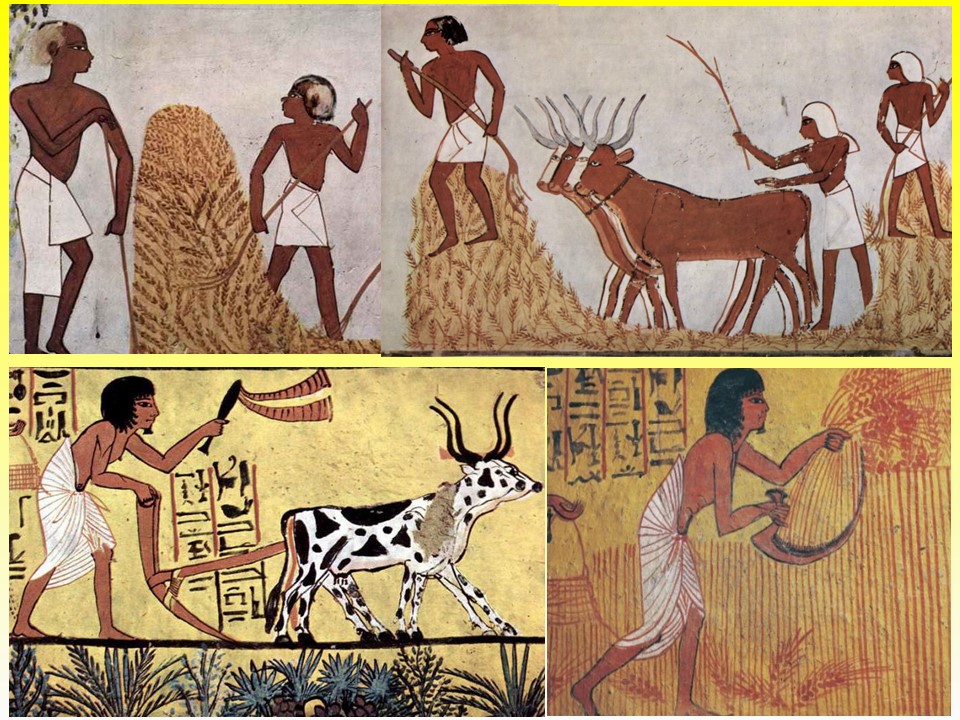
Боги древних египтян
Как все древние народы, сначала египтяне обожествляли животных. Наиболее почитаемым был бык, символ плодородия. В столице Египта Мемфисе был храм, посвященный священному быку Апису. Там жил реальный бычок, которого искали по всей стране по 29 особым приметам: характерным пятнам. Счастливчика помещали в храме, до смерти о нем заботились жрецы, а после мумифицировали.
Баранов тоже связали с плодородием, а еще с душой Ба. Эти слова выглядели одинаково. В Луксоре по обеим сторонам Аллеи сфинксов а Луксоре расположены бараны с закрученными рогами. Они считались вместилищами души бога Амона-Ра.
В Египте почитали и навозных жуков- скарабеев. Сегодня предполагают, что их появление весной из влажной земли воспринималось как знак весеннего возрождения природы, а тот факт, что они катили перед собой навозные шарики, связывал их с культом солнца. Впрочем, кто знает точно, как складывались эти культы? Сохранилось множество печатей, амулетов с изображениями скарабеев.
Почему египтяне почитали кошек, нетрудно догадаться: без этих прирученных ими зверьков крысы и мыши опустошали бы их амбары. Говорят, если начинался пожар, хозяин сначала спасал кошку, а потом все остальное. Когда домашняя любимица умирала, хозяева сбривали брови и соблюдали траур, пока брови не отрастут.
Обожествляли и крокодилов, ведь они жили в Ниле, и по их передвижению люди предсказывали разлив реки. Священных животных изображали на папирусах, в скульптуре, росписях гробниц, произведениях прикладного искусства.
Постепенно боги стали приобретать облик человека, однако чаще всего он имели голову животного. Почему? Возможно, человек и не мог видеть лицо бога, а еще говорят, что каждый бог мог превратиться в животное или птицу.
Так, главный бог Амон-Ра или Ра, бог Солнца, имеет тело человека и голову сокола. А на ней- головной убор в виде солнца, обвитого змеей. Считалось, что животные, растения — это слезы Ра. Днем он плыл на золотой ладье по небесному Нилу с востока на запад, а ночью — по подземному Нилу с запада на восток. С полуночи до рассвета он сражается со змеем Апопом, побеждает его, и вновь появляется на небе.
Голову сокола имел и Гор, бог небес и покровитель фараонов, которые считались проявлением Гора на Земле. Египтяне думали, что взгляд сокола парализует птиц так же, как лик фараона его врагов.
Говорили, что во время его путешествия по Небесному Нилу за спиной Ра стоял бог Тот, его изображали с головой ибиса. Говорят, египтяне давно заметили, что эта птица прилетает перед разливами Нила. Тот был покровителем писцов, создателем иероглифов, календаря, математики, астрономии. Он был секретарем Амона Ра.
Его женой была богиня правды и порядка Маат, дочь Ра. Ее изображают в виде женщины со страусиным пером на голове. Это перо играет решающую роль в суде Осириса. При определении судьбы умершего на одну чашу весов кладут сердце человека, а на другую — перо Маат. Если сердце легче, считалось, что человек чист. Если же сердце тяжелее, то душа съедалась богом Амат с головой крокодила, туловищем льва и бегемота.
В пантеоне египетских богов очень важен был Осирис. Писали, что сначала он был царем на земле и научил людей выращивать растения. Его брат Сет, которого связывают с силами тьмы, бог пустынь, решил погубить Осириса, заманил его в западню, убил, разрубил тело на 14 частей. Жена Осириса Исида нашла их, с помощью Анубиса, смогла ненадолго воскресить мужа. В это время родился их сын Гор, а потом Осирис вновь умер и стал царем подземного царства, где вершит суд, решая посмертную судьбу людей. Осирис, умирающий и воскресающий бог, считается и богом Нила, разливы которого связывают с воскресением бога.
Важной фигурой является и Анубис, бог с головой шакала, покровитель мумификаторов, проводник в царстве мертвых Египтяне постоянно изображали своих богов в скульптуре, настенных росписях, рисунках на папирусе. Вот некоторые.
Больше сведений о египетских богах найдете в презентации.
Вера в загробную жизнь и роль искусства
Египтяне придавали большое значение посмертному существованию человека. Они верили, что душа после смерти не покидает человека окончательно. Она состоит из нескольких частей. Среди них — Ка и Ба, которые заботились о человеке и после смерти. Ба представлялась в виде птицы с человеческой головой. А Ка — жизненная сила человека. Но чтоб Ка и Ба узнали тело, оно должно сохраниться. Отсюда обычай делать мумии. Для этого же создавали многочисленные изображения человека в виде статуй, росписей гробниц, масок и др.
Таким образом, искусство Древнего Египта в значительной мере связано с желанием сохранить земной облик человека. Не случайно в Египте скульптор назывался «творящий жизнь». Конечно, скульпторы и художники старались передать сходство, но это был не обыденный портрет — человек предстает перед богами, вечностью, поэтому художник подчинялся строгим канонам. Стиль изображения в египетском искусстве не менялся тысячелетиями. Если скульпторы изображали стоящего человека, то всегда левая нога вперед, голова высоко поднята, руки прижаты.
На рельефах и в настенных росписях голова и ноги изображались в профиль, а туловище — в фас. И дело не в том, что они не умели рисовать правильно. Тело более значительно выглядит в фас, а голова — в профиль. Изображая даже события обычной жизни, они вкладывали в него значение религиозного обряда.
Огромный период истории Египта от созданий первых династий фараонов до завоевания Египта персами в 525 году, а затем римлянами делится на 3 периода:
-
-
- Древнее царство — 3 тысячелетие до н.э.
- Среднее царство — 22-17 в.в.до н.э.
- Новое царство — 16-11 века до н.э.
-
Мы много знаем об истории древнего Египта благодаря тому, что уже в эпоху Древнего Царства там существовала письменность, до нас дошло довольно много надписей. Но египетские иероглифы много веков оставались тайной, пока в 1822 году Жан Франсуа Шампольон не сумел расшифровать первые иероглифы.
Древнее царство
Столицей Египта был Мемфис (он находился недалеко от современного Каира). На месте бывшей столицы ведутся раскопки, а рядом — самые грандиозные усыпальницы всех времен и народов — знаменитые египетские пирамиды. Они тянутся на несколько десятков километров. Особенно грандиозны пирамиды трех фараонов Древнего царства: Хуфу — Хеопса (146 м), Хафра — Хефрена и Микерина. Пирамида Хеопса сделана из 2 3000 000 каменных плит, весом больше 3 тонн каждая.
Говорят, даже сегодня в мире есть всего 2 крана, которые смогли бы поднять эти плиты. А если учесть, что в то время из металлов была известна только медь, неясно, как могли обработать такое огромное количество камня. Рядом с пирамидой Хефрена находится высеченное из цельной скалы изображение Сфинкса высотой в 20 м. Его голова в 30 раз больше человеческой, а длина туловища 57 м. О нем тоже много легенд. Говорят, юный Тутмос, охотясь, уснул у подножья Сфинкса. Во сне Сфинкс просил расчистить его от песка, обещая за это сделать фараоном. Есть гипотеза, что Сфинкс древнее пирамид.
Труд художника в Египте считался священным, скульпторы, архитекторы, живописцы были высокопоставленными людьми, порой жрецами. В рельефах и статуях Древнего царства — мощь и величие. Хефрен изображен сидящим на троне, украшенном тростником и лотосом, символами северного и южного Египта, на плече — сокол, символ бога Гора. Сделана статуя из очень твердого камня — диорита.
Однако известны статуи не только фараонов. Одним из шедевров Древнего царства является статуя писца Каи. Статую нашли в конце 19 в. Когда арабы вошли в гробницу, они увидели сверкающие глаза, решили, что это дьявол, и в ужасе разбежались. Белки были сделаны из непрозрачного кварца; роговица – из хрусталя. Статуя Каапера, которую прозвали Сельский староста, так как рабочем, нашедшим его он показался похожим на их старейшину, была сделана примерно в 2500 г. до н.э из дерева сикомора. Глаза у него тоже из горного хрусталя. Говорят, что он был жрецом и писцом. Во всяком случае, у него была своя гробница.
Искусство Среднего царства.
Среднему царству предшествовали нашествия чужеземцев, временный распад государства. А когда Египет оправился от потрясений, жизнь в нем изменилась. Отныне фараоны не будут строить грандиозных каменных пирамид. Их будут делать из необожженного кирпича. Зато сохранятся статуи фараонов, которые теперь предназначены не только для гробниц. Их устанавливают в храмах, фараону молятся, как божеству. Пирамиды строят теперь не только для фараонов. Сохранились росписи гробницы вельможи Хнумхотепа.
В эпоху Среднего царства впервые стали говорить, что человек, вступая в загробный мир, должен предстать перед судом Осириса, покровителя мертвых интересно, что тогда стали сомневаться в загробной жизни, о чем дошли свидетельства на одном из папирусов. В математике успешно вычислялась поверхность шара. В медицине установили роль человеческого мозга. В это время стали использовать орудия из бронзы, что позволило повысить эффективность сельского хозяйства.
Искусство Нового царства.
Среднее царство рухнуло так же, как и Древнее. Причиной этого были как внутренние раздоры, так и нашествие азиатских кочевников. Лишь в 1560 г до н.э. целостность страны была восстановлена. При Тутмосе Третьем Египет стал государством, про которое говорили, что там «золото что пыль». С пирамидами было покончено. Фараонов тайно хоронили в пещерах Долины мертвых, что все же не спасало их от разграбления.
А символом величия фараонов стали храмы в честь верховного бога фаюмской династии — Амона Ра. Самыми грандиозными постройками Нового царства считаются храмы Луксор и Карнак. Главный зал Карнака украшают 134 колонны высотой до 23 м. Храмы соединяет аллея сфинксов длиной 2,5 км.
Но художники Нового царства умели создавать не только грандиозные храмы, но и хрупкие изящные статуэтки. В них нет тяжеловесности и бесстрастности древних статуй. Особенно большие изменения в искусстве произошли во время царствования фараона Эхнатона. Этот фараон — фигура необычная. Он попытался отойти от древней религии с ее культом множества богов. Он провозгласил, что отныне все будут поклоняться одному богу Атону солнечному диску, единому для всех народов. Конечно, он восстановил против себя всех жрецов, которые не хотели никаких перемен. А союзниками его стали сравнительно бедные люди. При Эхнатоне в искусстве Египта появились чувства — печаль покорность судьбе, любовь. Есть изображения самого Эхнатона, обнимающего жену и ласкающего ребенка. Самыми известными произведения искусства царствования Эхнатона стали портреты его жены Нефертити.
Портрет царицы Нефертити в высоком головном уборе работы скульптора Тутмоса – одно из самых известных женских изображений всех времен и народов. Оно хранится в Берлине. После смерти Эхнатона египтяне снова вернулись к старой вере, но благодаря ему искусство стало теплее, человечнее. Об искусстве после Эхнатона можно судить по предметам, найденным в гробнице Тутанхамона. Мы говорили, что гробницы чаще всего разграфлялись, но в 1922 весь мир облетела сенсационная весть: археолог Картер в Длине царей нашел тщательно спрятанную гробницу Тутанхамона. Там был похоронен совсем юный фараон. Но роскошь этой гробницы поражала воображение. Мумия Тутанхамона находилась в гробу, сделанном из листового золота толщиной 3 мм. Но добраться до нее удалось лишь на 4 год раскопок.
Для того, чтоб переписать, предохранить от разрушения все, что находилось в 4 комнатах гробницы, потребовалось 7 лет. Прежде, чем подойти к гробу, надо было разобрать 700 драгоценных вещей, которые не давали к нему приблизиться. Сам гроб находился в 7 футлярах. Любопытно, что самые дорогие амулеты были сделаны из железа, которые тогда ценились дороже золота. Там было все, что надо для загробной жизни, поражало не только большое количество золота, но красота предметов, найденных там. На спинке золотого трона Тутанхамона он изображен со своей женой. Их позы непринужденны, они смотрят друг на друга.
Перед вами игра, в которую вы можете поиграть онлайн. Выберите из трех вариантов ответа правильный, а потом нажмите на галочку справа. Если у вас видны не все вопросы, перейдите в полноэкранный режим.
А вот вопросы викторины «Люди и боги Древнего Египта».
-
-
- Египтяне считали, что страна мертвых находится на (западе, востоке севере)
- Когда египтяне делали мумию, они вынимали все органы, кроме (мозга, сердца, печени)
- Чудовище Амат, поедающее сердца грешников, имеет голову (крокодила, льва, бегемота
- Земным воплощением бога Птаха, был (скарабей, бык, собака)
- Разлив Нила длился 4 месяца, а начинался он (в марте, июле, сентябре_
- Разливу Нила предшествовало появление на востоке (пыльной бури, звезды Сириус, стай саранчи
- Все фараоны носили накладную бороду, как у бога (Ра, Осириса, Амона)
- Когда кошка умирала в Египте, хозяин, демонстрируя свою скорбь (5 дней не ел, сбривал брови, надевал черную одежду).
- Египтяне считали, что душа живет (в голове, сердце, пятках)
- Богиня справедливости Маат носила на голове перо (лебедя, страуса, павлина).
- Мифы говорят, что он был первым царем Египта и научил людей обрабатывать землю и делать вино, но был убит своим братом. (Сет, Осирис, Амон)
- Клеопатра – последняя царица Египта была (египтянка, гречанка, жительница Вавилона).
- Их считали добрыми духами жилища и верили, что душа умершей хозяйки дома, вселяется в них (коровы, кошки, собаки)
- Исида — самая почитаемая богиня. Египтяне верили, что Исида наказывает (воров, неверных жен, обманщиков).
- Арабы говорили: «Все боится времени, а время боится (пустыни, сфинкса, пирамид)
- Разные животные обожествлялись египтянами за какую-либо заслугу. За что почитали ибиса? (красиво пел, ел саранчу, предупреждал об опасности)
- Что происходило в Египте, когда богиня Исида плакала по своему убитому мужу Осирису?
- (наступала засуха, начинался сезон дождей разливался Нил).
- Какой самый ценный трофей захватили в верховьях Нила египтяне, завоевавшие Нубию (слитки золота, семена пшеницы, кошек).
- Бесстрашные египетские воины бежали от азиатов-гиксосов, напуганные неизвестными животными. Кто это был? (лошади, слоны, жирафы)
-
Если вы хотите скачать презентацию, пройдите по ссылке: https://drive.google.com/file/d/1yHhTJ6Ai00gDziVOCOKtc-P_yCMFIHpT/view?usp=sharing
О жизни египтян в древности вы можете прочесть в материале «Экскурсия в Древний Египет», пройдя по ссылке: Каир — дорога к пирамидам

































































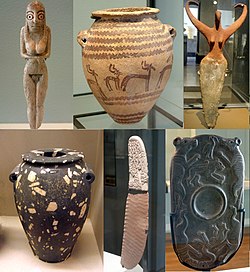

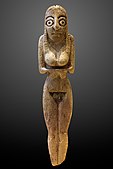









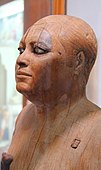


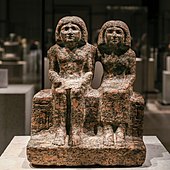
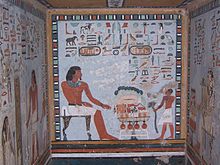

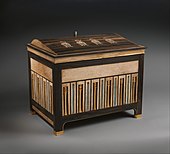
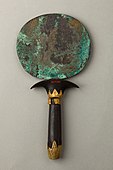
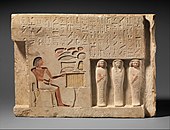


![Electrum dagger handle of a soldier of Hyksos Pharaoh Apepi, illustrating the soldier hunting with a short bow and sword. Inscriptions: "The perfect god, the lord of the two lands, Nebkhepeshre Apepi" and "Follower of his lord Nehemen", found at a burial at Saqqara.[45] Now at the Luxor Museum.[46][47]](https://upload.wikimedia.org/wikipedia/commons/thumb/b/b3/Hyksos_dagger_handle.jpg/170px-Hyksos_dagger_handle.jpg)
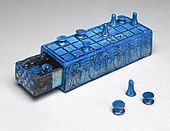


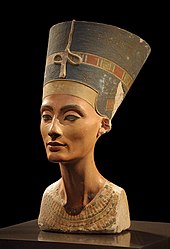
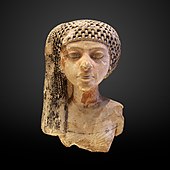
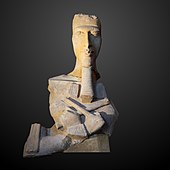




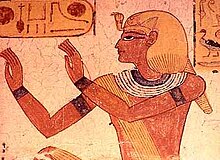

![Monumental column elevated by the "Black Pharaoh" Taharqa in Karnak[62]](https://upload.wikimedia.org/wikipedia/commons/thumb/f/f6/Karnak_R03.jpg/102px-Karnak_R03.jpg)
![Taharqa offering wine jars to Falcon-god Hemen;[62] 690–664 BC; bronze, greywacke, gold and wood; length: 26 cm, height: 19.7 cm, width: 10.3 cm; Louvre](https://upload.wikimedia.org/wikipedia/commons/thumb/6/6c/Taharqa_offering_wine_vases_to_Hemen-E_25276-IMG_0506-gradient.jpg/170px-Taharqa_offering_wine_vases_to_Hemen-E_25276-IMG_0506-gradient.jpg)

![Egyptian man in a Persian costume, c. 343–332 BC, accession number 71.139, Brooklyn Museum.[66]](https://upload.wikimedia.org/wikipedia/commons/thumb/b/bd/Egyptian_Man_in_a_Persian_Costume%2C_ca._343-332_B.C.E.%2C_71.139.jpg/127px-Egyptian_Man_in_a_Persian_Costume%2C_ca._343-332_B.C.E.%2C_71.139.jpg)
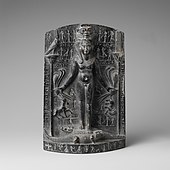





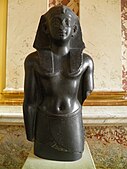





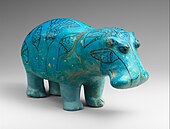

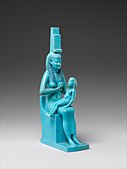





















![Kamose stela; circa 1550 BC; limestone; height: 2.3 m, width: 1.1 m, depth: 28.5 cm; from the Karnak Temple (Egypt); Luxor Museum (Luxor, Egypt)[102]](https://upload.wikimedia.org/wikipedia/commons/thumb/4/49/Kamose_Siegesstele_Luxor_Museum_02.jpg/89px-Kamose_Siegesstele_Luxor_Museum_02.jpg)

